
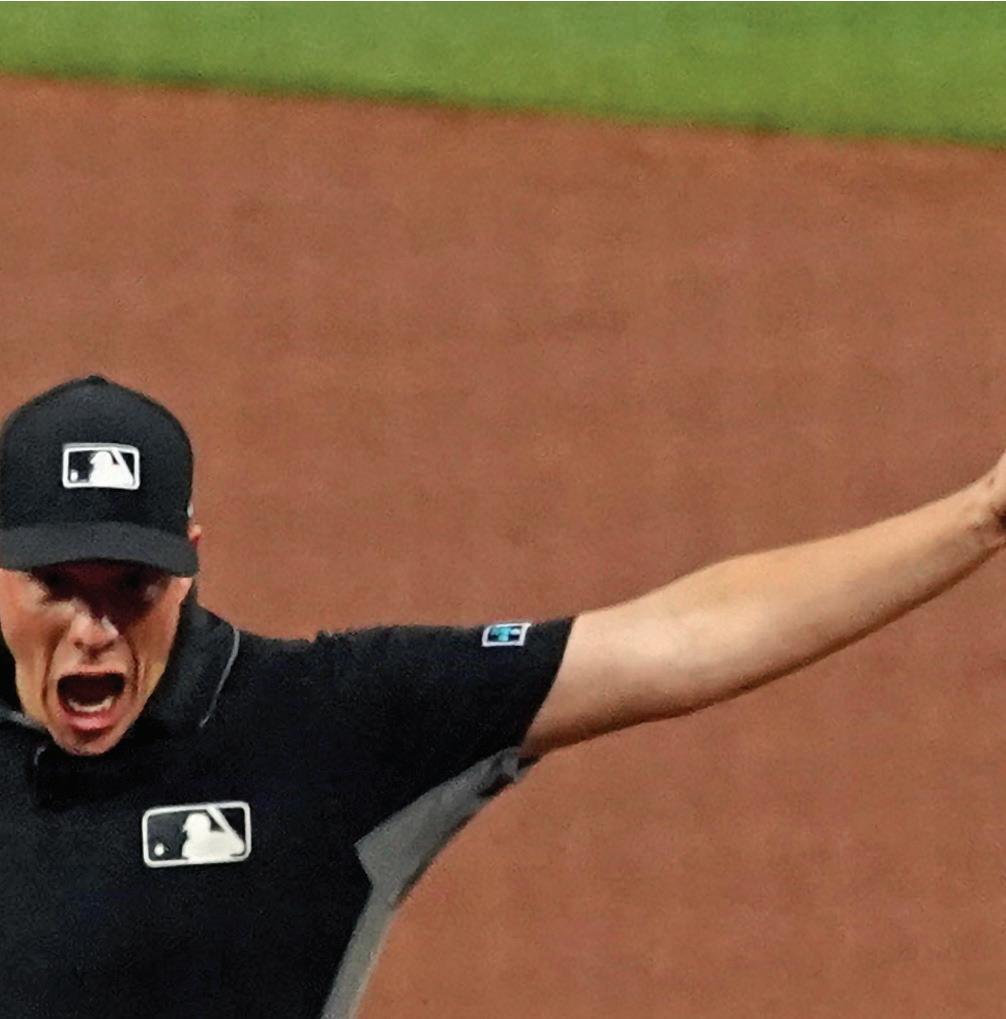



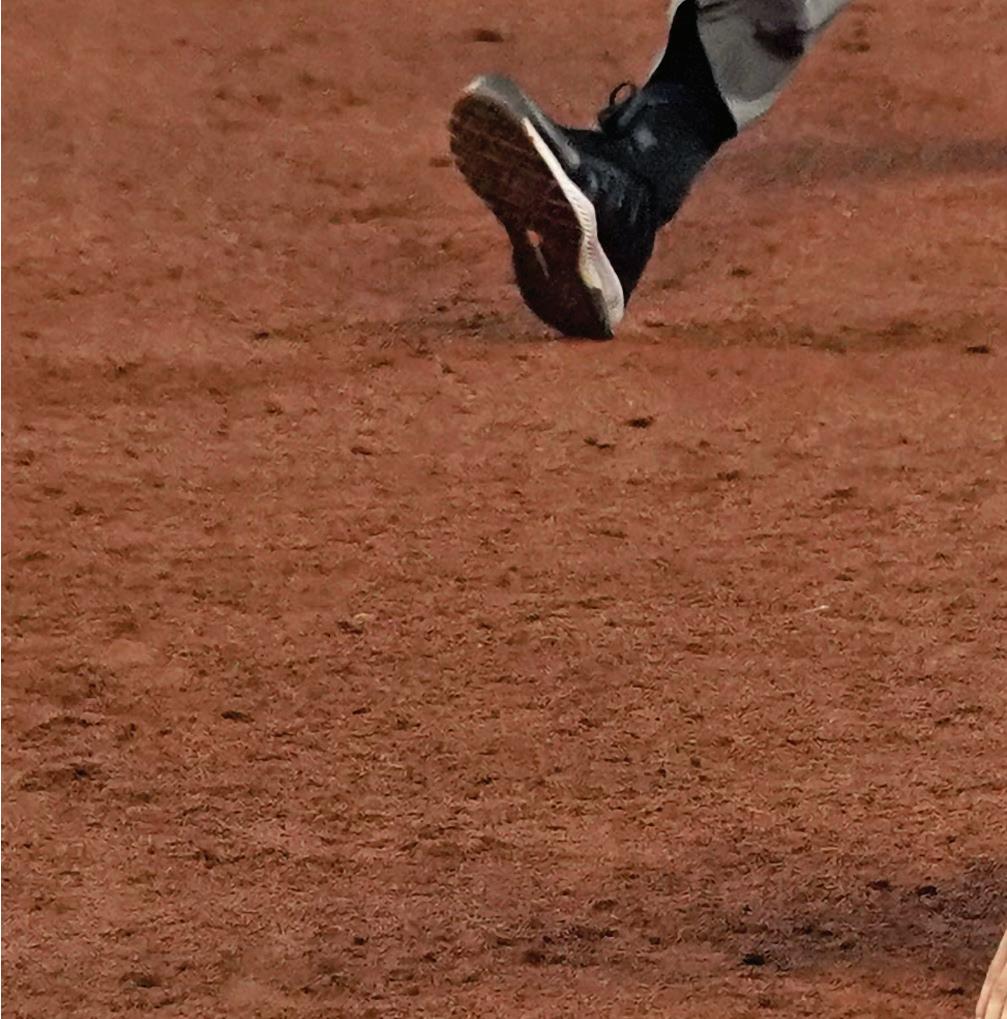
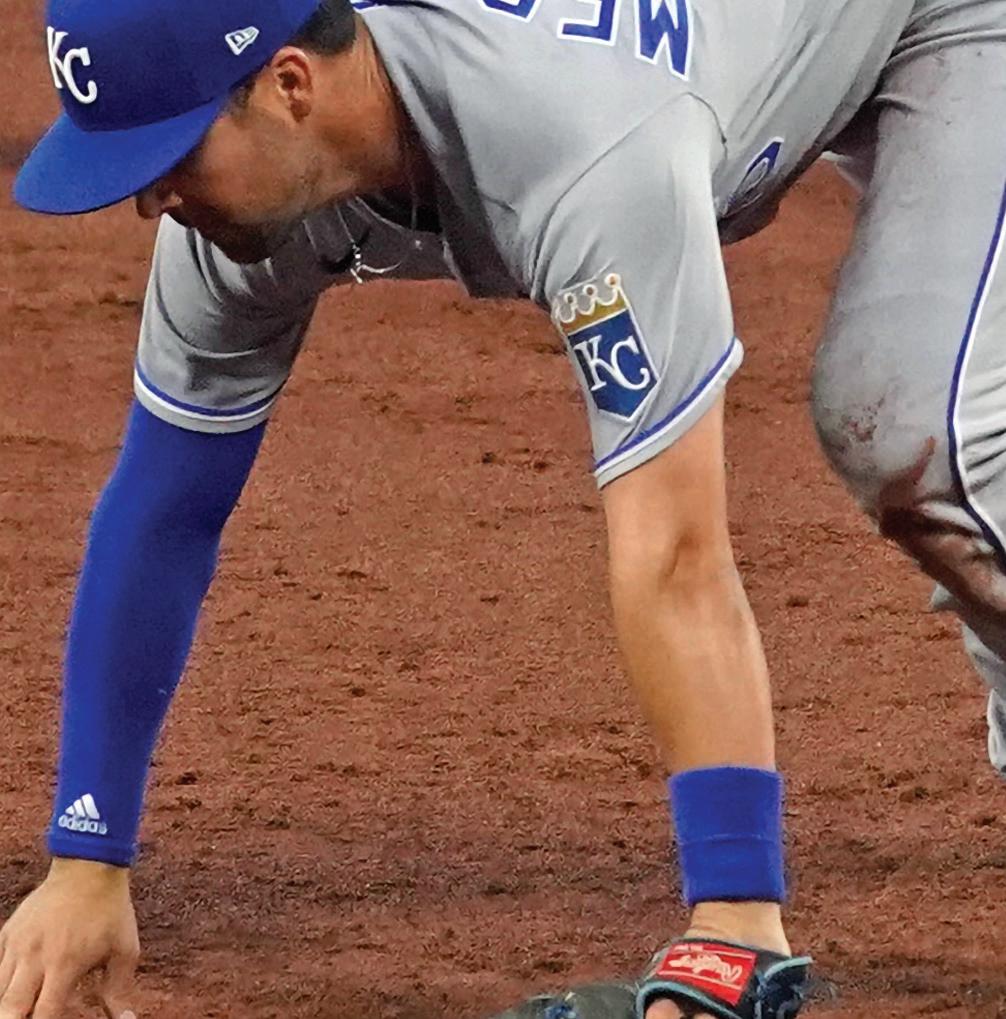
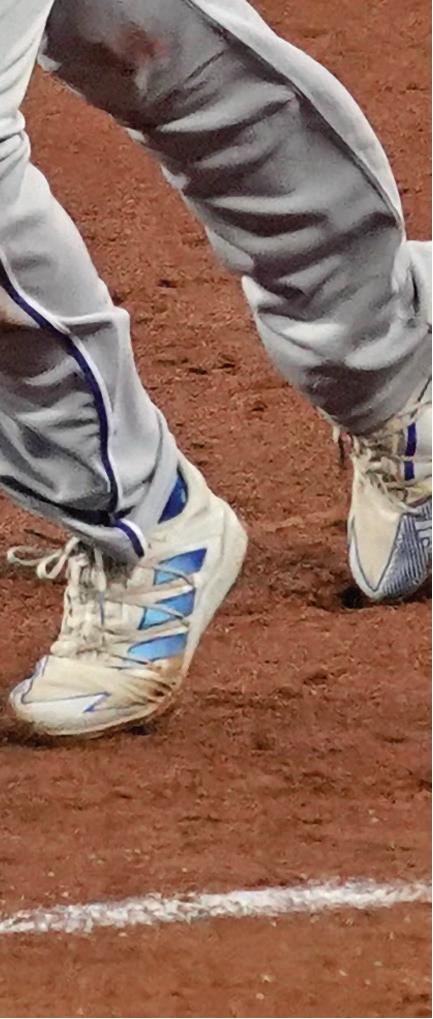







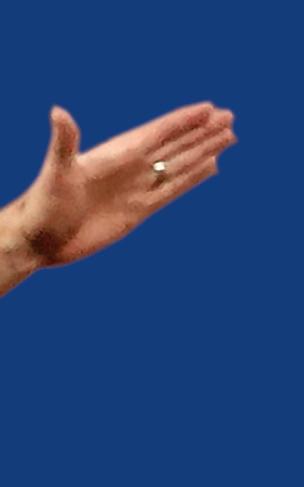
























VOLLEYBALL NCAA LIMITS BBW FOOTBALL AT TIMEOUTSCHANGES DANCE TRICKSRULES AUGUST 2022 // REFEREE.COM your voice since 1976 $6.95member edition FIRST AID BASEBALL THESE ARE REAL AWAY GAMES GAME FEE OR HOURLY RATE? P.72 P.34 GOLD WHISTLEAward JOAN POWELL DO YOU MIND? P.52

20 GOLD WHISTLE
AWARD: JOAN POWELL
Longtime volleyball officiating coordinator is an optimist, builder and mentor.
34 REFEREE ABROAD
A program giving soccer referees priceless experiences.
52 GET YOUR MIND RIGHT
Top-tier mental performance is achieveable if you put your mind to it.
72 WHAT IS OUR HOURLY RATE?
The CIF Southern Section moves to an officiating pay rate that targets $35 per hour.
ON THE COVER
Stu Scheurwater Regina, Saskatchewan
Age: 39
Occupation: MLB umpire
Officiating experience: Began professional umpiring career in 2007; made MLB umpiring debut in April 2014; hired to full-time MLB umpiring staff prior to 2018 season; worked 2020 NL Wild Card game and NL Division Series.

SPORTS
12 FOOTBALL
Block Buster: NCAA Makes Major Change to Blocking

Below the Waist Rule; Never Forget This ‘Always’; Returned to Sender; 5MW: Tom Quick
26 VOLLEYBALL
Use Them or Lose Them: Engage Line Judges and Keep Them Focused on the Match; Catch Timeouts as a Team; Are You Up to the Challenge?
38 SOCCER
It’s the (New) Law: Substitution Opportunities Expanded for IFAB Play in 2022-23; Overtime Nixed for NCAA Regular Season Play
44 SOFTBALL
Lineup Logistics: Know the Differences in Card Infractions; When Infield Fly and Interference Collide; Block Charges
58 BASKETBALL
Approved to Adorn: NFHS Alters Guidelines for Hair Beads, Barrettes; Hone Your Way to a Smoother Game
64 BASEBALL
‘Feel It’ at First Base: Let the Action Guide You to the Proper Mechanic on Force Plays; Careful With the Chitchat; Conducting the Obstruction Orchestra
74 ALL SPORTS
Say When: Timeout to Talk?
Choose Moments (and Words) Carefully; Dressed for the Occasion: Arrival Apparel Counts, Too
COLUMNS
4 PUBLISHER’S MEMO
Those Laws Refined
6 THE GAG RULE
Snap Shot; They Said It; They Like Us; They Get It
8 THE NEWS
Basketball Referee Brutally Attacked; Six Women Named World Cup Officials; Collins Steps Down From NCAA Men’s Hoops Post

50 GETTING IT RIGHT
History Made in Virginia; Ingish Earns Kohl Award; Ballard’s Busy Day
70 PROFILES
Weather on TV or on the Field, He Loves His Work; Stating His Case; Early Starter
78 FOR THE RECORD
2022 WNBA Officiating Roster
80 LAW
Outside Court Boundaries; Five Reasons Courts Should Not Reverse Officials’ Calls
81 CLASSIFIEDS Camps/Clinics/Schools; Equipment/Apparel; Leadership Resources


82 LAST CALL
Would You Hire You? Being honest with yourself is the first and most difficult step in this time of reflection and evaluation.
FOOTBALL HIGHLIGHT THIS
The penalties related to targeting are among the NCAA football changes for the 2022 season.
CONTENTS Find Referee Magazine on Facebook and follow RefereeMag on Twitter Volume 47, No. 8 Issue 550 AUGUST 2022 FEATURES
ISAIAH DOWNING (POWELL), THOMAS CAMPBELL/USA TODAY SPORTS (FOOTBALL )
20
MONTH FOR MORE, GO TO PAGE 12
Those Laws Refined
In the May 2013 issue, I used this space to posit “immutable laws” regarding the endeavor of officiating. During the past nine years, I’ve reflected upon them. Now, in these times, I felt a need to offer them again, updated. I believe they serve us even better today.
1. The Law of Respect. There are those who deserve receiving the benefit of the doubt from you. This should be a “gift” to be earned, not dispensed gratuitously.
2. The Law of Response. When asked a question, if you choose to answer, do so tightly. Don’t answer a question for which you do not have credible information. Answer questions not statements.
3. The Law of Deference. Speak with courtesy. Your point will carry double its weight. If you are slapping them with your words, they can’t be clearly heard.

4. The Law of Threats. Showdowns lead to showups. In either case you will come out on the short end of the interchange. When you threaten someone, you are bargaining from the position of weakness.
5. The Law of Belief. The best you can do is to call what you believe you see. Absent that, you are guessing. If technology is an approved tool, use it to benefit the game.
6. The Law of Candor. Mistakes are made. The acceptance of this fact and the corollary of its admittance and administration should force you to some humbleness. This isn’t new territory for us anymore. The book of officiating is no longer a private read, especially in its widespread digital form.
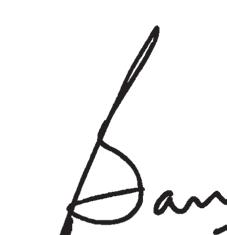
7. The Law of the Ladder. It is all about not making things worse. Seldom will you get the toughest, richest assignments because you scored 100 percent on your test. You will get them because the assigner/coordinator believes you will not make things worse.
8. The Law of Adaptation. When your horse dies, get off. If your approach to the game seems to result in less-than-satisfactory results, your methods have to change. You have to change before your results will change. You might believe that “others” have to do the changing, but that is primarily a self-deception, a diversion.
9. The Law of Eavesdropping. When you put words into the digital realm, you own them, and for a very long time.
10. The Law of Ownership. You will be presumed arrogant. That is because you own the whistle. Powerful piece that whistle. Your words and deeds must always define a less arrogant you.
11. The Law of Wholeness. Every assignment is more than the game itself. It is a mosaic of responsibilities. With each piece of that mosaic comes the opportunity to enhance your stature as an official or exasperate those who are trying to rely on you. From acceptance/ confirmation through game-report filing, from arriving at the site to leaving the area, your professional, thoughtful best is required.
12. The Law of Cleanliness. If you have to think whether something might be a conflict of interest, consider it so. One breath of scandal freezes much honorable sweat.
13. The Law of Skipping It. If you are an official, the use of social media to offer personal opinions on matters of officiating comes with serious responsibilities, minefields. It is far easier to make things worse than better. Context matters and social media has little room for context. Good rule of thumb? Skip it.
14. The Law of Memory. The older you get, the better you were. Ever notice that with each telling of tales we ourselves become better and better officials? Memory is such a wonderful evaluation enhancer.
Chief Strategy Officer/Publisher
Barry Mano
Chief Operating Officer/Executive Editor
Bill Topp
Chief Marketing Officer
Jim Arehart
Chief Business Development Officer
Ken Koester
Managing Editor
Brent Killackey
Assistant Managing Editor
Julie Sternberg
Senior Editor
Jeffrey Stern

Associate Editors
Brad Tittrington Scott Tittrington
Copy Editor
Jean Mano
Director of Design, Digital Media and Branding

Ross Bray
Publication Design Manager

Matt Bowen
Graphic Designer
Dustin Brown
Video Coordinator
Mike Dougherty
Interactive Media Developer Michael Kielas
Comptroller
Marylou Clayton
Data Analyst/Fulfillment Manager
Judy Ball
Account Manager
Joe Jarosz
Director of Administration and Sales Support Cory Ludwin
Office Administrator
Garrett Randall
Customer Service Support Specialists
Michelle Murray
Lisa Burchell
Editorial Contributors
Jon Bible, Mark Bradley, George Demetriou, Alan Goldberger, Judson Howard, Peter Jackel, Luke Modrovsky, Steven L. Tietz, Tim Sloan
These organizations offer ongoing assistance to Referee: Collegiate Commissioners Association, MLB, MLS, NBA, NCAA, NFHS, NISOA, NFL, NHL, Minor League Baseball Umpire Development and U.S. Soccer. Their input is appreciated.
Contributing Photographers
Ralph Echtinaw, Dale Garvey, Carin Goodall-Gosnell, Bill Greenblatt, Jann Hendry, Jack Kapenstein, Ken Kassens, Bob Messina, Bill Nichols, Ted Oppegard, Heston Quan, Dean Reid, VIP
Editorial Board
Mark Baltz, Jeff Cluff, Ben Glass, Reggie Greenwood, Tony Haire, John O’Neill, George Toliver, Ellen Townsend
Advertising
2017 Lathrop Ave., Racine, WI 53405
262-632-8855 advertising@referee.com
REFEREE (ISSN 0733+1436) is published monthly, $46.95 per year in U.S., $81.95 in Canada, Mexico and foreign countries, by Referee Enterprises, Inc., 2017 Lathrop Ave., Racine, WI 53405. Periodical postage paid at Racine,
PUBLISHER’S MEMO Watch the video at referee.com/pubmemo 4 | REFEREE August 2022
Phone:
WI and at additional mailing offices. Postmaster: Send address changes and undeliverables to REFEREE, PO Box 319 Congers, NY 10920. Direct subscription inquiries, other mail to REFEREE, PO Box 319 Congers, NY 10920. 1-800-733-6100. © 2022 Referee Enterprises, Inc. All rights reserved. (USPS Publication #107790.) Subscribers: Send address changes to REFEREE, PO Box 319 Congers, NY 10920.
FEATURING THE LATEST FOOTBALL PRODUCTS MADE BY SPORTS OFFICIALS
GOOD CALL OFFICIATING DOWN & BALL SPOT INDICATOR
THE CLASP FOOTBALL PENALTY FLAG CLIP




This is a must-have for the football o cial working as the Umpire (U) or the Center Judge (C). Never wear two down indicators again! Designed with referees & umpires in mind, this modification to a traditional down indicator includes a horizontal ball spot position indicator.
REVIEWS





SMITTY V2 BLACK & WHITE UMPIRE / REFEREE FIELD SHOES
Has your flag fallen out while running? Are you constantly checking to see if it’s in place? The Clasp, a revolutionary new accessory for football o cials, fixes those problems. Simply clip it to your belt and securely tuck your penalty flag into place.


OFFICIAL REVIEWS



FOOTBALL REFEREE
PENALTY SIGNAL & YARDAGE CARD BY WILLIAMS
The Smitty V2 Black & White Field Shoes have advanced features and benefits geared specifically for the demands and needs of outdoor sports o cials.

The Williams Penalty CardTM is a valuable tool meant to help youth, high school and college football o cials of all experience levels know the proper signal and yardage for assessing penalties. Use it as a reference or as an in-game tool.


OFFICIAL
Preferred vendor
OFFICIAL REVIEWS OFFICIAL REVIEWS
SNAP SHOT
Difference of Opinion
The ball assistant indicates the kick was no good, but we’re going with the call of official Pete Zapata. The action occurred last season when Zapata, from Battle Creek, Mich., was working a Michigan High School Athletic Association state championship game at Ford Field in Detroit.
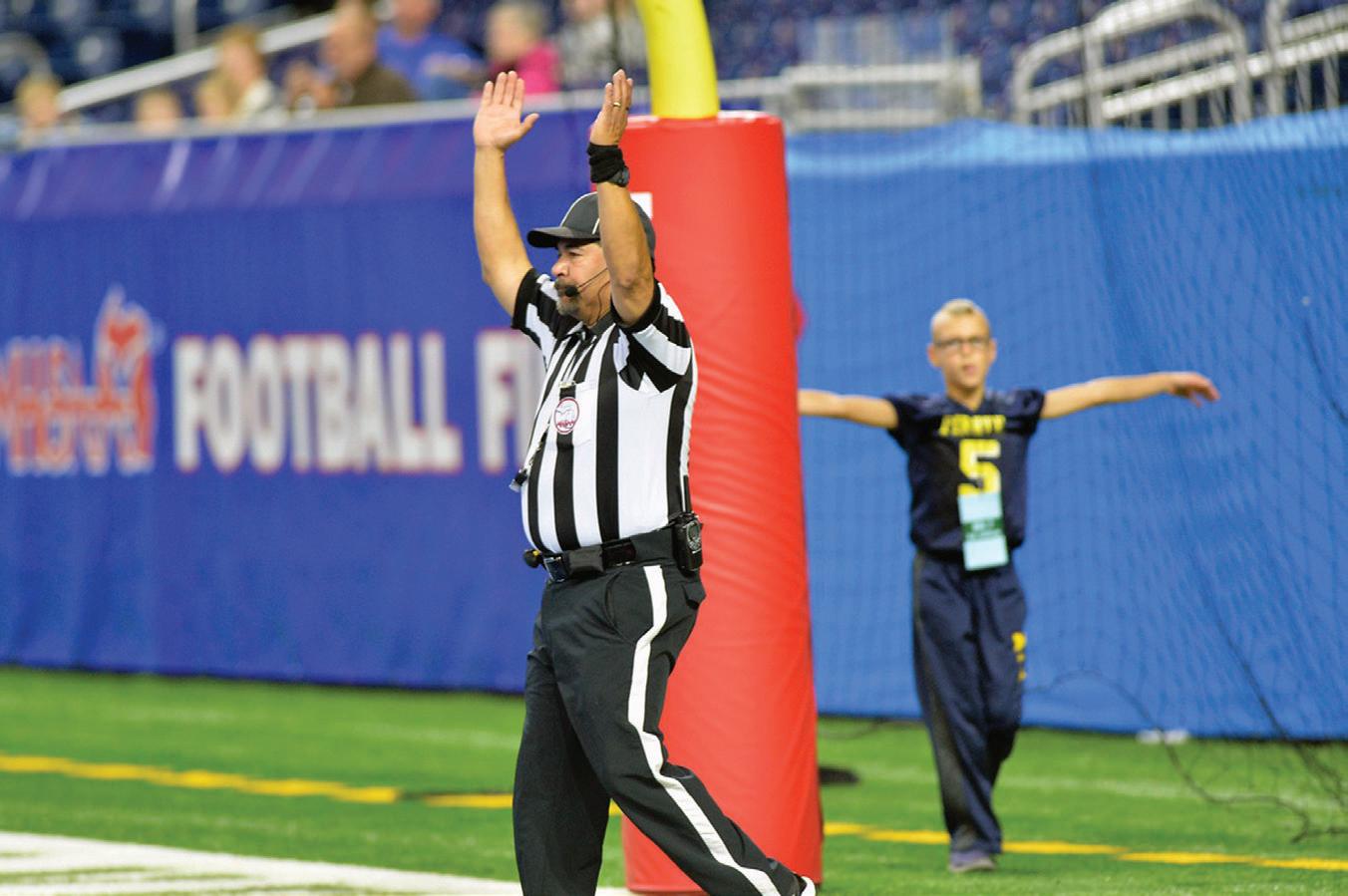
THEY SAID IT
“According to the rulebook, arguing with the umpire is illegal. So, why do umpires permit it? We let the players sound off because the fans pay to see their favorites play. But when they go too far, we have to thumb them out or risk losing control of the game. I’m an easygoing guy. I like to let the player hang himself. He usually will.”
— MLB umpire Larry Goetz, in a 1954 issue of Sports Illustrated, when asked, “Should a baseball player or manager argue with the umpire?”
media members
on competition committees?


THEY GET IT
“I think that (referees) have given me a deeper understanding of just how much thought and care goes into the job of every single official. They all have to be Yoda while a burning inferno of Sith are rising around them, if we want to get really deep into a ‘Star Wars’ analogy. They have to be Zen, right? They have to be so technically sound, and they have to do it with the best athletes in the world in a split second.”
— Ryan Ruocco, who broadcasts NBA and WNBA games
THEY LIKE US
“Youth sports parents have to do better. One solution: When parents are abusive, take away their privilege of watching their kids play youth sports. … To make this work, everyone — from the major leagues down through state associations and local clubs and government — needs to adopt a standard of zero tolerance. And then they have to enforce the rules and laws.”
— Op-ed piece by Tribune News Service writer Ben Sherwood

HWA PHOTOS
SOURCE: ESPN.COM
SOURCE: REFEREE SURVEY OF 95 OFFICIALS Should
be
35.8 % YES 64.2 % NO THE GAG RULE WHAT PEOPLE ARE SAYING 6 | REFEREE August 2022 Tell Us What You Think Send email to letters@referee.com Send letters to: Editor, Referee, 2017 Lathrop Ave. Racine, Wis. 53405 Opinions expressed in “The Gag Rule” are not necessarily those of Referee. Unless otherwise stated, letters sent to Referee are intended for publication and become the property of Referee



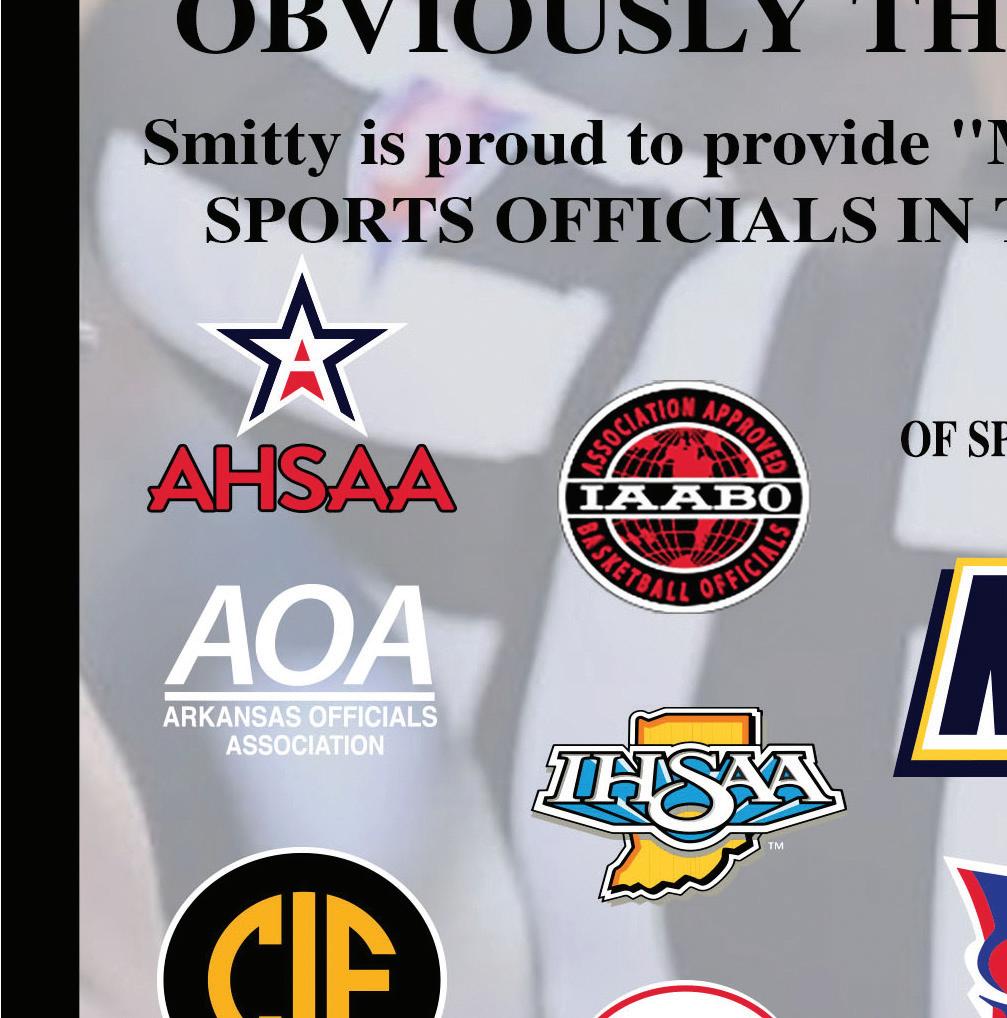





Basketball Referee Brutally Attacked
LAS VEGAS — A Las Vegas basketball referee, trying to prevent a physical altercation between a fellow official and irate coach, became the victim of a brutal assault after a recreational basketball game between teenagers at the Doolittle Community Center on May 17.
Perry Woodward had completed his games for the evening and decided to check on an adjoining court to see how one of his fellow officials was doing. When that game ended, Woodward noticed a coach aggressively questioning fellow official Shawn Rowe about calls made during the game.
Gym workers asked the coach to leave, but the coach and his wife followed the officials to the door. After waiting a few minutes to allow cooler heads to prevail, Rowe and Woodward left to go to the parking lot to get into their cars. The coach, his wife and their teenage son got into Rowe’s face in the parking lot.
Woodward stepped in to try to calm the situation and was instead sucker punched in the back of the head and then his face. He was knocked out and hit the ground. Woodward was taken to University Medical Center and treated for a concussion, bleeding on the brain, sutures on his chin and forehead,
five fractured teeth, neck bruising and a left ankle fracture.
“I was unconscious for 15 to 30 minutes,” Woodward told the Las Vegas Sun. “I was told I was dead.”
Doctors said Woodward is lucky to be alive and had to undergo more surgery to repair his fractured ankle.
“We have constant threats towards us all over town doing games,” Vince Kristosik, president of the Southern Nevada Officials Association, told Fox 5 Vegas. “But to see this kind of violence to an official, it’s hard for me to find a story where this much physical injury occurred to someone who was here to officiate a game.”

The father was charged with battery on a protected person and the wife and son are facing a misdemeanor battery charge.
A GoFundMe account was set up to offset Woodward’s medical bills, with a goal of raising $25,000. As of press time, the fund had raised $8,105. Woodward is a 20-year veteran official and recently worked a Nevada high school state championship game.
“I just can’t believe what society is about these days and people taking a game to this level of craziness,” Woodward told the Sun. “I am going to be better. I am going to be all right. But why would anyone put themselves in harm’s way like that?”
Six Women Named World Cup Officials
Five U.S. soccer officials were named as match officials for the FIFA World Cup Qatar 2022, including one assistant referee who was among six female officials appointed — a first for the men’s event.
The U.S. officials included referee Ismail Elfath, assistant referees Kyle Atkins, Kathryn Nesbitt and Corey Parker as well as video match official Armando Villarreal.
A total of 36 referees, 69 assistant referees and 24 video match officials were selected to officiate the World Cup, which runs from Nov. 21 to Dec. 17 in the Middle Eastern nation of Qatar.
The six women who will be making history as World Cup officials include: referees Stéphanie Frappart from France, Salima Mukansanga from Rwanda and Yoshimi Yamashita from Japan, and assistant referees Neuza Back from Brazil, Karen Díaz Medina from Mexico and Nesbitt.
See “World Cup” p.10

THE WIRE
Umpire Issues Apology for Ejection
MLB umpire Dan Bellino issued an apology for ejecting Arizona Diamondbacks pitcher Madison Bumgarner in the first inning of a May 4 game against the Miami Marlins.
“When I began my MLB career almost 15 years ago, I received some good advice,” Bellino said in a statement to ESPN’s Jesse Rogers two days
later. “I was told to umpire every game as if my children were sitting in the front row. I fell short of those expectations this week. While I can’t go back and change what happened, I take full accountability. I will learn from this incident, and I sincerely apologize.”
The ejection came during a routine check of hands and gloves; Bellino gave Bumgarner an intense stare, presumably upset with Bumgarner’s
complaints about calls that inning by the call-up umpire behind the plate. Bumgarner responded with profanity directed at Bellino that prompted an ejection.
Quebec Teen Referee Attacked
A grandfather of a player at a U-14 game hit a 17-year-old referee during a May 7 match in suburban Montreal. Video of the incident showed the man come out of the stands and bump
the referee, who pushed him away. Then the man punched the referee before other adults intervened and knocked the attacker to the ground. Soccer Canada, which condemned the incident, later released a letter of apology written by the grandfather and former teacher, who was not identified. “I’d like to apologize to everyone who witnessed this moment of distraction that lacked civility and courtesy and set an example of
THE NEWS
8 | REFEREE August 2022
THANK YOU TO OUR SUMMIT SUPPORT

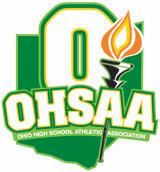



ORGANIZATIONS LISTED IN ALPHABETICAL ORDER OFFICIATING DEPARTMENT 2022
Collins Steps Down From NCAA Men’s Hoops Post
J.D. Collins has been blessed in his professional life to travel the roads he wants to instead of those he necessarily has to.
Now, after seven years as the NCAA men’s basketball officiating coordinator, he wants to take a break and figure out what life away from the pressure-packed world of big-time college athletics has to offer.
Collins, 59, announced in May his decision to retire from the NCAA coordinator post, effective Oct. 31. He assumed the position in May 2015, taking over for John Adams after working 18 years as an on-floor D-I official and spending five years coordinating men’s basketball officiating for the Mid-American Conference and the Summit League.

“I’ve got about eight or 10 reasons, but at the end of the day two converge,” said Collins about why he’s choosing to step away. “I think I’ve taken the position about as far as I can take it, and I think it’s time for someone else to come in with new approaches, new ideas and new passion.
“I’m going to turn 60 this fall. I want to enjoy life. So those two things balance together, and I think it’s time.”
Asked to name what gives him the
THE WIRE
violence that was completely against my own values,” the letter stated. The referee and his family were considering whether to file a complaint with the police.
Lackawanna League Umpires in Pay Dispute
A group of Pennsylvania umpires stopped working games for
most satisfaction from his time in the leadership role, Collins did not point to any one decision or event, but instead reflected on his tenure as a whole.
“I think that the culture of college basketball officiating needed to change and I think I influenced that,” Collins said. “As with any culture, that never ends. I think we’ve set up a more consistent culture with the officiating, especially with regards to the NCAA Tournament.”
On the flip side, when asked if there was anything he regretted not getting accomplished before walking away, he took a wistful view.
“The NCAA Tournament would be a less stressful event for the national coordinator, but I don’t know that you can obtain that,” he said with a laugh.
Collins purposely chose to retire in late October to allow Dan Gavitt, the senior vice president for NCAA basketball, a comfortable window for finding the next person tasked with leading the NCAA officiating corps.
“Dan Gavitt’s my boss. He’s also a dear friend,” Collins said. “I would never do that to him.”
Does he expect to have any influence on who takes his place?
“I’m sure that Dan will consult with me,” Collins said, “but the decision will really be on the committee he puts together and his decision on who replaces me.”
World Cup continued from p.8
“This concludes a long process that began several years ago with the deployment of female referees at FIFA men’s junior and senior tournaments,” said Pierluigi Collina, chairman of the FIFA Referees Committee, in a news release. “In this way, we clearly emphasize that it is quality that counts for us and not gender. I would hope that in the future, the selection of elite women’s match officials for important men’s competitions will be perceived as something normal and no longer as sensational. They deserve to be at the FIFA World Cup because they constantly perform at a really high level, and that’s the important factor for us.”
All of the U.S. officials are from the Professional Referee Organization (PRO), which manages the referee and assistant referee program for pro soccer leagues in the U.S. and Canada. PRO video match official Drew Fisher of Canada was also selected to officiate the World Cup.
“We are announcing these selections well in advance as we want to work even harder with all those who have been appointed for the FIFA World Cup, monitoring them in the next months,” Collina said.
a time in May amid a pay dispute with the Lackawanna Interscholastic Athletic Association. Fees were $71 for varsity softball and $77 for varsity baseball, with a $1 increase every year through 2025. Umpires were seeking $90 a game and first started their efforts to raise game fees in March. Umpires had postponed a walkout in April amid continuing pay discussions.

Since the recent work stoppage,
the Lackawanna League approved a plan to match a neighboring conference’s rates starting July 1, but those rates were still below the $90 per game fee the umpires were seeking — raising questions about further work stoppages.
Wrestler Banned for Life After Assault
The Wrestling Federation of India handed down a lifetime ban to wrestler Satender Malik
for hitting referee Jagbir Singh after Malik lost the 125kg final during the Commonwealth Games 2022 trials in mid-May. Singh, who filed a report with police, was not the referee for the match, but was consulted for a replay decision. Malik contends Singh slapped him first and the referees involved in the match conspired against him. The decisions in the match were later reviewed and upheld by the Wrestling Federation.
THE NEWS 10 | REFEREE August 2022
COURTESY
OF J.D. COLLINS
Umpires Attacked in Parking Lot
CARMICHAEL, Calif. — Del Campo defeated Buhach Colony, 3-2, on a slide at home in the final at-bat of a May 16 Division III Sac-Joaquin Section high school baseball playoff series game. Unfortunately, the drama continued in the parking lot as some Buhach Colony fans attacked the umpires, who were members of the Northern California Officials Association. Video of the incident, which included one fan throwing punches, was widely shared online.
“I had a parent tell me umpires were getting attacked,” Del Campo coach Kevin Dawidczik told the Sacramento Bee . “I sprinted as fast as I could to get those umpires. I can’t believe that would ever occur at my facility.
“We need more coaches who understand umpires are there to help our kids,” he added. “They are going to get calls wrong and right. We aren’t always going to agree
with them. We have to support these guys. We have to.”
Following the incident, both school districts issued a statement.
The San Juan Unified School District said, “This unfortunate incident is a reminder for us all to uphold a level of sportsmanship and respect for everyone involved in athletic competitions.”
Merced Union High School District stated it was “fully cooperating with the California Interscholastic Federation’s investigation. Any party or parties found responsible for Monday’s incident will be held accountable.”
After an investigation, the CIF-Sac Joaquin Section first ruled on May 18 that future games in the series would be held at neutral sites without fans. In addition, it was ruled that Del Campo had to forfeit its game 1 playoff win because of an alleged illegal batting practice. However, after an appeal by Del Campo, both decisions were overturned by the CIF-
Sac Joaquin executive board the next day. Del Campo kept its 1-0 series lead. The seven fans identified to have confronted the umpires were banned from the games, but other fans from both schools were allowed to attend at the respective home sites under the condition that there would be a strong administrative presence at the games.
“It’s the Sac-Joaquin Section’s job to interpret the bylaws, and our organizational structure is such that every school receives its due process and is allowed to contest these interpretations,” the CIF said in a statement. “This is how our system works.”
Buhach Colony went on to win game 2 of the playoff series on May 20, but Del Campo won game 3 the following day to move on in the playoffs. There was an umpire escort and fans from the teams were separated from each other during the final two games of the series.
Felony Charges Issued in Assault of Umpires
JACKSON COUNTY, Ala. — A 43-yearold Fort Payne, Ala., man was arrested after police said he punched two youth league baseball umpires at Pisgah Town Park on May 19.
Jonathan Henderson faces two counts of second-degree assault. Henderson was released that night on $5,000 bond.
Police said they were called to the park about 8 p.m. because the fans were getting out of hand. By the time they arrived, the situation had escalated with an 18-year-old umpire and a 21-yearold umpire assaulted.
Police said the umpires were hit in the face. “I think one might have been kneed in the ribs,” Jackson County
Chief Deputy Rocky Harnen told WAAY-TV. “There (were) no major injuries as a result of it. So, generally, it would be a misdemeanor assault, but since it was an umpire doing his job, it brings it up to a felony.”
The altercation took place as the umpires were leaving the field.
Michael Book Named to CHSAA
The Colorado High School Activities Association (CHSAA) named Michael Book as assistant commissioner in charge of sports officials. Book served as chair of the CHSAA Officials’ Fee Committee. He assumes the role overseeing officiating which had been held

by Tom Robinson, who died on April 4.
Book officiated basketball at the middle, high school and collegiate levels. This past school year, he was principal at Wiggins High School. Book has also been an athletic director and baseball, football and basketball coach at several schools.
“I am excited about the opportunity to navigate and enhance the recruitment and retention of officials across the
state and in all areas that CHSAA serves,” Book said.
Portuguese Chair Umpire Banned The International Tennis Integrity Agency (ITIA) banned Portuguese tennis chair umpire Daniel Zeferino for life after being found guilty of match fixing charges. The charges related to Zeferino’s manipulation of scores inputted into his electronic scoring device at a 2020 ITF
M15 event, the ITIA said. Such manipulation facilitates gamblers making “guaranteed wins” on bets on those points. The ITIA said Zeferino did not contest the charges and admitted his conduct. Zeferino will not be allowed to officiate any tennis event authorized or sanctioned by any international tennis governing body or national association.
REFEREE August 2022 | 11
SOURCES: SACRAMENTO BEE, FOX 40, CBS 13 COURTESY OF CHSAA
SOURCES: CHSAA INSIDESPORTS.IN; THE (INDIA) TRIBUNE; ITIA.COM; NEWS.BITCOIN.COM; TIMESTRIBUNE; CITIZENS VOICE
SOURCES: WAAY-TV, WHNT-TV
BLOCK BUSTER
NCAA Makes Major Change to Blocking Below the Waist Rule
 By George Demetriou
By George Demetriou
The NCAA Football Rules Committee met in March in Indianapolis and announced the changes for the 2022 season. The Playing Rules Oversight Panel, which is charged with evaluating new rules in terms of negative impact on the image of the game, safety concerns or financial impact on institutions, approved the changes in April.
The changes are presented in
perceived order of importance. Referee thanks Steve Shaw, NCAA secretary-rules editor, for reviewing the material. For official rule language and interpretations, always consult NCAA publications.
Blocking below the waist (9-16). Blocking below the waist is now only allowed on scrimmage plays that do not include a legal kick. The only players who can block low are linemen of either team and team A stationary backs as explained below. The prohibitions on low blocks
during kick plays and after any change of possession remain.
Team A linemen with an initial position completely inside the tackle box may legally block below the waist inside the tackle box on their initial line charge in any direction. Blocks initiated within one yard beyond the neutral zone are considered within the tackle box. After the initial line charge, those linemen may block below the waist within the tackle box until the ball leaves the tackle box only if the force of the initial contact is directed
FOOTBALL RULES, MECHANICS, PHILOSOPHY EDITOR: JEFFREY STERN jstern@referee.com 12 | REFEREE August 2022
THOMAS CAMPBELL/USA TODAY SPORTS
Under an NCAA rule change for 2022, a player disqualified for targeting in the second half may appeal to avoid serving a suspension in the first half of that player’s next game.

from the front. “Directed from the front” is defined as within the clock face region between “10 o’clock and 2 o’clock” forward of the area of concentration of the player being blocked.





Play 1: A1 is on his line of scrimmage seven yards to the right of the snapper. He immediately blocks B2 below the waist (a) in front and directly toward team B’s goalline, or (b) from the right side of B2. Ruling 1: Both blocks are illegal. Because A1 is outside the tackle box at the snap, he
may not block below the waist in any direction.

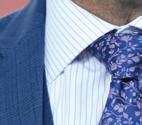
Stationary team A backs lined up within the tackle box may block below the waist within the tackle box until the ball leaves the tackle box only if the force of the initial contact is directed from the front. All other team A players are not allowed to block below the waist.
Play 2: The ball is at the left hashmark. Back A1 initially sets up outside the tackle box to the left. He then moves inside the tackle box, stops and resets behind the left tackle. At the snap, he immediately blocks B2 below the waist. A1’s block is from the (a) front, or (b) side. Ruling 2: A1’s position inside the tackle box and the fact he was stationary at the snap are a factor. In (a), the block is legal, but not in (b). Stationary backs may block low within the tackle box only from the front.
Play 3: Back A1 sets up within and on the left side of the tackle box. As shotgun quarterback A2 begins to call signals, A1 starts in motion to his right. At the snap, A1 is two yards in front of and to the right of A2, serving as a pass protector. While A2 is in the pocket, moving to his right, A1 blocks B3 below the waist (a) in front and directly toward team B’s goalline, or (b) in front by moving to his left. Ruling 3: Even though A1 was in the tackle box at the snap and his block was inside the box, because he was in motion at the snap, he may not block below the waist in any direction.
Team B players aligned in a stationary position within one yard of the line of scrimmage within the tackle box may legally block below the waist in any direction within the tackle box on their initial line charge. All other team B players are not allowed to block below the waist except against a ball carrier.
Play 4: Left guard A1 pulls to his right to be a lead blocker on a sweep. After making his initial charge, defensive tackle B2 runs down the line laterally in pursuit. While still inside the tackle box, B2 blocks A1 below the waist. Ruling 4: Foul for illegal block below the waist. After making his initial charge, B2 may not block below the waist even within the tackle box.
BY THE NUMBERS
Number of officials used in NFL games from 1925-28.
Number of officials used in NFL games starting in 1929, when the field judge was added.
4
5
Number of officials used in NFL games starting in 1947, when the back judge was added.
6
Number of officials used in NFL games starting in 1960, when the line judge was added.
7

Number of officials used in NFL games starting in 1978, when the side judge was added.
DID YOU KNOW?
THEY SAID IT
howie long








REFEREE August 2022 | 13
3
Mike Morton, who will be a rookie NFL official in 2022, was drafted by the thenOakland Raiders and played for them from 1995-98. He is the first NFL official who played in a Super Bowl. Morton, who will work as an umpire, is a dentist in Charlotte, N.C.
“(Officials) do a pretty darn good job. It’s the toughest sport to officiate because of the size of the field and the speed of the game.”
— Pro Football Hall of Fame member and Fox television NFL analyst Howie Long
TEST YOURSELF
In each of the following you are given a situation and at least two possible answers. You are to decide which answer or answers are correct for NFHS and NCAA rules, which might vary. Note: In kicking situations, K is the kicking team, R the receiving team. Solutions: p. 81.
1. After the ball is dead, runner A1 rises and roughly pushes B2 to the ground. Earlier in the game, A1 was penalized for cursing at an official.
a. Personal foul.
b. Unsportsmanlike conduct.
c. A1 is ejected/disqualified.
d. All of the above.
2. In which of the following cases is a player penalized for intentionally removing his helmet?
a. During an official’s timeout for a measurement.
b. During an official’s timeout for an opponent’s injury.
c. As he is running off the field after making a great play.
d. In the interval between a try and a free kick.
e. None of the above.
3. On a free kick, K1 commits kick-catch interference at team R’s 45 yardline. The ball goes out of bounds at the 50 yardline untouched by team B.
a. Both penalties may be enforced.
b. Only one of the penalties may be enforced.
4. Fourth and five from team K’s 30 yardline. An official blows an inadvertent whistle when K1’s punt is in flight. When the down is replayed:
a. The clock starts on the snap.
b. The clock starts on the ready.
5. Third and 10 at team B’s 15 yardline. A1’s legal forward pass is caught by A2 at team B’s 10 yardline. A2 advances to team B’s six yardline, where he fumbles. The ball goes over the end line. During the play, B3 is flagged for roughing the passer. The penalty is enforced from:
a. Team B’s six yardline.
b. Team B’s 10 yardline.
c. Team B’s 15 yardline.
Targeting (9-1-3, 9-1-4). When a targeting foul occurs in the second half, the carryover penalty of sitting out the first half of that player’s next game is eligible for further appeal. A conference may now submit a request to the NCAA national coordinator of officials, who will review video of the play. If it is obvious a player was incorrectly penalized for targeting, the conference may vacate the suspension and allow the player to play in the next game.
Feigning injuries (3-3-5b). For the reporting and investigation process to address teams that are awarded an injury timeout through deceptive actions which was put in place last season, the national coordinator of officials will provide feedback to the conference for further action instead of the athletic director of the involved school. Any penalties levied would be up to the conference office.
Feigning an injury for any reason is unethical. An injured player must be given full protection under the rules, but feigning an injury is dishonest, unsportsmanlike and contrary to the spirit of the rules.
Play 5: Late in the fourth quarter, A1 runs for a first down and the officials notice B2 on the ground grabbing his knee. The clock is stopped and the athletic trainer comes onto the field. B2 quickly runs off the field with an apparent fake limp. He re-enters the game after sitting out a down. Ruling 5: The officials properly stopped the clock giving B2 the full protection he is entitled to by rule. The opponents or the officials should bring the play to the attention of the national coordinator, who will conduct a review.
Defensive holding (9-3-4c-e Pen.). Defensive holding remains a 10-yard penalty but always includes an automatic first down regardless of whether or not the foul is against an eligible receiver or whether the foul occurs behind or beyond the neutral zone.
Play 6: Third and 15 on team A’s 25 yardline. B1 holds A2 at the line. A3’s pass is tipped by B4 at team A’s 24 yardline and falls incomplete at the 32 yardline. Ruling 6: Although A3’s pass has not crossed the neutral zone
because it was touched behind the neutral zone, the automatic first down applies. It will be first and 10 for team A at its 35 yardline. The requirement the contact be made against an eligible pass receiver when an untouched legal forward pass crosses the neutral zone no longer applies.
Unsportsmanlike conduct (9-2-1a1 Pen.). The enforcement of the 15-yard penalty and an automatic first down for unsportsmanlike conduct fouls by team B players is aligned with the enforcement for personal fouls on pass plays. On successful pass plays, the unsportsmanlike conduct penalty may now be added to the end of the last run by the offense if there is no change of team possession during the down to ensure the foul is penalized.
Play 7: Third and 10 on team A’s 20 yardline. B1 hits A2 as he is releasing a pass (no foul). The pass is caught by A3 at team A’s 24 yardline. A3 runs to team A’s 40 yardline. As the pass is thrown B1 taunts A2. Ruling 7: The penalty is enforced from the end of the run, resulting in first and 10 for team A at team B’s 45 yardline. Under the previous rule the enforcement spot would have been the previous spot, resulting in the penalty being declined.
Blocking after fair catch signal (6-5-4 Pen.). The penalty for a player of team B who makes a valid or invalid signal for a fair catch and does not touch the ball and blocks or fouls an opponent during that down has been reduced to 10 yards from 15 yards unless it is a personal foul.
Play 8: Fourth and three on team A’s 40 yardline. Punter K1 kicks the ball and R2 signals for a fair catch. The ball bounces at team B’s 25 yardline and ricochets off K3’s leg. Seeing that the ball has been illegally touched by K3, R2 pushes K3 at team B’s 10 yardline in the front above the waist as K3 was allowing the ball to roll toward the goalline. After pushing K3, R2 recovers the ball and runs for a touchdown. Ruling 8: A foul for blocking after giving a fair catch signal. The 10-yard penalty is enforced half-the-distance from the spot of the foul. It will be team B’s ball, first and 10 at its five yardline.
Illegal touching (7-3-11 Pen.).
FOOTBALL 14 | REFEREE August 2022
The penalty for illegal touching by an originally ineligible receiver now includes loss of down.
Play 9: Team A is attempting a two-point try. Left tackle A1 moves into the flat to potentially receive a backward pass. A2 throws a pass to A1, who catches the ball and runs into the end zone. The line judge rules the pass was forward. Ruling 9: A foul for illegal touching. Because the penalty includes loss of down, the try is not replayed.
Simulated slide (4-1-3r). If a ball carrier simulates or fakes a feet-first slide, the ball is dead at that spot. Such a player is not considered defenseless unless contact qualifies as a late hit or another type of defenseless player definition applies.
Editorial changes. In addition to the rule changes, editorial changes were made to clarify existing rules.
Fumble at rest (7-2-5b). When the ball is declared dead for a fumble at rest with no player attempting to secure it, it is treated the same as a
fumble out of bounds. Previously, the ball was awarded to the fumbling team at the dead-ball spot.

Play 10: A1 breaks free for a long run with no opponent in close pursuit. A1 drops the ball at team B’s one yardline, thinking he has scored. The ball rolls into the end zone with no player making an attempt to recover.
Ruling 10: The ball belongs to team A at the one yardline.
Crown of the helmet (9-1-3). Based on the new helmet designs, the crown of the helmet definition has been updated for greater clarity. The crown of the helmet is the top segment of the helmet; namely, the circular area defined by a six-inch radius from the apex (top) of the helmet.
Instant replay — clock adjustment (12-3-6b). The replay official may address any clock adjustment and status when a ruling is reviewed with less than two minutes in the second quarter or fourth quarter.
Defenseless player (2-27-14a, 9-1-4 Note 2). A player in the act of or just after throwing a pass includes any offensive player in a passing posture with focus downfield. It does not have to be the quarterback or the player who first controlled the snap.
Coaches’ booths (1-4-11b). Coaches’ booths for both teams are to be approximately equivalent in all aspects including locations in relation to the field. Coaches’ booths should be located in the traditional press box area.
Illegal blindside block (Appendix F, Signal 28). A new signal for an illegal blindside block has been added. To signal, referees bring their fists together in front of their chest. Referees will include the word “Illegal” in their verbal penalty announcement, as in, “Personal foul, illegal blindside block.”
George Demetriou has been a football official since 1968. He lives in Colorado Springs, Colo.
Never Forget This ‘Always’
By Judson Howard
There are few absolutes in football rules. That is due to multiple penalty options, timing variances and rule exceptions. Be suspicious when a football test question includes “never” or “always.” Some things are never true or not always false.
However, there is one unconditional fact about timing rules: The clock always stops at the end of fourth down. It doesn’t matter what happened during the play or what type of play was run.
Here are six possible outcomes during a fourth-down play.
• The offense gets a first down.
• The offense does not reach the line-to-gain.
• Either team scores.
• Team B recovers a fumble or intercepts a pass.
• A foul is called.
• A player is injured.
All of those events call for the clock to stop when the down is over.
It doesn’t matter which team next snaps the ball or if the down is repeated. Nor does it matter if the clock next starts on the ready or the snap.
Knowing all of that, you should unconditionally give the stop-the-clock signal at the end of a fourth-down play. You will never be wrong.
When you give the closed fist signal to indicate fourth down, use the crew communication signal to remind crewmates of the situation. The signal seen in the PlayPic has multiple meanings (snapper protection, fourthdown fumble rule in NCAA) but one of the messages is a reminder to give the stop-the-clock signal when the play ends.

Judson Howard, Los Angeles, is a replay official in the Pac-12 Conference He officiated more than 20 years, many at the NCAA Division I level.

FOOTBALL
Snapper protection rules apply
Returned to Sender
It is rare for team K to get the ball back during the same down on which it punts. But it can happen, as illustrated in the MechaniGram.
It is fourth and 10 on team K’s 45 yardline. K1 shanks the punt. R2 muffs the ball at his own 42 yardline and the ball bounces back behind the neutral zone, where K2 recovers at his own 41 yardline. Not knowing the gift his team has been given, K2 throws a pass intended for an eligible teammate, but it is incomplete.
In NCAA play, the ball is dead when K2 recovers it, therefore the pass would not occur. Since R1 touched the kick beyond the neutral zone, it will be first down for team K at the spot of K2’s recovery and the game clock would start on the snap due to the legal kick (3-3-2d-8, 5-11e-2).
Under NFHS rules, the pass is


foolish but legal. Since team K was in legal possession at the end of the down, it is a first down for team K at its own 41 yardline. The game clock starts on the snap since a new series was awarded after a legal kick (3-4-3c, 5-1-3f, 5.1.3 C).

Things change, however, if a punt is blocked and doesn’t cross the neutral zone.
Play: Fourth and 10 for team K from its own 20 yardline. K1’s punt is blocked. The loose ball rolls to team K’s 14 yardline and is recovered by K2, who (a) punts it again, or (b) throws a pass that is caught by eligible K3. K3 is downed at team K’s 33 yardline. Ruling: In (a), the kick is legal and the play is treated like any other punt. In (b), the play is legal. First down for team K from its own 33 yardline and the clock starts when the ball is ready for play.
PRESS BOX MUFF PASS PUNT A1 B2 A2 SPOT OF SNAP
CASEPLAYS
Fumble, Inadvertent Whistle
Play: Team A is attempting a two-point try. A1 fumbles at team B’s five yardline. A2 recovers there and advances to team B’s two yardline when the covering official blows the whistle. Ruling: In NFHS, the ball remains live until the official blows the whistle. But due to the inadvertent whistle, team A will likely choose to have the down replayed (4-2- 3c, 7-42). In NCAA, due to the fourthdown fumble rule, the ball is dead when A2 recovers it. Therefore, the whistle is proper. Play resumes with team A’s free kick (4-1-2a, 7-2-2a Exc. 1, 8-3-2d-5).
Ball Strikes Pylon
Play: Third and goal at team B’s eight yardline. A1 catches a pass and is hit at team B’s two yardline. He fumbles and the ball strikes the pylon, which is properly placed. Ruling: Under both codes, the ball is dead when it strikes the pylon. The result of the play is a touchback. Team B will begin a new series at its own 20 yardline (NFHS 1-2-4, 4-2-2b, 8-53c, 8-5-4; NCAA 2-12-2, 4-2-3b, 8-6-1a, 8-6-2).
Ineligible Catches Pass
Play: Third and seven at team A’s 34 yardline. Defensive lineman B1 rushes the passer and tips a legal forward pass, which continues in flight. After the tip, ineligible A2 catches the ball at team A’s 38 yardline. Ruling: Under both codes, that’s a legal catch. All team A players become eligible when team B is first to touch the pass (NFHS 7-5-6b; NCAA 7-3-11).
Too Many Players
Play: Team A lines up for a two-point try attempt. Team B has 11 players in its defensive formation. B12 runs onto the field just before the ball is snapped. A1 takes the handoff and carries the ball into the end zone. Ruling: In NFHS, B12 is guilty of illegal participation. Team A scores two points and will accept the penalty from the succeeding spot (8-3-5). In NCAA, that is a live-ball foul for illegal substitution. Team A will decline the penalty and keep the two points (3-5-3b, 8-3-3b, AR 3-5-3 VI).
5 MINUTES WITH TOM QUICK
SEC umpire talks about keeping peace in the middle.
Resides: Shawnee, Kan. Profession: Senior vice president and shareholder for HUB International, the largest privately held insurance and surety bond company in the U.S. Experience: Big 12 staff 2002-11 and Southeastern Conference (SEC) umpire since 2012. Worked the 2008 BCS National Championship game. Has also worked a College Football Playoff Semifinal, two Fiesta Bowls, two Orange Bowls, Sugar Bowl, Rose Bowl, three Big 12 championship games, and an SEC championship game.

REFEREE: Over the years have you found yourself working outside the hashes more than you used to?
QUICK: I’m convinced that for all officials, but especially the umpire, who really does manage a lot of what goes on inside, the more effort you put into presence around the deadball action, getting different-colored jerseys separated and letting them know that you’re there, prevents you from having to throw gamemanagement fouls. That’s one thing I’ve learned. And I think to me that’s effort-based game management work off which the crew feeds. I take a lot of pride actually not just running around the field but letting the kids know wherever the hot spot or warm spot is, “Hey, today we’re just going to play, let’s go back in the huddle.”
REFEREE: When a play breaks down, how do you determine where trouble may pop up?
QUICK: When it breaks down and it seems to be all chaotic I think that’s when the umpire needs to really lock down. While the wing officials are covering forward progress, the deep guys are really looking at holds, the referee is taking care of his quarterback, there’s really nobody staying in the middle to get that cleaned up to then move onto the next batch. Chaos in my opinion means time for the umpire to calm down.
REFEREE: How important is it for umpires to interact with players?
QUICK: The more active an umpire is at communicating, the kids will respond to that. At the high school level, at small college, it’s communicating with them and letting them know you’re there for them without befriending them. It has worked for me.
REFEREE: Do you have a pregame routine regarding communication?
QUICK: It’s typical the offensive lines (warm up) in the left end of the end zone. I go down and I don’t get in the middle of the drills. I know from looking at the film and in preparation that week who the leaders are, who the upperclassmen are. And it’s the same speech I’ve given for over 20 years: “My name’s Tom, I’m here to work with you.” It’s to the point now where the coaches actually know what I’m trying to do, and they will stop and say, “Listen to this guy.” It’s just to build rapport with the kids. During the game, it could be a backer that says, “Tom, I need you to move,” or, “I’m dropping into the zone.”
FOOTBALL 18 | REFEREE August 2022
VICTOR CALZADA
football training on the go
$1995









ONLY for the set of 8

Ref smarter all season long with the Insider Series! These quick-hitting multimedia guides feature video, interactive graphics and much more. For one low price, you’ll get a full year’s worth of up-to-theminute info delivered every few weeks throughout your season. Topics include:











What is and What Isn’t Pass Interference Interior Line Play In-Depth The Priorities of Sideline Management Much More!



New 2022 Rule Changes












NEW ONLINE DIGITAL STUDY GUIDES AVAILABLE THROUGH YOUR PHONE OR TABLET
! ORDER TODAY AT STORE. /football
Award
JOAN POWELL
OPTIMIST, BUILDER, MENTOR





 BY PETER JACKEL
BY PETER JACKEL
While strolling down the sunny side of the street during her nearly 71 years on this earth, Joan Powell has never allowed anything to impede her journey. Oh, there’s been plenty of frustration along the way, but anyone who focuses on building bridges instead of walls is going to one day reflect on a life well spent. It’s a mindset inspired by her late mother, Marian McCormick, whom Joan recalls, “always found the good in people. And she believed that whatever obstacle comes your way, you can overcome it.” There’s just no stopping Powell. When she lost her beloved husband, Dick, after a tragic fall following nearly 38 years of marriage in May 2021, she grieved, but she also continued to achieve as one of the most influential and beloved volleyball officials and mentors in the history of the sport. Just this year, she was appointed the Western 5 Consortium coordinator of officials. And she is still routinely driving the E470 Tollway from her Colorado Springs home to Denver International Airport for another job-

related flight. Is there an endgame in sight? Let’s answer that question this way: A woman who used to jog five to six miles a day for 40 years before undergoing hip replacement surgery in 2013 now pushes herself through 105 laps around a swimming pool every day except Sunday. Quite simply, Powell’s life was never equipped with a set of brakes. Let it also be said she’s not about to stop and smell the roses during her golden years since she already has been doing that for most of her life. Why shouldn’t someone who loves what she does continue sharing her immense gifts?
Meanwhile, the awards keep coming in, the most recent of which is the most prestigious. That’s the Gold Whistle Award, the highest honor in officiating, which will be presented to Powell on Aug. 2 in Denver, just 70 miles from her home. Barry Mano, president of the National Association of Sports Officials, captured the essence of Powell when he said in his announcement, “Just look at all she has accomplished and in a way that causes so many to revere her integrity and enthusiasm. She
has and continues to shine such a positive light on officiating and on the leadership path for officiating administrators. The selection of Powell as the Gold Whistle recipient was an easy one.”

Better yet, let’s call it a slam dunk. That was underscored all the more when PAVO Executive Director Katy Meyer effusively reflected on the supersized impact Powell has been making on volleyball almost since she started pursuing it when she was a teenager in the late 1960s.
“When I consider this question, two words immediately come to mind — opportunity and pioneering,” Meyer said. “On the first, I’ve been in the room when the ‘please stand if your own officiating journey has been impacted by Joan Powell’ instruction is given. Whether the room is filled with veteran officials, novice officials or those with experience levels in between, nearly the entire room will stand! My own personal officiating journey would not likely have been the same without Joan’s help in maneuvering a roadblock or two. More globally, however, is how Joan is quick and committed to
ISAIAH DOWNING
20 | REFEREE August 2022






building up others. In a way that other leaders can benefit from, Joan seeks and embraces the strengths of those with whom she surrounds herself. Delegation of duty? Maybe. The bottom line is, those who answer her call are duly recognized for their strengths and contributions — big or small. Let her 2022 motto support this point: A rising tide lifts all boats!”
Powell is even more than a rising tide. She is more like a tsunami of positive energy who has time for everyone and who has an uncanny knack for making sticky situations so much less tense. She might flash a hint of her anger over the subject of social injustice, which was something she dealt with during the pre-Title IX days just as she was coming of age in her hometown of Tucson, Ariz. And anyone who accepts her invitation to play ping-pong will likely see her unrelenting competitiveness, as her younger sister, Nancy Meech, attests. “She is wicked good and ruthless,” said Meech, who possesses the same warm voice as Powell. “She’s kind of, ‘Hey, do you want to play?’ just like a hustler. And then you get out there and you’re like, ‘What?’ I mean, who has a really good backhand in pingpong?”
But the same woman who will overwhelm opponents at the ping-pong table will offer gentle counsel and wise guidance to anyone in volleyball who seeks her out. She has time for anyone within the realm of volleyball and she has profoundly influenced countless lives.
As Doug Beal, a former USA Volleyball CEO, said, “I have a hard time imagining almost anyone who is more deserving than Joan. She has achieved at a real high level in so many different arenas of our sport. I think she sees life and the sport and people in such a positive way and I think people connect to her partly because of that and partly because of her confidence and professionalism.”
Anne Pufahl, the NCAA volleyball secretary-rules editor and coordinator of officials for the Big 12 and Sun Belt conferences and the Summit League, has known Powell for those virtues for years.


referee too. Let’s talk.’ It’s her likability. She draws people in. And her willingness to help any referee, no matter what level, who asks her questions, she’s going to give her full attention and help. And she’s going to want to mentor them down the road. She’s just so giving to our sport and to other human beings that I can’t even describe it. It’s a trait I wish I had and could do, but she has it and does it without trying.”
“Joan is not only the best volleyball referee I ever watched or refereed with, she’s probably one of the best human beings I’ve ever known in my life,” she said. “(The Gold Whistle Award) is due. She’s earned this. Anyone she talks to, she instantly relates to and makes them feel good. She’s not, ‘I’m Joan Powell. I’ve done nine Final Fours.’ She’s, ‘I’m a
The essence of what Powell is all about is illustrated by a story that took place shortly before she was interviewed for this story. The setting was the home she shares with her 42-year-old daughter, Ashley, not some volleyball court. A freeze had caused a pipe in her house to burst, which caused considerable water damage in her basement. In the spirit of Murphy’s Law, this emergency occurred on a Sunday, meaning overtime was going to be in order for the serviceman who repaired her pipe. Indeed, it was a whopper of a bill, but as Powell signed the check, she removed the sting by mentally drifting 6,000 miles to the east. Ukraine had been invaded by Russia on Feb. 24 and Powell couldn’t help but think the drain on her checking account over this household matter was nothing
22 | REFEREE August 2022 GOLD WHISTLE AWARD
Joan Powell and her husband, Dick (who died in May 2021), were married for nearly 38 years. They are pictured with their daughter, Ashley.
“JOAN IS NOT ONLY THE BEST VOLLEYBALL REFEREE I EVER WATCHED OR REFFED WITH, SHE’S PROBABLY ONE OF THE BEST HUMAN BEINGS I’VE EVER KNOWN IN MY LIFE.”
— Anne Pufahl, NCAA volleyball secretary-rules editor
compared to the suffering of so many innocent citizens in that war-torn nation. Handing her check to the repairman, Powell said, “Do you know what? I don’t live in Ukraine.” She had the same mindset when presented another sizeable bill after the water damage in her basement was repaired. Powell was preparing for a Zoom call to discuss becoming the consortium’s coordinator of officials when contractors were making all kinds of racket in her basement.
“I mean, I’ve got two minutes for one of the most important Zoom calls of my life with five representatives from five other conferences,” she said. “A big decision is going to be made about whether I’m going to be at the helm of a consortium on the West Coast, so I’m asking the guy who is shooting the nail gun, ‘OK, are you almost done?’ Then he walks up the stairs just as I’m putting on the Zoom and he wants to talk to me! As a friend of mine used to say, ‘The
sprinklers were on because I was sweating already!” But Powell kept her cool, just as she always does. And now her basement is as good as new and she is the coordinator of the Western 5 Consortium of Officials, which covers the Pac-12, Mountain West, Big West, West Coast and Big Sky conferences. Somehow, everything always seems to turn out OK in Joan Powell’s world.
It’s all about perspective for Powell and that’s something she started to learn in the late 1960s, when the fourth of John and Marian McCormick’s five children was an aspiring cheerleader at Salpointe High School (now Salpointe Catholic) in Tucson. Powell wasn’t selected in each of her four years of high school to make the final squad of cheerleaders, which would cause a fair amount of heartbreak for any teenager. Powell was no exception. Being a cheerleader was someone to be back in those pre-Title IX

Left photo: Joan Powell’s officiating career included NCAA championships at all three levels. As a coordinator, she has participated in NASO Summits (top, right) and helps prepare the next wave of officials for the big games at events like the Pac-12 Volleyball Officials


Diversity Camp (bottom, right).
days. It was prestigious. As far as athletic competition in those days, that was strictly for the guys. If girls were fortunate enough to express themselves athletically, it was likely accomplished at the intramural level while quite possibly getting stuck wearing unflattering one-piece uniforms.
“All my friends were doing it,” Powell said of cheerleading.
“It was the only gig in town for young females at that age. I wanted to be part of a group. Sports does the same thing, but back in the ’60s, it wasn’t as popular. You were kind of a tomboy. You were targeted as kind of different, where cheerleaders were the most popular and the cutest. I never made it, but my mom said to me, ‘When God closes the door, he opens the window.’ And sure enough, I tried out for volleyball. What I say in clinics, “Hey, had I made cheerleading, I would have never been able to go to the 2008 Olympics in Beijing!”
But this journey wasn’t always easy, and it started right in Powell’s own home. It was in 1969 when Powell, accompanied by three high school friends, visited the University of Arizona to chart their respective futures. While her friends chose more traditional departments to pursue in college — nursing, communications and education were their choices — Powell was uncertain. “What am I good at?” she recalls pondering. And then she had an epiphany. Why not physical education? After all, she grew up playing outside with her two brothers and two sisters “until the sun went down,” she said. And she more than held her own on volleyball courts for Salpointe when cheerleading didn’t work out. So, she walked to the end of the campus to sign up in physical education and was thrilled to inform her parents of her choice over dinner that night. More than a half-century later, Powell can still hear the deafening silence from her father, whose head went down upon hearing his daughter’s career plans.
“My dad was a very quiet man, but he really got quiet,” she said. “He didn’t engage me in questions or say, ‘Oh, that will be good for you!’ There was just nothing. So, I was doing dishes at the kitchen sink and I asked my mom, ‘What’s up with that?’ And she said, ‘Oh, Joanie, he has an aunt who was a physical education teacher and she was gay.’ And I think right there, my dad just assumed that if I went into physical education, I’m either gay now or I’m going to turn out to be gay. He was worried. Think about it. This was 1969 and nobody talked about it. So fast forward four years at the University of Arizona, I had straight friends, I had gay friends, I had married friends … it was just not a big deal. And to this day, I have friends and I don’t label them as anything. But my dad came in with a prejudice already. So how
Top photo: Powell coached volleyball at Coronado High School in Colorado Springs from 1978-2006. Left: She’s also seen here during her early days of her 40-year volleyball officiating career. Right: In college, Powell called balls and strikes, safes and outs on the softball diamond before leaving umpiring behind to focus on volleyball.



about that?”
How about this? Powell tried out for the women’s volleyball team at Arizona and became a four-year starter as a 5-foot-4 setter. In 1972, Powell helped her team qualify for the national tournament, but it was not the celebration one might expect. When all was said and done, the dreams young women dared to dream were instantly vaporized by the harsh reality of those days.
“We were happy as clams,” she said. “Meanwhile, we drive our own cars or sometimes we’d get rentals — very low budget — and we had uniforms that basketball and softball also used. One set of uniforms for three sports. We don’t know the difference. We’re just happy as clams to be playing. So now we’re going to the big dance, right? A national championship. First time ever! A women’s team sport is going to represent the University of Arizona. Our athletic director goes to the president to see if there’s any funding. And the answer is no and we did not get to go. In those days, we were just submissive to reality, which was, ‘You are not worthy.’”
But Powell, for one, was so worthy. There was just something about her that stood out to Dr. Kathryn Russell, the coach at Arizona, that strongly
foreshadowed future greatness. A half-century later, Russell reflected on the qualities that would make Powell this year’s recipient of the Gold Whistle Award.
“She wanted to be involved, she wanted to make a contribution and to my knowledge, anything she was involved in was better because of her participation,” said Russell, who is in her 90s but met Powell for lunch this year. “She never backed down. She was willing to confront if confrontation was necessary, she was willing to let her feelings, her standards, her beliefs be known, she’d explain why, she had a strong sense of right and wrong and she was a leader. She just was a delightful person to know and a delightful person to work with.”
Powell took a course taught by Russell in sports officiating. “That gave me the impetus,” Powell said. “We were introduced to making money.”
As a sophomore, Powell secured the opportunity to work softball games for the parks and recreation department four days a week. After working three games a night in the Tucson heat, she would dig up the bases at around 11 p.m. “It was 100 degrees at 11 o’clock at night,” she said. “What was it when we started to work?”
24 | REFEREE August 2022 GOLD WHISTLE AWARD
That was the start of a prestigious officiating career, during which Powell ultimately focused on volleyball, serving for more than 40 years as a USAV and NCAA national referee. Her resume includes working nine NCAA Division I championships and several Division II and III championships. One career highlight came in 2008, when she traveled with the U.S. women’s national team to serve as head of delegation or team leader — responsible for logistics — at the Pan Am Cup, the World Grand Prix and the Olympic Games in Beijing.
But officiating was only one facet of Powell’s impact on volleyball. Fresh out of college in 1973, Powell returned to Salpointe High School, where she coached her sister, Nancy. By 1976, Powell settled at Coronado High School in Colorado Springs, where she was head girls’ volleyball coach and a physical education/health teacher until 2006. During her run, Powell coached three state championship teams and was named Coach of the Year seven times. And just as she coached her sister at Salpointe, she also coached her only child, Ashley. That was up there with any of
Powell’s achievements because as she says, “My family — my two sisters and brother (her second brother is deceased) and especially my daughter now — are my support system, my rock!”
Ashley recalls learning tough lessons from her mother, just as countless others over the years certainly did.
“I would love to take my four years back, meaning I was a pistol,” Ashley said. “I had an attitude. I wanted a perfect match. I just would not accept mistakes. I’ll speak for Mom and say I think it was extremely hard for her. There were times when she couldn’t take it anymore and it was, ‘You’re out! Sub! Knock it off and respect others!’ I never saw her that firm, that strict, and it was in front of my teammates. Mom and I talked about it after the match and I felt better. I felt like a different Ashley. You have to respect others.”
Looking at her mom after all these years, there is nothing but respect from Ashley.
“I saw she is the most positive, inspirational and driven person in the volleyball world,” Ashley said.
There are countless others who agree with that.
“She just constantly looks to improve and help us grow as people, which also helps us to grow as officials,” said Kaili Kimura, a Pac-12 official. “Joan makes an effort to make sure we have the best training, the best equipment. She’s in there pushing for things that will make it easier for us, whether it’s higherresolution cameras, whether it’s better coverage, whether it’s having a standardized set of equipment so we can get better looks. The consortium has gone in her direction, which to me is a no-brainer, because she pushes so much for the improvement of our sport and the improvement of officials. It’s all about for the betterment
The Gold Whistle Award
was created by the NASO board of directors to honor an individual or organization that has gone above and beyond in overall integrity and has made significant contributions to the betterment of officiating. The Gold Whistle is among the most coveted awards in the world of sports officiating.




To be selected as the award recipient by the NASO board of directors, consideration is given for:
• Significant contributions to the betterment of officiating.
• A high degree of integrity and ethics.
• Qualities that are held in high regard by the industry.
• Consistent record of presenting officiating in a positive light.
• Exhibiting a “service above self” attitude. Public service to officiating, having a motivating effect on others and/or strong community involvement are considered.


The award can be made posthumously.
of the game.”
Marcia Alterman, a former PAVO executive director who coordinates officials for the Big Ten and six other Division I conferences, can vouch for Powell being a worthy recipient of the Gold Whistle Award. After all, she received the award herself in 2015.

“Joan is a leader in our industry,” she said. “Of course, she specializes in volleyball, but she’s been a leader in so many ways for all officials. This is the appropriate award for her because she has been the face and the name and the advocate for officials in general for decades. She always is a problem solver and because of that, it’s, ‘What’s the next problem and what are my options or solutions to take care of that?’ It’s never, ‘I can’t deal with this! It’s more than I can handle!’ I have known her for over 30 years and I have never sensed that. It’s always been, ‘OK, there’s a wrinkle in the road and I’ve got to figure out how to get around it.’”
What a journey it has been for Powell. And there are likely so many more miles remaining for a woman who overflows with so much vitality and so many ideas. What’s difficult to ponder is what if she had made her cheerleading squad more than a half-century ago at Salpointe and never pursued volleyball?
“Joan slipped and fell on each of her routines, never making any of the squads,” Meech said. “Although crushed each year, she was happy for her girlfriends and continued her quest the next year, but ‘settled’ to play volleyball each year instead. How lucky was the volleyball world that Joan never made the cheerleading or the pom squads? And how lucky for a little sister to learn the lessons of perseverance and knowing that from failures can come ultimate success?”
lucky





Peter Jackel is an award-winning sportswriter from Racine, Wis.

REFEREE August 2022 | 25
ISAIAH DOWNING
USE THEM OR LOSE THEM
Engage Line Judges and Keep Them Focused on the Match
By Robert Doan
“My line judge is not very good; she never pays attention.”
“My line judge would rather be on her phone or with a friend rather than working my match.”
“I wish someone would hold these line judges accountable.”
Harsh words from the referee room. As referees, how do we properly use our line judges? This article will discuss strategies for properly using line judges in order to get the most out of them and keep them focused on the match.

Pregame
Have a meaningful pregame meeting. Make sure all line judges for the match are present and discuss the expectations for the match. Know your audience. A pre-match meeting with 12-year-olds might be a little different meeting than 18-year-olds. With the younger age group teach; with the older or more experienced, remind or emphasize. As always, discuss specific needs that you have as a R1. Be approachable and have a good attitude in the meeting. When the R1 has a good attitude and is excited to work with the line judges,
the line judges are more likely to have a good attitude as well.
Engagement
The first step is to engage the line judges early. When officials comment how good their line judges are, many state the secret is to build a relationship with them and engage the line judges throughout the match. Some officials let the line judges know they try to make eye contact with them before the first serve of the match as a way to show “you are on my team and let’s do this together.” Others make it a point to make eye
VOLLEYBALL RULES, MECHANICS, PHILOSOPHY 26 | REFEREE August 2022 EDITORS: BRAD TITTRINGTON btittrington@referee.com
BOB MESSINA
Rajan Dozas, Sherman Oaks, Calif., gives some last-minute instructions to the line judges before the match begins. This prematch lesson can go a long way in developing trust with your line judges and determining their skill level.
contact or reinforce the behaviors they mentioned in the pregame with a thumbs up early in the match or set. Whatever method you prefer, make sure you keep the engagement levels high throughout the match.
Correct the Problem
Too many officials notice the line judge not performing their duties and quickly discount them the rest of the match. This is not appropriate because it reinforces the idea that R1s don’t use their line judges. Most of the time, a quick message can be delivered and no one from the match or crowd will notice the extra time spent communicating with the line judge between points. This quick message could be getting their attention when the ball is being recovered or getting their attention during a substitute exchange. If needed, call both line judges over during a timeout to discuss what you need from them that they might not be doing. Reinforce they are a part of your team and they are needed and appreciated.
Acknowledging Versus Using
At the very least, it is important for officials to acknowledge their line judges. At the minimum, acknowledging line judges will aid in keeping the line judges engaged in the match. When the ball is close to their line, give a courtesy look before or after awarding a point. Try to make eye contact, which should let them know you see them working and appreciate their engagement in the match. If the ball is out, you should have time to scan and acknowledge.
The next level is using the line judges. Line judges have felt at times they could go to the concession stand and get a pretzel, come back and the R1 would not have known they were gone. Officials want to be used. We want to contribute to the match. Line judges have a unique angle and role in the match and absolutely want to feel their “voice” is being heard. It is important for referees to look for information when appropriate. If there is a close antenna violation, it is important for the R2 to peek at
the LJ2 to make sure he or she has what you have. If you do not know 100 percent if the ball was completely inside the antenna, make sure you use that line judge to get the correct information.
R1s cannot move to see pancakes or antennas. When it is safe to peek at the line judges, look at them to gather information. Most officials tell line judges to try to make eye contact with the R1 on a pancake decision (ball up or down), and then if the ball is up everyone will move on. Use the line judges when you need to because there are plenty of plays where they have a great angle to help.
The Art of Using Line Judges
There are officials who use line judges every play. The ball falls between two players in the middle of the court or the ball is served 15 feet out of bounds. In both situations, officials more than likely did not need to explicitly turn and gather the information from the line judges. In those situations, feel free to acknowledge line judges to let them know you appreciate them but more than likely you did not need to use their information. If an official uses the line judge on every play, coaches might perceive the official as relying on the line judge for a call instead of using the line judge for help with a call. Remember at the end of the day each call is made by the official with the help of the line judges.

Conclusion

Acknowledge and use line judges throughout the match. They are an important part of the game. Build a professional relationship with the line judges so they will want to come back and do it again. Post-match with the line judges at all levels. Using line judges appropriately will help in recruiting line judges to become an official one day. In the future, there will be more success stories with regard to line judges then complaining.
Robert Doan, PhD, has been a high school, college and USAV official for more than a decade. He is a resident of Charleston County, S.C.

DID YOU KNOW?
New PAVO members receive free NCAA registration. A new member is someone who has never been a PAVO member. The normal NCAA fee for a standard returning member is $70 and a returning associate member is $35. These fees would be waived for new members. This also requires the new PAVO member to be a first-time registrant with NCAA Volleyball. To learn more, go to PAVO.org.
QUICK TIP
Sometimes during play, a player may have a hard collision with the referee stand. Be prepared for this. You may have to hold on to the stand or net post itself to absorb the energy of the impact. If a collision dislodges the stand from its centered position, wait for a dead ball to move it back into position.
TOOLS
Net Gain
Are you looking to improve your judgments around ballhandling, overlaps/alignment, net play and line calls? Then Net Gain:


Officiating Volleyball’s Tough Calls is the book for you. Newly updated for the 2022 season, this 80-page book is filled with tips and techniques and covers the rules of the sport’s most challenging areas. Mastering these areas will instantly help you be a better referee and help you be more confident and consistent with your calls. The book can be purchased for $15.95 and can be found at store.referee.com/ volleyball.

REFEREE August 2022 | 27
TEST YOURSELF
In each of the following, you are given a situation and possible answer(s).

You are to decide which answer(s) are correct for NFHS, NCAA or USAV rules, which might vary. Solutions: p. 81.
1. The first server of the receiving team is in which position when the set begins?

a. Right back position.
b. Left front position.
c. Right front position.
2. Who has the authority to establish non-playing areas and define any additional ground rules?
a. Second referee.
b. Host administration.
c. First referee.
d. Home head coach.
3. During the follow-through, after attacking the ball between the antennas and before the ball hits the ground, a player contacts the mesh in the middle portion of the net.
a. The net contact is not considered part of playing action since the ball had already been hit. Therefore, no fault has occurred.
b. Contact with the net, between the antennas, during an action of playing the ball is considered a fault.
4. A front-row player blocks a ball that is completely in the opponent’s playing space. In which situation is this action a blocking fault?
a. After the third team hit by the opponents.
b. When a blocker reaches beyond the net and contacts the ball simultaneously with the opponent’s attack-hit.
c. When a ball is falling near the net and, in the R1’s opinion, no member of the attacking team is near enough to make a legal play on the ball.
5. B5 is disqualified for extremely offensive conduct. At the time of disqualification, B5 is on the court in position 3, center front. There are two substitutes on the bench, B9 and B10, as well as the libero. Both substitutes have previously played in this set in other positions. Which of the following actions is correct?
a. Allow team B to play with five players since they have no legal substitutes.
b. Allow an exceptional substitution using either B9 or B10 as a substitute for B5.
c. Team B is declared incomplete and defaults the set to team A.
d. Allow the libero to be an exceptional substitute for B5.
Catch Timeouts as a Team
 By Brad Tittrington
By Brad Tittrington
During a match, there are usually times when the second referee can assume a coach or captain may call a timeout: the opposing team goes on a run of multiple points and the team has trouble receiving the serve or passing the ball, the opposing team reaches 24 points, or the crowd comes alive and a team wants to quell the energy.
However, these instances are not the only times a second referee must be alert and ready for a timeout request. Coaches and captains use timeouts for a variety of reasons and second referees must be cognizant of these situations.
Too often, second referees, as well as first referees, get into a zone or rhythm with the match and fail to realize a coach may be trying to call a timeout. We’ve all been guilty at one time or another in our careers of focusing on the receiving team to make sure it is in proper rotation
and the players are aligned properly, and we don’t even look at the bench behind us where a coach is trying to get our attention, whether it is to call a timeout or request a substitution.
We’ve also been guilty as first referees of focusing so intently on the server and authorizing service that we forget to scan the benches one last time to make sure our second referee is ready and no coaches are trying to call a timeout. This is a good way to draw the ire of both the second referee and the coach.
It is important to be aware that some coaches like to wait until the last possible second to call a timeout. Quickly glancing at the bench right after a point is scored does not cut it. We must work as a team and make sure we do not miss these situations.
Coaches want to know referees are approachable and paying attention and if we don’t give them
28 | REFEREE August 2022
VOLLEYBALL
See “Timeouts” p.30
OFFICIATING VOLLEYBALL’S TOUGH CALLS












NET GAIN DON’T WAIT TO GET WHAT’S NEXT
This best selling volleyball training book is dedicated to improving your judgments around ballhandling, overlaps/alignments, net play and line calls. Mastering those four areas of the game will instantly help you be a better referee. *NASO member discount available. $1395 * DIGITAL $1595 * PRINT $2095 COMBO 32 Pages 5.5” x 8.5” SIMPLIFIED & ILLUSTRATED Volleyball’s most complicated rules are explained in everyday language and reinforced with 100s of illustrations. Deals with real-world rules questions and situations like: • Alignments • Libero/Serving • Boundaries • Net Play • Substitutions Plus much more!” $10 PRINT 72 Pages 5.5” x 8.5” The only comprehensive guide to the rules and nuances of the Libero position. Designed from the ground up, you get 9 challenging rules in 24 high definition pages that you can dig into anywhere. The book will talk about things you are not taught in the rulebook but need to be aware of. 32 Pages 8” x 11”$12.95 24 Pages 5.5” x 8.5”$5.95 50 Pages 5.5” x 8.5”$5.95 also avAilable ORDER TODAY AT STORE. /VOLLEYBALL UPDATED FOR 2022 UPDATED FOR 2022
CASEPLAYS
Service Zone
Play: At the moment the ball is contacted for service, the server’s foot is touching the short line (hash mark) at the side edge of the service zone. The foot is on the line but does not contact the floor outside the line. Ruling: No fault has occurred. The service zone (serving area, NFHS) hash marks are placed within the width of the service zone. It is legal for a player to have a foot touching a hash mark provided the foot is not touching the floor beyond the line at the moment of the service contact (NFHS 2-1-6, 8-1-2; NCAA 1.3.1, 13.1.3.6; USAV 1.4.2, 12.4.3).
Improper Libero Replacement
Play: Team A’s libero is on the court for A1 when team A calls a timeout. At the end of the timeout, A1 returns to the court instead of the libero. The assistant scorekeeper immediately notifies the second referee. Ruling: In NFHS, a replacement that doesn’t follow proper procedures is subject to the assessment of an unnecessary delay (NFHS 10-4-2-d, 10-4-Pen. 1). Under NCAA and USAV rules, the second referee should instruct the libero to return to the court and then allow A1 to replace the libero following proper replacement procedures. A delay sanction is assessed to the team (NCAA 6.3.2.11, 11.2.4.2; USAV 19.3.2.9).
Back-Row Setter Block?
Play: Team A overpasses the first ball and the back-row setter, who is standing near the net, raises her hands over her head in a blocking stance. B1 attacks the ball and it hits the setter’s hands while they are lower than the top of the net. The first referee allows play to continue. Ruling: Correct. The setter does not meet the definition of a blocker since she is not reaching higher than the top of the net. That would be considered the team’s first contact (NFHS 9-5-1c; USAV 14.1.1; NCAA 14.6.1).
Assistant Coach During Timeout
Play: During a timeout, a coach enters the court to demonstrate a technique. The referees allow the coach to enter the court. Ruling: Legal in NFHS and NCAA (NFHS 11-2-4; NCAA 11.2.4.1). In USAV, coaches and non-playing members may not enter the court during a timeout (15.4.2).
the courtesy of knowing when they are trying to call a timeout, we lose some credibility.
There are some things we can do as referees to make sure these timeout situations don’t sneak up on us and that we are able to quickly recognize the situations so we don’t make ourselves look bad.
First, here are some tips for second referees. After each point, take a step or two back toward the scorer’s table. This will open up the court and bench areas more and allow you to see what is going on in the bench area. This will allow you to see a coach getting up off the bench or a coach approaching you to request a timeout.
If you stay up near the court, you may not see this out of your periphery. If you tend to work close to the court as a second referee, it will be difficult to see what is going on behind you at the bench areas and you may have to constantly turn around and look behind you.
Second, when you prepare for the authorization of service by the first referee, stay square to the court and just turn your head to see the alignment of the receiving team. If you turn your body to face the receiving team, you will not be able to see a coach who may be behind you trying to get your attention to request a timeout (as shown in the PlayPic on p. 28). If you stay square and back enough from the court, you will have a much better chance to see a coach coming toward you. This will allow you to whistle and signal for a timeout prior to the first referee authorizing service.
Third, make sure you and the first referee are working together and in the same rhythm to avoid going too quickly and missing requests by coaches. If you feel like the first referee is going too fast and not giving you an opportunity to do all of your duties, speak to them between sets or during a timeout. If you are using headsets, you can obviously communicate that much quicker and easier, but if you
aren’t using headsets, wait until an appropriate time to broach the subject.
First referees also bear some responsibility in making sure timeout requests are acknowledged. As a first referee, you should always make a final scan of the court and benches before authorizing service to make sure a coach or captain is not making a last-second plea to call a timeout. Especially later in matches, first referees tend to get into a zone and are too quick to authorize the serve and forget this important step.
It is also important as a first referee to give the second referee time to acknowledge timeout requests. First referees need to remember to slow down and allow the second referee time to scan the benches as well. If the second referee is not acknowledging a timeout request, the first referee needs to get the second referee’s attention to alert them a coach is trying to call a timeout. Sometimes a simple head nod works, other times you may need to show the substitution signal to your second referee to clue them in that a coach is trying to call a timeout.
First referees should also wait until the second referee gives the court back before authorizing serve. Too often, first referees get into a big rush to authorize the next service, they don’t allow second referees ample time to take care of all their responsibilities. Wait until your second referee is ready and gives you the court back before you take the final scan and then authorize service.
Working together will show coaches and players you are a team and lends to your credibility. Remember to not be in a rush and take a moment before authorizing each serve to fully check the court and benches and you will catch all those timeout requests. Brad Tittrington is an associate editor for Referee . He referees college and high school volleyball, umpires D-I softball and officiates women’s college and high school basketball and high school football.
30 | REFEREE August 2022 VOLLEYBALL
Timeouts continued from p.28
Are You Up to the Challenge?
By Rick Brown
A“review” under NFHS rules requires a different approach than a protest under NCAA or USAV rules. NFHS Rule 11-3 (Reviewing Decisions) accommodates coaches believing there was a misinterpretation of a playing rule or misapplication of a penalty and wanting a review strongly enough to risk loss of a timeout, timeouts or a penalty point if the decision is not altered. There tends to be little current training for referees in the nuances of the review rule, and coaches don’t appear to understand how the rule works to use the review option comfortably.
Rule 11-3-1 states “to review a decision by a referee that may have resulted in an incorrect decision, the head coach may request and be granted a timeout, provided the request is made during the dead ball immediately following the situation in which the possible decision occurred.” Adding details, 11-3-2 notes “electronic devices shall not be used for any review of a referee’s decision” while 11-3-3 specifies “decisions based on the judgment of the referee(s) are final and not subject to review.”
Unlike a regular timeout, a review timeout has to be identified to the second referee to allow the above criteria to be applied. The second referee may or may not grant the request based on timing of the request, when the play in question occurred, whether the coach identifies a rule application issue and the coach’s ability to describe the rule at point. Logically, a coach must first make the second referee aware the request is for purposes of a review. The language “when a timeout is so granted, the head coach shall confer with the first referee at the first referee’s platform” doesn’t permit a coach yelling “timeout” and crossing the court to the first referee’s stand since the review criteria have yet to be applied by the second referee to grant the request. Without
requiring a coach to present a timely rule issue to the second referee, some coaches would head across the court to the stand, which is poor optics and not conducive to proper match management. The second referee has to be in a position to screen the coach’s timeout request to ensure it occurred during the last play and does not solely involve the judgment of a referee. In a worst-case scenario, having a coach who is upset by a decision or a series of calls/noncalls storm across the court without allowing the second referee to absorb the emotion is inherently disruptive to a match.

The rule design does not permit this to occur without the coach first
telling the second referee the request is for review and providing sufficient information to the second referee to allow consideration. Before approving a request, the second referee does due diligence; the coach describes when the play in question occurred and at least describes the rule the coach believes was misapplied or the rule that should have been applied. This allows the second referee to use rapport established with coaches to respond with what the second referee observed from seeing plays develop through the net, including the second referee’s perception of what the first referee observed in applying a rule. This information could satisfy the coach who might choose not to
REFEREE August 2022 | 31
BOB MESSINA
Kirk West, Simi Valley, Calif., listens to a coach about a particular call. West must decide if the coach is simply voicing a concern or if the coach wants to formally review the play.
risk the penalties of a review not resulting in an altered decision.
To facilitate the process, nothing in 11-3 precludes a second referee who did not see the playing action in question and does not know what rule was applied by the first referee from suggesting a coach send the floor captain to the stand for an explanation of the rule. In addition, if referees are using headsets, this may help provide information for the coach to determine the need for further review and a timeout discussion at the stand. There are also situations where the second
referee may choose to ask the coach to stay put while the second referee, with approval from the first referee, heads across the court to discuss the play with the first referee. This is often a good approach to use if the second referee believes discussion with the first referee without the coach being involved might help resolve a coach’s concern and is the preferred choice when the second referee believes the rule in question was misapplied or misinterpreted.
All of these may be valid approaches to properly respond to a coach’s concern, giving a coach a
Make ’Em Wait
When it comes to substitutions, players are often in a hurry to get on the court and may forget there is a protocol to follow before entering the court. It is important for the second referee, as well as the first referee, to make sure the proper protocol is followed.

When there are multiple players waiting to sub, as shown in the PlayPic, the second referee should make sure only one substitute enters the substitution zone at a time. After that substitute is
beckoned onto the court, then the next substitute may enter and wait to be beckoned. The second referee can tell the second substitute and any other subsequent substitutes to wait outside the substitution zone until they are beckoned into the substitution zone. This will prevent the scorers from accidentally confusing the substitutes and also prevent the second referee from being confused as well and giving incorrect information to the scorers. While the second referee wants to
chance to calm down if upset and allowing the rulebook and casebook to be gathered for a productive discussion while mitigating against a coach crossing the court in an unsporting manner, resulting in issuance of a card or cards that serve to derail a productive discussion. Rick Brown, Westerville, Ohio, is a longtime girls’ and boys’ high school volleyball referee, working 22 state tournaments. He is a state and local rules interpreter, USAV Regional Referee and formerly a PAVO National Line Judge, working multiple D-I postseason matches.
retain a certain flow to the match, it is important not to rush this step.
When both teams are waiting to sub, the second referee should put up the stop sign with their hand to notify the opposing team’s substitutes to wait until the first team’s substitution process is complete. If the second referee does not notice a substitute approaching from the opposite bench, the first referee should put up a hand to show the substitute should wait. This can prevent a substitute from entering the court without being beckoned and allow both the second referee and scorers the opportunity to make the correct substitutions and mark down the appropriate information on the scoresheet.
If there becomes an issue with the substitution process with players not waiting, a simple conversation with the head coach will prevent an issue. The last thing the referees want is to allow an incorrect substitution or to allow a player to enter a court without being beckoned or accounted for on the scoresheet. It is better to take the time and slow down than to rush through this process. A couple of extra seconds to get this process right will save a lot of headaches and time as opposed to having to correct a scoresheet later on in the match.
32 | REFEREE August 2022 VOLLEYBALL





























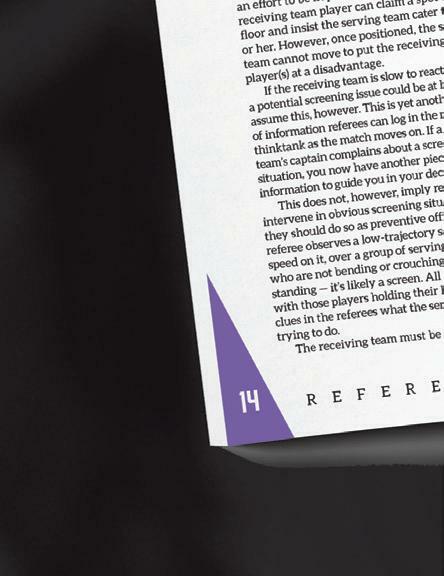



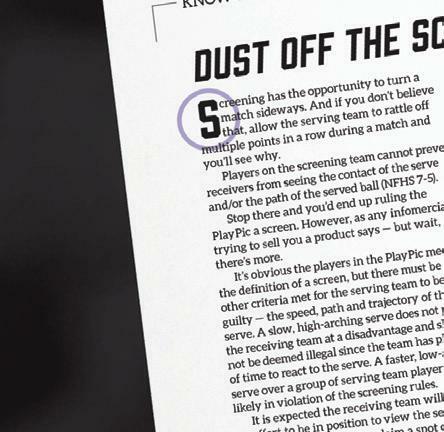




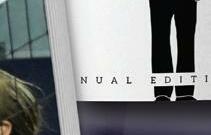






































































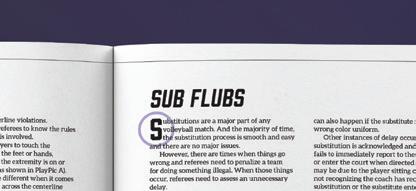







EDITION This magazine-sized annual guide features everything you need to get ready for the 2022 season. Read about the latest rules changes and points of emphasis, learn important play-calling techniques, and challenge yourself with more than 100 caseplays and quiz questions. It’s the ultimate volleyball officiating resource! Full Color 100+ Caseplays and Test Q&As Latest NFHS Rules & Mechanics Changes HandPicked Articles order today STORE. /VOLLEYball *NASO discount available. $1795 * DIGITAL PRINT $2395 COMBO $1895 * NEW for 2022 SIZE: 8”x11” PAGES: 96 GET READY FOR THE FIRST SERVE
referee abroad
By Rachel Huser
A Program Giving Soccer Referees Priceless Experiences
Referee Abroad participants come from more than 70 countries and officiate at a variety of events, including the Paris World Games.
Macauley Gibson, England

34 | REFEREE August 2022
Officiating matches with the Eiffel Tower as the background. Traveling for the first time by yourself. Navigating scrambled game schedules because of an incoming typhoon. Playing a pickup soccer match at a Chinese middle school. Connecting with family in Sweden. Forming lifelong bonds with international friends.
It all sounds like a dream, like something straight out of a feature film. But what if it wasn’t?
Gabe Billings, Joe Connolly, Sam Garelick, Josh Well and Omeed Azadpour are soccer referees from all across the United States, ranging in age from early 20s to early 30s, who participated in Referee Abroad, the program that gave them those priceless experiences and more. This is their story.
“It’s so compelling and different, getting to travel and do international games without being a FIFA referee,” Azadpour said. He is a national grade referee with U.S. Soccer and has


been a referee for more than 20 years. He started when he was just 10 years old when his father would drag him along to his games.
Referee Abroad is similar to a study abroad program for college students. The only differences are that instead of college students, it’s referees, and instead of enrolling in classes, they officiate soccer matches. The program was officially founded in 2011 by referees Daniele Curcio of Italy, Matthew Day of England and Sebastien Passel of France. Curcio and Day still oversee the program.
“We wanted to give back to the referee community,” said Curcio, president of Referee Abroad. “The experiences we provide make a difference in young referees’ lives.”
According to its website, the European-based nonprofit organization aims “to unite referees with international tournaments with the objective of expanding their refereeing experience and meeting new cultures both on and off the pitch. Referees in their own right are unique




and extraordinary, usually inspired by an internal and natural desire to follow such a passion. Pursuing refereeing abroad with colleagues from across the globe is, in our opinion, the zenith of such a passion.”
“It’s a useful program,” Curcio said. “There’s a pressing need for more programs like this.”











Referee Abroad connects referees to 30 different tournaments in 18 different countries annually. More than 800 referees participate in these tournaments with at least 70 different countries represented. Curcio often attends the tournaments and is hands-on with the referees that choose to participate.

“It’s very enriching to work with people from so many different backgrounds,” he said. “It’s an incredible experience that I deeply cherish.”
Curcio actually went out and recruited a majority of the American referees who were interviewed for this story — Billings, Well and Azadpour all decided to participate in the program after connecting with Curcio.
Referee Abroad participants pose for a photo during the Gothia Cup opening ceremony in China.
Argentina Austria Brazil Canada
Cape Verde China Croatia Czechia
COURTESY
OF DANIELE CURCIO COURTESY OF DANIELE CURCIO
Billings, originally from Chicago, became a referee because all his friends were doing it. He is now a grade seven referee — well on his way to becoming a grade six — and officiating Midwest Premier League and United Premier Soccer League matches among others. Billings became aware of Referee Abroad when he traveled to Minnesota to officiate in the USA Cup.
“I had a great time meeting referees from other countries at the USA Cup,” he said. “And I wanted to experience what it was like refereeing in Europe.”
His first experience was the Paris World Games during the summer of 2018. It was his first time traveling by himself. Shortly after Paris, Billings immediately signed up for
other tournaments. He has now been to Africa, Brazil, Portugal and Greece. In Africa, Billings officiated the Africa Youth Cup in Cape Verde. During his twoweek stay, he would referee one game a day and spend the rest of it exploring the town.
“Referee Abroad is an investment,” he said. “The knowledge and culture exposure that I got was way more valuable than a couple of hundred dollars for a plane ticket.”
Well, who hails from Texas, is another referee who has participated. He has been officiating for about nine years and is a regional referee who officiates plenty of adult matches. He found out about Referee Abroad while he was studying abroad in Milan. He personally met Curcio and joined the program shortly thereafter.



“Refereeing is already exciting for me. Doing it in another country was just amazing,” Well said. “Referee Abroad is able to give everyone the experience of a FIFA referee.”
His first tournament was the Paris World Games in 2019, a year after Billings. There, he officiated two games with the Eiffel Tower in the background during the weeklong tournament. His experience was a positive one.
“I was surprised that everyone was on the same page from a referee standpoint,” he said. “And I was pleasantly
surprised at how easy it was.”
Azadpour, originally from San Diego, shared similar thoughts.
“The referee community, at least for me, has a lot of camaraderie,” he said. “It is very similar to the military.”




Azadpour met Curcio at a tournament in Southern California. He already knew a few friends who participated in the program, and meeting Curcio only further prompted him to join.
“It’s so compelling and different, getting to travel and do international games without being a FIFA referee,” Azadpour said.
The Paris World Games was also Azadpour’s first tournament. He went in 2018 and again in 2019. Shortly after his 2019 Paris trip, he traveled to China, where he officiated in the Gothia Cup, including a U19 finals match.


When asked about the language barrier, since Azadpour didn’t speak Chinese, he said, “Everyone speaks the same language in soccer. We all just meet in the middle.”
It was a different experience for both Connolly and Garelick. Both referees joined the program without having met with Curcio first, after seeing the program online and wanting to be a part of it.
“It seemed like a really cool opportunity,” Connolly said. “So I just went for it.”









Connolly is a grassroots referee and only one assessment away form obtaining his regional badge. He attended two tournaments during the summer of 2019. First was the Paris World Games, and then he traveled to Sweden immediately after that tournament.


He worked with two Dutch referees during his first match at Paris and officiated at the Eiffel Tower Stadium.
“We had a great pregame,” Connolly said. “That first game was awesome.”
Between Gothia Cup matches, referee Sam Garelick visits the Qingdao market and tries a local delicacy — pig snout.
Gabe Billings works the lines during an overseas tournament.
Denmark England Finland France Germany Greece Hungary Italy Japan
COURTESY OF SAM GARELICK, COURTESY OF GABE BILLINGS
Connolly speaks Swedish so he had little to no trouble navigating the language barrier during his time abroad. He has family in Sweden and he was able to see them while he was officiating.





“Joining Referee Abroad was intimidating at first, but I overcame that with ease,” he said. “The experiences that I had with Referee Abroad have allowed me to work with people that I’m not familiar with and understand what the center wants and how to communicate with strangers.”

Garelick — a fellow grassroots referee who officiates high school matches, State Cup and other leagues — shared similar thoughts. He joined the program in 2019 and went to China shortly after. His first match was 7 vs. 7 and he was the only referee. Garelick said he used a lot of nonverbal communication during his time there, even with fellow referees.


Garelick officiated teams from Mongolia, New Zealand and Mexico with referees from Iran, China and Canada. He still keeps in touch with the Canadian referee. According to Garelick, they all bonded pretty quickly when they were forced
to stay inside the hotel while a Category 3 typhoon raged outside. The tournament had to postpone a few games, but everyone remained safe.
Garelick said that after the finals, all of the referees rode a bus to the local middle school and played a pickup match.
“It was such a cool experience,” he said. “I plan to keep going to tournaments for as long as I can.”
The rest of the American referees echoed similar notions. They all had such positive and





enriching experiences with Referee Abroad and they look forward to coming back to more tournaments in the future and learning more about the beautiful game.
The program is open for any referee, no matter the grade or age. Referees pay for their air fare and a tournament fee that generally ranges between $80-120. While not paid to officiate, tournaments typically provide room and board, plus transportation to and from the airport and game sites.
To the referees who are just starting out, these seasoned referees say stick with the avocation. Build on the little things. Get your friends to join. Be open-minded. Referee Abroad also offers mentoring for any referee who requests it.

“All referees need to have this experience,” Garelick said.

“I highly recommend this program,” Azadpour said. “It is priceless. Take the plunge and join the international referee community.”
“Consider this an invitation for all referees looking to travel and develop,” Curcio said. “Expect the unexpected.” Rachel Huser is a freelance writer and former youth soccer referee from Brooklyn Park, Minn.








REFEREE August 2022 | 37
U.S. referees Omeed Azadpour (left) and Sam Garelick officiated at the Gothia Cup in China.
Through Referee Abroad, Gabe Billings has worked soccer matches in Africa, Europe and South America.
Mexico Nigeria Norway
Portugal
Romania Scotland Spain Sweden United States
COURTESY
OF
OMEED
AZADPOUR,
COURTESY OF
GABE
BILLINGS
IT’S THE (NEW) LAW
Opportunities Expanded for IFAB Play in 2022-23
By John Van de Vaarst
The IFAB made six revisions to the International Laws of the Game for the 2022-23 seasons. The changes include an expanded opportunity to substitute, clarifying coin toss procedures and a revision to denial of goal-scoring opportunity (DOGSO) procedures. The changes appear in the perceived order of importance.
Law 3, Players and Substitutes
The first change is temporary in nature and may vary from competition to competition. The change allows for the use of up to five substitutes with limited substitution opportunities.
At the game’s highest level (clubs in the top division or senior “A” international teams), competition rules will permit the following:
• A maximum of five substitutes.
• A maximum of three substitution opportunities
• An additional opportunity to make substitutions at halftime.
When both teams make a substitution at the same time, it will count as a used substitution opportunity for both teams. Multiple substitutions (and requests) by a team during the same stoppage in play count as one used substitution opportunity.
If a team has not used the maximum number of substitutes and/or substitution opportunities, any unused substitutes and substitution opportunities may be used in extra time.
Where competition rules permit teams to use one additional substitute in extra time, each team will have one additional substitution opportunity.
Substitutes may also be made in the period between full time and the start of extra time, and at halftime in extra time — these do not count as used substitution opportunities. DALE GARVEY

SOCCER RULES, MECHANICS, TECHNIQUES 38 | REFEREE August 2022 COORDINATOR: JOHN VAN DE VAARST jvandevaarst@referee.com
Substitution
The IFAB now allows a maximum of five substitutes, as permitted by the sanctioning body. Teams are limited to three opportunities to substitute and may make substitutions at halftime. Mark Larson, Tukwila, Wash.
Play 1: A1 enters the matches at the 38th minute. At halftime, A2 enters the match. At the 54th minute, A3 enteres the match. At the 80th minute, team A requests to have A4 and A5 enter the match. Is this legal? Ruling 1: Yes. Up to five substitutes are permitted. The request at the 80th minute is the third substitution request. The halftime substitution does not count against the threesubstitution opportunity restriction.
Law 14, Penalty Kick
The Penalty Kick, Law 14, has one modification. The procedure has been reworded to emphasize the spirit of the Law. The change indicates “when the ball is kicked, the defending goalkeeper must have at least part of one foot touching, in line with, or behind, the goalline.”
Previously, the goalkeeper was required to have part of at least one foot on/above the goalline at the moment the penalty kick was taken. If the goalkeeper had one foot in front of the line and one foot behind the line, this was technically an offense even though there was not an advantage in doing so. This change eliminates such a position from being penalized.
Law 8, Start and Restart of Play
Language to Law 8 has been modified to read, “The referee tosses a coin and the team that wins the toss decides which goal to attack in the first half or take the kick off.” This rewording makes the Law consistent with Law 10 and indicates the coin toss is the responsibility of the referee.
Law 10, Determining the Outcome of a Match

Section 3 of Law 10 has been amended to provide confirmation that a team official may be cautioned or sent off during kicks from the penalty mark. The new language indicates “a player, substitute, substituted player or team official may be cautioned or sent off.”
Play 2: A1 is cautioned during the 56th minute for dissent. During kicks from the penalty mark, A1 complains the goalkeeper moved
improperly and demands a rekick. Can A1 receive a second caution and be ejected? Ruling 2: Yes.
Law 12, Fouls and Misconduct
Law 12 has two changes. The first deals with DOGSO and the second provides guidance on dealing with the restart of play when a player leaves the field of play to commit an offense against an outside agent.
The DOGSO change provides clarity on a handball offense that denies a goal-scoring opportunity. The change is the exception for the goalkeeper. The Law now reads: “Where a player denies the opposing team a goal or an obvious goalscoring opportunity by a handball offense, the player is sent off wherever the offense occurs (except a goalkeeper within their penalty area).”
Play 3: A1 is on a breakaway and B1, the goalkeeper, moves just outside the penalty area to defend the play. A1 shoots and B1 reaches back into the penalty area and stops the ball with the hands. Is this legal? Ruling 3: Yes. The ball was within the penalty area where the goalkeeper is allowed to use the hands.
The second change to the Law is in Section 4, Restart of Play. This change provides additional wording on where the indirect free kick should take place when a player leaves the field of play. “If the referee stops play for an offense committed by a player, inside or outside the field of play, against an outside agent, play is restarted with a drop ball unless an indirect free kick is awarded for leaving the field of play without the referee’s permission; the indirect free kick is taken from the point on the boundary line where the player left the field of play.” This change makes it clear that a free kick cannot be given for an offense against an outside agent. However, if the player leaves the field of play without the referee’s permission and then commits an offense while the ball was in play, an indirect free kick is awarded. This is for the player leaving the field without permission.
Play 4: A1 leaves the field of play while the match is in progress
BY THE NUMBER
299
The number of fouls awarded by PRO referee Joseph Dickerson in his 10 MLS matches through May 30. View more statistics like this at proreferees.com/stats/ referee-stats.
QUICKTIP
When reviewing the rules/Laws, build and maintain a strong foundation in the definition of terms section. If a match official does not understand the definitions that apply to a particular play, the official’s execution of the rule will likely collapse — and the rules/ Laws will be misapplied. Merely glossing through the glossary could leave you in a world of trouble in your next match.
SIDELINE
Deliberate/Deliberately Are Words of the Month
The UEFA Champions League Final took place May 30, with Real Madrid beating Liverpool, 1-0. In the 43rd minute, an attacking player was ruled offside despite the ball and a defender making contact as a pass moved forward, which subsequently resulted in an apparent goal.

The play was reviewed, and the decision stood as video replays indicated no defender made a deliberate play on the ball. The meaning of deliberate can be found in the IFAB glossary as, “An action which the player intended/ meant to make; it is not a ‘reflex’ or unintended reaction.”
The crew assigned to the match was: Clement Turpin (referee), Nicolas Danos (assistant referee), Cyril Gringore (assistant referee), Benoit Bastien (fourth official), Jerome Brisard (VAR), and VAR assistants Willy Delajod, Massimiliano Irrati and Filippo Meli.

REFEREE August 2022 | 39
DYLAN STEWART/IMAGE OF SPORT/NEWSCOM
TEST YOURSELF
In each of the following you are given a situation and at least two possible answers. You are to decide which answer or answers are correct for NFHS, NCAA or IFAB rules/Laws. Solutions: p. 81.
1. A1 takes a direct free kick and passes the ball back to goalkeeper A2. A2 fails to kick the ball and does not touch it. The ball enters the goal.
a. Retake the kick since no one touched the ball.
b. Award a goal for team B.
c. Restart the match with a corner kick for team B.
2. A1 is in an offside position at the moment A2 takes a shot on goal. After that, B3 (not the goalkeeper) deliberately handles the ball on the goalline between the goal posts. The ball goes to A1, who scores a goal.
a. Award a goal for team A. Caution B3 for deliberately playing the ball with the hand.
b. Offside since A1 gained an advantage. Award an indirect free kick to team B.
c. Immediately stop play when B3 touches the ball. Award a penalty kick to team A and eject B3 for DOGSO.
3. At a throw-in, during the forward motion, the ball slips out of the thrower’s hands and falls to the ground just onto the field of play. The same player picks up the ball to retake the throw-in.
a. Allow the throw-in to be retaken since the ball slipped.
b. Award a direct free kick to the opposing team for the hand ball offense (more serious of the two).
c. Award an indirect free kick for a second touch of the ball on a restart.
4. During a penalty kick, A1, a teammate of the kicker, enters the penalty area before the ball is in play. The goalkeeper saves the kick and the ball rebounds to A1 who shoots and scores.
a. Award an indirect free kick for team B at the point where A1 played the ball.
b. Allow the goal for team A.
c. Caution A1 for the encroachment.
5. During a throw-in, A1 deliberately throws the ball at B2 and plays the ball again after it hits B2 in the leg.
a. Eject A1 for violent conduct and restart with an indirect free kick for team B.
b. Allow play to continue unless the ball was thrown in a reckless manner or force.
c. Stop play, caution A1 for trickery and award an indirect free kick for team B.
to respond to a comment made by a spectator. The ball is approximately 15 yards from the incident. Ruling 4: The referee stops the match and cautions A1 for leaving the field without permission. The match is restarted with an indirect free kick for team A at the point nearest the boundary line where A1 left the field of play.
Although there are relatively few changes to the Laws of the Game for
2022-23, it is imperative that every official carefully study all of the Laws on a regular basis. A match should never be decided because a referee did not make a proper interpretation or misapplied a Law.
John Van de Vaarst, Ellicott City, Md., is a NISOA National Clinician, National Assessor and former State Level USSF Referee and Assessor. He is Referee’s soccer coordinator.
Overtime Nixed for NCAA Regular Season Play
The NCAA Playing Rules
Oversight Panel (PROP) approved three rule changes to the NCAA men’s and women’s soccer rulebook. These changes were based on the proposals submitted by the NCAA Soccer Rules Committee, which met in February.
Overtime eliminated for regular season matches. At the end of regulation time (90 minutes), if the score is tied (e.g. 2-2), the final score will be recorded as 2-2. Sudden victory overtime was eliminated. Also, for conference playoffs and postseason matches, if the score is tied at the end of regulation, two full 10-minute periods will be played. If the game is still tied after the two overtime periods, a penalty kick shootout (kicks from the penalty mark) will determine the winner. In addition, if a substitution is made by the team in the lead during the last five minutes of the second overtime, the game clock will be stopped.
Play 1: Team A leads during the second overtime, 3-2. With 5:02 left in the period, team A elects to substitute. Should the game clock be stopped when it reaches five minutes? Ruling 1: No. The clock is only stopped if the substitution request was made during the last five minutes of the second overtime.
Play 2: With 4:58 left in the second overtime period, the team in the lead elects to substitute. Ruling 2: In this instance, the clock must be stopped.
It is restarted when the ball is put into play.
Video review. Video review is being expanded to include whether a foul occurred inside or outside of the penalty area.
Play 3: A1 receives a long pass and is moving quickly toward goal. Since this is a quick reversal, the referee is sprinting to obtain a good position. A1 is tripped and is lying in the penalty area. The referee sounds the whistle, points to the spot of the foul — indicating a direct free kick and moves toward a spot just outside the penalty area for the location where the ball is to be placed. The referee observes the assistant referee moving to a position for a penalty kick. Ruling 3: Since there is a question about whether or not to award a penalty kick, the referee now can utilize video review to determine whether it is a penalty kick rather than a direct free kick.
Protests. The ability to protest a match has been modified to include the review of violent behavior II and fighting red cards. The protest, including video of the incident, must be filed within 48 hours of the completion of the game (the same as other protests) and be submitted by the conference office or coordinator of officials.
The scope would be limited to changing a violent behavior II or fighting red card (two-game suspension) to a violent behavior
40 | REFEREE August 2022 SOCCER
I red card (one-game suspension). A committee consisting of the NCAA men’s and women’s soccer secretary-rules editor, NCAA national coordinator of soccer officials and one NCAA soccer regional advisor who is not affiliated with the team, conference or region will consider the protest and render a decision.
Play 4: A1 is ejected for pushing B2 to the ground. The referee indicates in the scorebook the incident is violent behavior II. The coach feels the incident should have only been violent behavior I. Ruling 4: The coach may go through proper channels to have the conference office
or coordinator of officials file an official protest.
The NCAA Men’s and Women’s Soccer Rules Committee initially recommended a change to the substitution rule that would have not permitted a re-entry during the second half of play. However, after further consideration and feedback from the membership during the comment period, the committee members agreed to have further discussion on the subject before recommending implementation.
All soccer officials must realize the importance of studying the entire rulebook. It is important to
Offside Revisited
With the 2022-23 rule change adopted by the NFHS, all three rule/Law organizations (NCAA, NFHS, IFAB) now have the same interpretation for judging whether a player is in an offside position. IFAB 11.1 states: “The hands and arms of all players, including the goalkeepers, are not considered. For the purpose of determining offside, the upper boundary of the arm is in line with the armpit.” The NCAA has a slightly different definition. NCAA 11.1.2 states: “The position of
any part of the player’s head, body or feet will be the deciding factor, not the player’s arms.” The NFHS will add to this year’s rulebook a similar statement to the NCAA’s. The only difference will be the sentence ends with this additional language: “below the bottom of the armpit.”
In PlayPic A, the attacker’s hand is just slightly past the defender’s elbow and the remainder of the body is even or slightly behind the opponent. In this case, No. 3 is not in an offside position since the hand
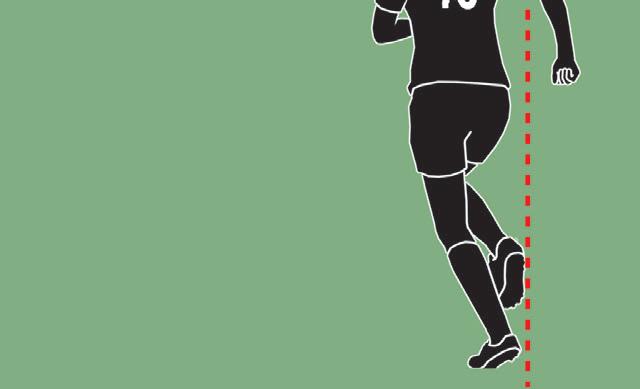




keep up with the changes as well as all the rules and interpretations. A misapplication of a rule can result in administrators notifying conference or local assigners of the issue and create future problems for the official.
PROP was formed as an association-wide committee (representatives from all three divisions) in 2003 to review playingrules proposals, especially those involving player safety, financial impact or image of the game, and to review playing rules issues, including implementation of playing rules proposed by playing rules committees.
being ahead of the defender is not considered when making an offside decision.

In PlayPic B, No. 3’s shoulder is ahead of the arm of defender No. 10. Since the shoulder is above the armpit, it is used to determine offside. The defender’s arm is not considered. No. 3 is in an offside position and if an advantage is gained, offside would be called.
Finally, in PlayPic C, once again a portion of attacker No. 3 is nearer the goalline than defender No. 10.
REFEREE August 2022 | 41
A B C
CASEPLAYS
Fair Challenge?
Play: A1 runs with the ball into team B’s penalty area. B2 challenges A1 and gains possession of the ball without committing any offense. B2 then tries to shield the ball (which is within playing distance) by extending the arms. In this motion, B2 strikes A1’s face with the elbow. Ruling: The referee awards a penalty kick for team A. Depending on the severity of the elbow, B2 may be cautioned or ejected (NFHS 14-1-1; NCAA 14.1.1; IFAB 14).
Benched and Now Ejected Play: In the first half of play, A1 makes a hard tackle on B2. The referee stops play, cautions A1 and awards a direct free kick for team B. At halftime, A1 is substituted for and is now sitting on the bench. During the second half, A1 yells out at the referee in a disrespectful manner regarding a decision. Neither team has a distinct advantage to allow play to continue. Ruling: The referee stops play, displays a yellow card (dissent), followed by a red card and A1 is ejected from the match (NFHS 12-8-2c; NCAA 12.7.4.7; IFAB 12).
Last Resort Play: B1, the goalkeeper, leaves the penalty area because two attackers (A2 and A3) are running toward team B’s goal. A2 attempts to pass the ball to A3, who is not in an offside position. B1 deliberately touches the ball with the hand/ arm and intercepts the pass. The referee determines B1 is guilty of denying a goal-scoring opportunity (DOGSO). Ruling: B1 is ejected for DOGSO. A new goalkeeper may come into the match and a field player can subsequently leave or a field player may put a goalkeeper’s jersey on and become the new goalkeeper. Regardless, team B will now play with 10 players (NFHS 12-8-2d-3; NCAA 12.7.4.3; IFAB 12.3).
Remember, the arm is not considered when judging offside. Therefore, since the leg and hip of No. 3 are ahead of the play and nearer the goal line, offside is the correct call.
In order to make the proper call in all of these examples, the assistant referee must be even with
the second-to-last defender, No. 10. If the assistant referee is behind or ahead of the play, the angle of vision causes the assistant referee not to be able to accurately determine whether an offside has occurred or the play is legal and should continue.
Piece It Together
When play is stopped and the officiating crew is reviewing a decision, the process is similar to a team of people putting together a jigsaw puzzle.
One person might be best at putting the border together, another could identify a pattern and the third focuses on keeping the team on track.
When pausing momentarily to piece together a play, officials must understand the role they serve. An assistant referee on the backside of a play will not be much help in determining if a penalty kick should be awarded based on the position of the infraction, but that assistant referee could be of assistance in picking up the number of the guilty party.
While the referee’s focus should always be on the primary coverage area, it is impossible to keep track of 22 players at once. A referee who is able to trust the assistant referees assigned to the match is best set up for success.
At the end of a playing action while transitioning to the next play, it is possible a player may decide to engage in extracurricular activities. Because of this, a vigilant approach to monitoring the proper coverage area is essential for each member of the crew. Just as a puzzle locks together, if a member of the crew fails to maintain a strong approach to his or her responsibilities, the puzzle will fall apart.
However, if an assistant referee knows a rule is being misapplied, the assistant referee should speak up to the other crewmates. Withholding information until the crew meets in the locker room at halftime or at
the end of the game is not fair to the other members of the crew, and ultimately damages the integrity of the game.
One of three likely scenarios will occur: The assistant referee provides critical information to save the crew and the referee owes that official dinner; the assistant referee provides correct information to the referee and the referee opts not to take it; or the assistant referee provides incorrect information to the referee and the referee opts not to take it.
In the last two scenarios, it is important to point out it is ultimately up to the referee to make a final decision on the outcome. Part of being a good crewmate means providing the referee with any such information that will help a proper decision be made.
Match officials in the role as a referee must welcome this information. Ignoring key advice from an assistant referee because of an ego damages the continuity of the crew and ultimately sets the crew up for failure. Even as described in those last two scenarios, pausing for just a moment can help avoid a doomsday scenario where the crew misapplies or misinterprets a rule/Law.
However, it should be remembered to keep this in good balance, it is not necessary for the crew to “get together” numerous times per match.
Whether this communication takes place face-to-face or through comm systems (based on the mechanics for the match), it is necessary to maintain open lines of communication in the crew to piece the puzzle together.
42 | REFEREE August 2022 SOCCER
VISIONINACTION
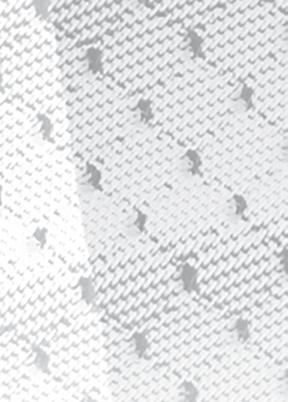
Free Officiating Recruitment Videos


WE’RE ALL IN THIS TOGETHER!
THESE ORGANIZATIONS SUPPORT OFFICIALS
I





f you haven’t visited the “Say Yes to Officiating” website, you’re missing some of the most exciting and cutting-edge tools and resources available anywhere for recruiting new people into sports officiating.

Currently the site is featuring a series of videos, commercials and Public Service Announcements (PSAs), that showcase all the positive reasons to become an official.
Springing out of last year’s 14-minute mini-documentary titled “Say Yes to Officiating,” which featured five different sports officials all working different sports and competitive levels and each one at a different stage in their officiating careers, the recruitment videos come in multiple sizes and formats.
Highlighted in the piece are not only high school and collegiate officials, but former NFL referee and NCAA D-I basketball official Gene Steratore, who now serves as an officiating analyst on CBS Sports broadcasts.
Drawing on the support of its many officiating partners, NASO allocated funds to create and produce the film, which can be found on the Say Yes to Officiating website, in conjunction with Dom Kegel Media, based in Racine, Wis.
The documentary was an immediate hit, and NASO has
since worked directly with dozens of state associations, large officiating groups and other sports organizations to get the video out to as many sports-minded prospects as possible. In many cases, the videos are also co-branded with the group’s logo alongside the “Say Yes to Officiating” logo.



NASO has produced the recruitment videos as 30-, 60-, and 90-second versions that are perfect for running during local, regional and national televised games, as well as online streaming matches and social media. If your group is interested in co-branding those videos with your own logo, just reach out to NASO at the email address below.















Additionally, there are also volleyball versions
of the recruitment videos produced in conjunction with the Pac-12 that are available for free downloading and distribution. More video clips will continue to come from NASO and all are available on the “Say Yes to officiating” website to stream and download. NASO encourages all sports organizations as well as individuals who care about the future of officiating to share those videos and the Say Yes to officiating messaging far and wide.
For more information on how to use the videos as well as potential partnering and co-branding opportunities, please contact Jim Arehart
jarehart@referee.com.

ATTENTION REFEREE MAGAZINE SUBSCRIBERS
It’s time to join the rest of us in the National Association of Sports Officials. Not only will you continue to receive the world’s #1 officiating publication, you’ll enjoy all of the additional benefits NASO members enjoy. Go to naso.org/upgrade2022 to join NASO for the special introductory price of $114 and receive these two FREE books!

NATIONAL ASSOCIATION OF SPORTS OFFICIALS
FOR NASO MEMBERSHIP INFORMATION OR TO SIGN UP, GO TO NASO.ORG, CALL 262-632-5448 OR EMAIL CSERVICE@NASO.ORG
@
$ 114 JOIN TODAY For this and many more recruitment tools, go to: SAYYESTOOFFICIATING.COM
LINEUP LOGISTICS
Know the Differences in Card Infractions
By Brad Tittrington
During the course of a game, and a season, a lot of things can go wrong when it comes to lineup cards. One of those situations involves an inaccurate lineup card. It is important to know what constitutes an illegal lineup card and how it differs from other violations.
An inaccurate lineup card is one in which a starting player or substitute is listed incorrectly, such as an inaccurate name, inaccurate number or wrong position number. Too often, coaches, and even some umpires, confuse this situation with an illegal substitute (which will be described later). The penalties are much more severe for an illegal substitute so it is important for umpires to know the difference. One thing to keep in mind when it comes to an inaccurate lineup card is the player’s name takes precedence over the uniform number. If the player’s name is listed correctly, but the uniform number is listed incorrectly, it’s the name that matters. For example, if Jones is listed as the leadoff batter and the number listed is No. 1, but she is actually wearing No. 2, that spot on the lineup card belongs to Jones, not to whoever is wearing No. 2. However, the lineup card is still inaccurate and susceptible to a penalty if brought to the attention of the umpire. For purposes of this article, we are only going to examine if the number on the lineup card is inaccurate.
When it comes to the penalty for an inaccurate lineup card, it varies by code. In NFHS, the first offense is simply a warning to the offending
Ellen Degler, Chanhassen, Minn., takes a lineup change from a coach. It is important to know the differences in lineup infractions to make sure you enforce the proper penalty if one of them occurs and avoid a potential protest.

SOFTBALL RULES, MECHANICS, PHILOSOPHY 44 | REFEREE August 2022 EDITOR: BRAD TITTRINGTON btittrington@referee.com
DENNIS
HUBBARD
team. The next occurrence results in the head coach of that team being restricted to the dugout (3-1-3 Pen.).
In NCAA play, the penalties vary depending on the time it is reported. If the offensive team reports the infraction on its own player or if the defensive team is in violation but the player has not yet made a play (or if the offending player has made a play but another pitch has been thrown to a following batter) the coach may correct the information without penalty. One thing to note — if the pitcher or catcher is in violation, a pitch is considered a play (8.3.2 Eff. a).
If reported by the offensive team immediately after the offending player makes a play on defense, the card is corrected and the offensive coach can take the result of the play or nullify the play and have the batter assume the ball and strike count attained before the infraction was reported and each baserunner returns to the last base occupied prior to the pitch (8.3.2 Eff. b).
If reported by the defense during the offending player’s turn at bat, the lineup card is corrected without penalty and all runs scored and bases run are legal and the batter remains at bat (8.3.2 Eff. c)
If reported by the defense immediately after the offending player’s turn at bat, before a pitch is thrown to the next batter and before all infielders have vacated their position, the offending player is ruled out, all results from the batted ball are nullified (runners are returned to the last base occupied prior to the pitch), and the next batter due up is the batter who immediately follows the offending player (8.3.2 Eff. d).
If reported by the defense after the offending player’s turn at bat and a pitch has been delivered to the following batter, the statute of limitations has expired and there is no penalty. The card is corrected and all play stands (8.3.2 Eff. e).
If the inaccurate lineup card is reported by the defensive team while the offending player is on offense as a pinch runner or the tiebreaker runner, and it follows a pitch in which the baserunner has advanced one or more bases and before the next pitch
is thrown, the offending player is called out, any advancement by other runners is nullified and the card is corrected. In all other cases involving runners who have not batted but are baserunners, the card is corrected without penalty (8.3.2 Eff. f, g).
In USA Softball and USSSA, the penalties are the same for an inaccurate lineup card involving an inaccurate number. In both codes, there is no penalty. The umpire will simply correct the card without penalty (USA Softball 4-1a-1; USSSA 5-1, 5.C).
Play 1: In the top of the eighth inning, using the tiebreaker rule, the offensive coach puts Smith in to run at second base. Smith is listed as No. 1 on the lineup card, but is actually wearing No. 11. The defensive coach alerts the umpire to the infraction (a) prior to a pitch being thrown to the leadoff batter, (b) after three pitches have been thrown to the leadoff batter, or (c) after the leadoff batter hits a single, which scores Smith, but before a pitch is thrown to the next batter. Ruling 1: In (a) and (b), according to NFHS rules, the lineup card will be corrected and the offensive coach is given a warning. In NCAA, USA Softball and USSSA, the lineup card is corrected and there is no penalty. In (c), according to NFHS, the coach is given a warning and all play stands. In NCAA, Smith would be ruled out, the batter remains at first and the lineup card is corrected. In USA Softball and USSSA, there is no penalty and the lineup card is corrected.
Play 2: After one pitch, the offensive coach alerts the umpire the leadoff batter is wearing a replacement uniform due to blood and the player’s number should be No. 3 instead of No. 11, which is listed on the lineup card. Ruling 2: In NFHS, the number is corrected on the card and the offensive coach is given a warning. In NCAA play, since the offensive coach corrected it before the at-bat was completed, the card is corrected without penalty. In USA Softball and USSSA, the card is corrected without penalty, regardless of when the infraction occurs.
Play 3: The DP is batting in the third spot in the batting order. In the
DID YOU KNOW?
The Women’s College World Series expanded from seven days to nine days in 2022. The expansion eliminates the need for doubleheaders for teams that lose the first day of competition. Teams that advance to the finals also receive a day off before the best-of-three championship round begins. This year’s competition had 10 umpires: Mike Bartling, Leah Bowen, Ron Burkhardt, Mike Burwell, Paul “Smokey” Edds, Naomi Erdahl, Fred “Bubba” Ewald, Terry Holt, Keith Kearney and Chris Nabors.


QUICK TIP
Never allow ground rules that conflict with official playing rules. For example, if a fence is an extremely short distance from the plate, a ground rule may be proposed to award the batter two bases for a ball that goes over the fence as opposed to a home run. Or it may be suggested that three bases be awarded if the balls lands in a drainage ditch a far distance away from the plate. There is no provision in the rules to allow these modifications — don’t allow them.
TOOLS
Smitty Oversized Softball Umpire Ball Bag


Tired of running out of softballs and constantly having to ask a coach for more. One way to solve this problem is to use the new Smitty Oversized Softball Umpire Bag. The largest ball bag on the market will hold up to five softballs and is 2.25” larger than standard ball bags. The ball bags also have three interior pockets to house your indicator, pens and pencils, brush and wallet. The bags can be found at umpattire.com and sell for $14.99 each.

REFEREE August 2022 | 45
TEST YOURSELF
Each of the following includes a situation and possible answer(s). Decide which are correct for USA, NFHS, NCAA or USSSA rules and which might vary. Solutions: p. 81
1. With R3 on third and no outs, B2 hits a fly ball to left field that’s caught by F7. R3 positions herself behind and not in contact with the base to gain a running start and touches third base after the catch. R3 arrives safely at home.
a. There is no violation providing R3 touches third after the caught fly ball was first touched.
b. Any violation would be considered an appeal play.
c. The ball is dead and R3 is ruled out.
d. The ball remains live and R3 is ruled out.
2. B1 swings and nicks the first pitch sharply and directly toward F2. The ball deflects off the catcher’s chest protector before it is secured in F2’s glove.
a. Foul tip, ball remains live.
b. Foul ball, ball is dead.
c. Catch, batter is out.
3. With R2 on second base, B2 hits a pop-up in the infield to the left side of second base. The wind pushes the ball toward second and the ball hits R2, who is on the bag, and F6 ends up crashing into R2. The ball drops to the ground. R2 merely stood on second base and did not intentionally make contact. B2 ends up arriving safely at first.
a. No penalty. The ball remains live with B2 on first and R2 on second base.
b. Interference by R2. The ball is immediately dead, R2 is ruled out and B2 is awarded first.
c. Interference by R2. The ball is immediately dead, R2 remains at second base and B2 is called out.
d. Interference by R2. The ball is immediately dead and both R2 and B2 are called out.
4. With R3 on third and R1 on first and one out, B4 hits a fly ball in the gap in the right field. F9 races over and makes the catch. R3 remained on the bag and tagged up on first touch. R1, thinking the ball would hit the ground, was off on contact. F9 throws the ball in to first base ahead of a sliding R1. R3 had crossed the plate at the time R1 was ruled out at first.
a. This is a timing play and R3’s run counts.
b. Since R1 did not legally tag and is the third out of the inning, R3’s run does not count.
fourth inning, the offensive coach puts the flex in to bat in the fourth spot in the batting order. The flex reaches first base safely. Prior to a pitch being thrown to the next batter, the defensive coach tells the umpire the flex batted in the wrong spot. Ruling 3: Ideally, the umpire would not have allowed the offensive coach to make this substitution as the flex is required to bat in the DP’s spot in the lineup. By allowing the flex to hit in another spot, this becomes an illegal substitution, not an inaccurate lineup card. In NFHS, the player is ruled out and restricted to the dugout for the remainder of the game (3-4-2 Pen.).
In NCAA, the player is called out and ejected (8.3.4.2.3b Eff.). In USA Softball, the player is called out and disqualified for the remainder of the
game (4-6c-3, 4-6f-2). In USSSA, the player is ruled out and the player and head coach are both ejected (5-7d Pen.).
It is important for umpires to know the difference between an inaccurate lineup card and other issues that may crop up, such as unreported substitutes or illegal substitutes. The penalties for an illegal substitute are much stiffer and depending on the code, could lead to an ejection. Make sure you take the time to study up on this rule and its associated penalties so you can quickly fix the error and move on without much difficulty.
Brad Tittrington is an associate editor for Referee. He umpires D-I softball and officiates women’s college and high school basketball, college and high school volleyball and high school football.
When Infield Fly and Interference Collide
By Carlos A. Santana
Separately, the infield fly and interference rules continue to be a subject of discussion in many umpire meetings and training sessions. Understanding these rules independently can take some time. What happens when you have both on the same play?
Here is a scenario that could happen in any game. Runners on first and second with less than two outs. The batter hits a pop-up (a) near the first-base foul line or (b) between second and third base. In (a), as F3 is attempting to play the batted ball, the batter-runner interferes (as shown in the PlayPic on the next page). In (b), as F6 is attempting to play the batted ball, the runner from second base interferes. Let’s break down the rules and answer these scenarios as we go through them.
Infield Fly Rule
All codes agree any time there are runners on first and second or the bases are loaded, and there are less than two outs, the infield fly rule is
in effect. In applying the infield fly, the umpire must consider several factors prior to the pitch. Some of these include the effects of the wind or the sun. Even the skill level of the players can play a role in determining the application of the rule. After the ball is batted, the umpire must be prepared to observe these factors, and many more, to quickly provide the information to the teams and the crew. Let’s assume for the purpose of this article that in both (a) and (b), the umpire has made the judgment the infield fly rule applies. This allows us to focus our discussion on the infield fly rule.
Interference Rule
All codes also agree interference is the act of an offensive player or team member which impedes, hinders or confuses a defensive player attempting to execute a play, in this case attempting to field a batted ball. In (a) and (b), the umpire has made the judgment interference has occurred. This allows us to focus our discussion on the interference rule.
SOFTBALL 46 | REFEREE August 2022
Fair or Foul
For the infield fly rule to be applied, the batted ball must be fair. Interference, however, can occur with both a fair and a foul batted ball. A legally batted ball is fair if it is in fair territory when a runner, who is in fair territory, interferes with a defensive player’s attempt to field a batted ball. A legally batted ball is foul if it is in foul territory when a baserunner interferes with a defensive player’s reasonable chance to make a play on the ball. Although these definitions do not specifically include “over” fair or foul territory, it is universally understood that these territories extend above the playing surface.



Interference After Infield Fly
Now that we have made the judgment both infield fly and interference rules are to be applied, the question becomes how to apply them and where to place the runners. As stated above, all codes agree the batter is out when hitting an infield fly. All codes also agree a runner is out when interfering with a fielder attempting to make a play on a batted ball.
Two key questions must be addressed to rule properly. The first is, “When does the batter who hits an infield fly become a retired runner?” This is important in determining whether you have “interference” or “interference by a retired runner,” which have different penalties. The second question is, “At what point is the status of the ball determined on a fly ball?” This is crucial because an infield fly has to be a fair ball. Interference, on the other hand, can be applied on fair or foul balls.

The NCAA rulebook is the only one that specifically addresses this scenario. If interference occurs during the flight of a potential infield fly, the ball is immediately dead and the plate umpire shall judge if the ball is in fair or foul territory. If fair, the batter shall be declared out and if foul, infield fly would not have applied so the batter is returned to the batter’s box and a foul ball assessed to their count. In any case, the violator is out and runners return to the bases occupied at the time of the pitch (11.16 Note 7). The NCAA casebook also provides some clarity.
Play 1: With the bases loaded and no one out, the batter hits a declared infield fly right in the baseline between first and second base. The runner, on her return to first base following her leadoff, runs into the first baseman attempting to field the fly ball. In (a), the runner from third base tags and advances home; (b) the runners on second and third bases do not attempt to advance. In either case, is this interference even though the runner contacts the fielder who is already credited with the put out and is not making an additional play? Ruling 1: In both (a) and (b), the batter is out on the infield fly and the ball is immediately dead when the baserunner interferes with the first baseman making the catch. The runner from first base is out on interference and the other baserunners must return to the bases held at the time of the interference (AR 12-53).
USA Softball also provided a clarification in June 2015.
Play 2: R1 on first, R2 on second base, one out. B4 hits a high fly ball to F6 who is in the baseline when R2 runs into F6. In (a), contact with F6 was before the ball was touched and (b) contact with F6 was after the ball was touched and the ball dropped. Ruling 2: In both (a) and (b), a dead ball should be called when R2 runs into F6 and R2 called out for interference (8-2f1). On this play, the infield fly rule is in effect. In (a), when R2 runs into F6, the status of the ball is fair and should be treated as such. In (b), when the ball is touched by F6 in fair territory, the ball becomes fair. In both cases, B3 should be called out due to the infield fly rule (8-2i).
What if the batter-runner is the one who commits the interference on this play? By interpretation from the leaders of each of the organizations, the batter is ruled out for interference and the ball is dead. You would not be able to get two outs on the batter in this situation by enforcing both the infield fly rule and interference. The interference takes precedent and is the only out you’d get on the batter. It would be extremely rare in this instance to get a second out unless the umpires determined the interference was intentionally done to prevent a potential double play.
Further Clarification



In looking back at the initial scenario proposed at the beginning of the article, the batter-runner becomes a retired runner when all the elements of the infield fly are satisfied. This means the batted ball must be deemed to be fair and catchable with ordinary effort by an infielder. In a scenario involving a fly ball, the ball status is not immediately determined. However, the ball becomes dead at the time of the interference. Therefore, the ball status is also determined at the time of the interference. At that time, if the ball is over fair territory, it is a fair ball and the batter is out. If the ball is over foul territory, it is a foul ball. In either case, the runner committing the interference would be out.
Any time there is an infield fly situation, the umpires must be ready to assess quickly all the factors that combine when the ball is batted in the infield. A good pregame discussion is vital to understanding how the crew will handle this situation. This play creates a situation where many things will happen in a matter of seconds. It’s crucial that the crew not give conflicting signals. Only in knowing all these things can the crew properly adjudicate this scenario.
Carlos A. Santana lives in Honolulu. He officiates NCAA, NFHS and USA softball as well as NFHS basketball.
REFEREE August 2022 | 47
CASEPLAYS
Ball Slips From Pitcher’s Hand
Play: With R2 on second, one out and a 1-1 count to the batter, F1 begins a pitch to the batter. As F1’s arm begins the backswing, after the hands have separated, the ball slips out of her hand and lands in the back of the pitching circle. R2 tries to advance to third as F1 picks up the ball and fires it to F5. F5 tags R2 before she reaches the base. Ruling: In all codes, since the hands have separated, this is considered a pitch. The ball remains live and all runners may advance at their own risk. R2’s out at third base would stand and the count to the batter would be 2-1 (NFHS 6-2-6; NCAA 10.7.2 Eff.; USA Softball 6A-3p Eff.; USSSA 6-1m).
Batter Interference?
Play: With R2 on second and no outs, F1 delivers a pitch to B2. B2 fakes a bunt attempt and intentionally misses the ball as R2 tries to steal third. B2 takes a step back, still remaining in the batter’s box, and is hit by F2’s attempted throw to third base. The plate umpire rules no interference as the batter remained in the batter’s box. Ruling: Incorrect ruling in all codes. The batter’s box is not a sanctuary when it comes to interference. Since the batter actively interfered with the catcher’s throw, interference on the batter should be ruled. In NFHS, USA Softball and USSSA, the ball is immediately dead, the batter is ruled out for interference and the runner shall be returned to second base (NFHS 7-4-4 Pen.; USA Softball 7-6t Eff.; USSSA 7-12 Pen.). In NCAA, it is a delayed dead ball and the defensive team can take the result of the play or the batter is out and the runner returned to second base (11.20.2 Eff.).
Fake Tag?
Play: R1 tries to advance to second base on a hit-and-run. B2 hits a ball to center. R1 does not see where the ball is hit. F4 simulates fielding a line drive, which causes R1 to slide into second base. Ruling: Legal play. Simulating fielding a batted ball does not constitute a fake tag and play should continue without penalty (NFHS 2-21; NCAA 9.5.3.5; USA Softball 1-Fake Tag; USSSA 8-13c, 11-2a).
Block Charges
In an ideal world, all softball fields would have fully enclosed dugouts. This would prevent coaches from ever being out of the dugout to give signs. However, umpires are lucky if some of the fields they work on even have proper dugouts. And at some tournaments, the tournament directors allow buckets to be out of the dugout because there are no sightlines for the catchers to see their coaches inside the dugouts at some complexes.
So, what does that mean for umpires? Well, aside from liability issues for allowing coaches out of the dugouts, umpires must know the rules for blocked balls and interference, and how to adjudicate them properly. If it is not a tournament director directive, umpires should get coaches out of live-ball territory and keep them in the dugouts to avoid these issues, but that is not reality. Coaches will continually creep toward the field
and umpires may not be aware they are in a live-ball area. Next thing you know, a thrown ball ricochets off the bucket or a fielder trips over a coach’s foot while trying to catch a pop up.

First, let’s look at blocked balls and the penalties associated with those. A blocked ball is a live ball which is touched, stopped or handled by a person not engaged in the game; or touches any object which is not part of the official equipment or playing area (such as a bucket).
The easiest thing to remember about a blocked ball is the team at fault cannot benefit from blocking the ball. If a thrown ball becomes blocked by the defensive team, the ball is dead and runners are awarded two bases from the time of the release of the thrown ball. If the ball contacts the offensive team and the ball becomes blocked, the ball is dead. If no play was obvious, no one is called out and runners must return to the last base touched at the time the ball becomes
When coaches sit on buckets outside of the dugout, they are ripe for causing blocked balls and interference. It is important for umpires to know what the penalties are if a coach blocks a live ball or interferes while out of the dugout.
SOFTBALL 48 | REFEREE August 2022
DALE GARVEY
dead. If the blocked ball prevented the defense from making a play, interference should be ruled and the runner being played on (NFHS and USA Softball) or the runner closest to home at the time the ball became blocked (NCAA and USSSA) is ruled out. All other runners must return to the last base touched at the time the ball became blocked (NFHS 2-2-3, 5-1-1g, 8-4-3e, 8-6-15; NCAA 9.9, 9.10, 9.11, 12.12.7.2, 12.12.8.3, 12.17.3; USA Softball 8-5g-3; USSSA 8-14c, 8-17).
If it is a pitched ball that becomes blocked, the runner would be awarded one base or interference would be called if the offensive team prevented an obvious play from being made.



If a batted ball hits the offensive team members in foul territory, it would be a foul ball if no play was obvious, and interference if the umpires deemed a player had a chance to make a play on the ball.






















Play 1: With runners on first and second, both stealing on the pitch,










the pitched ball gets by the catcher and rolls toward the offensive team’s dugout. An assistant coach, sitting on a bucket, picks up the ball as the catcher goes to retrieve it. The runner from second had just rounded third and was attempting to try to reach home and the runner from first had rounded second and stopped. Ruling 1: In all codes, the ball is dead. If the umpires ruled the catcher had an opportunity to make a play on the runner on third, the runner who started on second would be ruled out and the runner who started on first would be returned to second. If the umpires ruled the catcher did not have an opportunity to make a play, the runners would be placed on second and third.
Play 2: With a R1 on first, B2 singles to right. R1 attempts to go to third and F9 throws the ball wildly to third. The ball ends up rolling toward the dugout and hits a bucket the pitching coach was sitting on and the ball is prevented from entering
the dugout. Ruling 2: The ball is blocked once it hits the bucket and is ruled dead. In all codes, the runners are awarded two bases from their location at the time of the release of the throw by F9. In this case R1, who had already advanced beyond second, would be awarded home. B2 would be awarded second (assuming B2 had not yet reached first on the release of the throw). If B2 had already attained first before the release, B2 would be awarded third base.

The easiest thing to do to avoid having to remember the blocked ball rules is to keep team members and loose equipment in the dugout. It will save a lot of headaches and arguments. However, even if you do your job, some coaches or players will get excited and come out of the dugout while the ball is live and you may have to rely on your rulebook knowledge to nail these plays.



ready when hit with the unexpected.

Be
Great breakdowns of the NFHS softball rules for the trickiest situations you will face. • Appeals Batting Out of Order Illegal Pitches Obstruction Substitutions And More! learn more at STORE. /sofTBALL *NASO discount available. DIGITAL PRINT $2095 COMBO $1595 * Size: 5.5” x 8.5” Pages: 80 $1395 *
GETTING
History Made in Virginia
By Brad Tittrington
In the year that celebrated the 50th anniversary of Title IX, it was only appropriate for four Virginia referees to make some history of their own.
On March 10, Chelisa Painter, Danyelle Smith, Monnazjea FinneySmith and Derricka Henry (alternate) made history, believed to be the first all-female crew to work a high school boys’ state championship game in the nation. The historic occasion took place at Virginia Commonwealth University as Cave Spring beat Petersburg, 76-75.
“When I found out women were going to work the boys’ state tournament, I was taken aback,” Henry said. “I was excited to be a part of the crew and a part of history because not everybody gets that call. You can’t make history twice. It was done once and I was happy to be a part of it with these lovely ladies.”
The four officials had to put history aside for a little bit as they had a game to officiate. While they took in the moment before and after the game to reflect on their accomplishment, once the ball went up, it was just another game.
“Getting to the gym up until tip-off, it was just nervousness, excitement,” Finney-Smith said. “Just wanting to do well. Once the ball went up, everything went out. We just stayed focused and enjoyed the moment, enjoyed the entire process.”
For Painter, being on the court helped ease the nerves of the moment.
“I always forget the element we are women working a boys’ game,” she said. “It is just a normal game, at least for me. I don’t want to take away from our accomplishment or anything like that, but we definitely attacked the game just like an official. I would do it again and again and again.”
Ingish Earns Kohl Award
The Herb Kohl Educational Foundation selects 100 teachers every year from the state of Wisconsin for its prestigious Teacher Fellowship Awards. In April, Waterford Union High School teacher Ashley Ingish was honored and received a $6,000 grant.
Ingish is not only a physical and health education teacher at the high school, she also serves as the girls’ volleyball coach. She was honored, however, for her initiative to write the curriculum for and implement a sports officiating class for students at the school. Once students complete her class, they are certified to officiate high school athletic contests in multiple sports.
In the program’s first year, more than 70 students enrolled in the course and earned certifications, and the program has become a model for other schools.
“Ashley exemplifies what it means to be a great teacher,” Waterford Union High School Superintendent Lucas Francois told the Waterford Post. “She cares deeply about her students and provides them with incredible learning opportunities every day.”
Ballard’s Busy Day
All four women have long lines of basketball experience, as all played collegiately and two played professionally. As for officiating, the four have more than 20 years of experience, including one working NBA G League games, one being observed by the NBA and one working collegiately in the MEAC.

The momentous occasion had been in the works for a couple of years as NBA referee Tony Brothers, who also serves as commissioner of the Virginia Basketball Officials Association, worked to pull it all together. However, with the pandemic, the occasion had to wait. When the opportunity arose this year, the four officials found themselves in the spotlight.
Painter stated it would be easy to be fearful with 7,000 people in the stands, and none of them cheering for the officials. But she said, “You faced your fears being triumphant through unknown adversity. It is definitely something we will never forget.”
And the impact of helping to break through the barriers by being the first to do something is not lost on them.
“For us as females to go out there and show them that it still can be done, it will inspire the next generation that will come,” Smith said. “I see it growing once the numbers start to increase. And beyond basketball, hopefully we can grow on other levels. Get more women into professional officiating and overseas. There’s a place for women in sports.” Brad Tittrington is an associate editor for Referee magazine.
March 9, 2022, will always be a special day for Edmond, Okla., basketball referee Kamron Ballard. He was scheduled to work the Oklahoma state basketball tournament for the first time. However, it was what was happening off the court that made this day more special.
Ballard’s wife, Elisabeth, was at the hospital, expecting the arrival of their third child (Easton) when Ballard left to work his first tournament game. As soon as that game finished, Ballard received a text from his wife letting him know it was time for the baby to arrive.
“I rushed to the hospital as quick as possible,” Ballard told KFOR-TV. “I had about 20 minutes to spare.”
After the arrival of Easton, and once everyone was settled, Ballard returned to State Fair Arena to work the second game of the tournament.
COURTESY OF TONY BROTHERS
From left: Virginia referees Chelisa Painter, Danyelle Smith, Derricka Henry and Monnazjea Finney-Smith made history on March 10 when they are believed to be the first all-female crew to work a boys’ state championship basketball game.
SOURCE: MYRACINECOUNTY.COM
SOURCE: KFOR-TV (OKLAHOMA CITY)
IT RIGHT INSPIRATION, MOTIVATION, ELEVATION 50 | REFEREE August 2022 Have you heard an inspirational or motivational officiating story? Send your ideas to GettingItRight@referee.com Send
rules updates to enhanced video plays to best practices and in-depth analysis, this package gives you everything you need to be fully ready for the























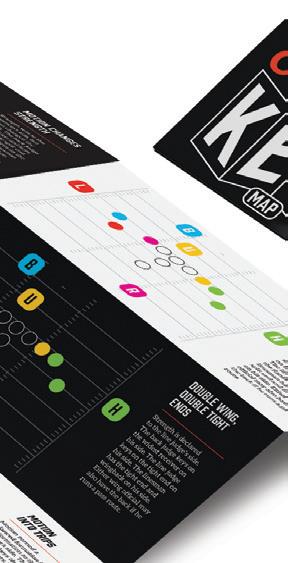












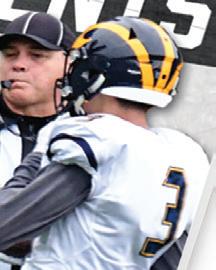










season at one amazing

THE 2022 COMPLETE FOOTBALL PACKAGE AVAILABLE NOW ORDER TODAY AT STORE. /football GET MORE, SAVE MORE From
2022
price! ONLY $7995 $28 save
MIND RIGHTGET YOUR


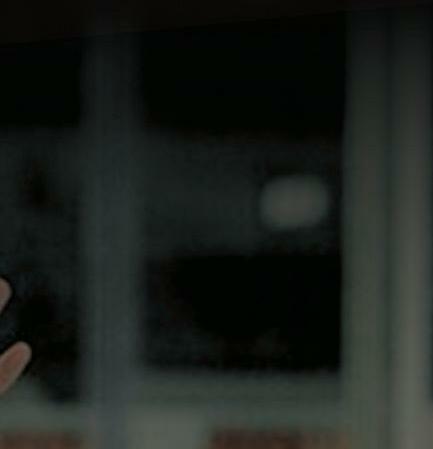


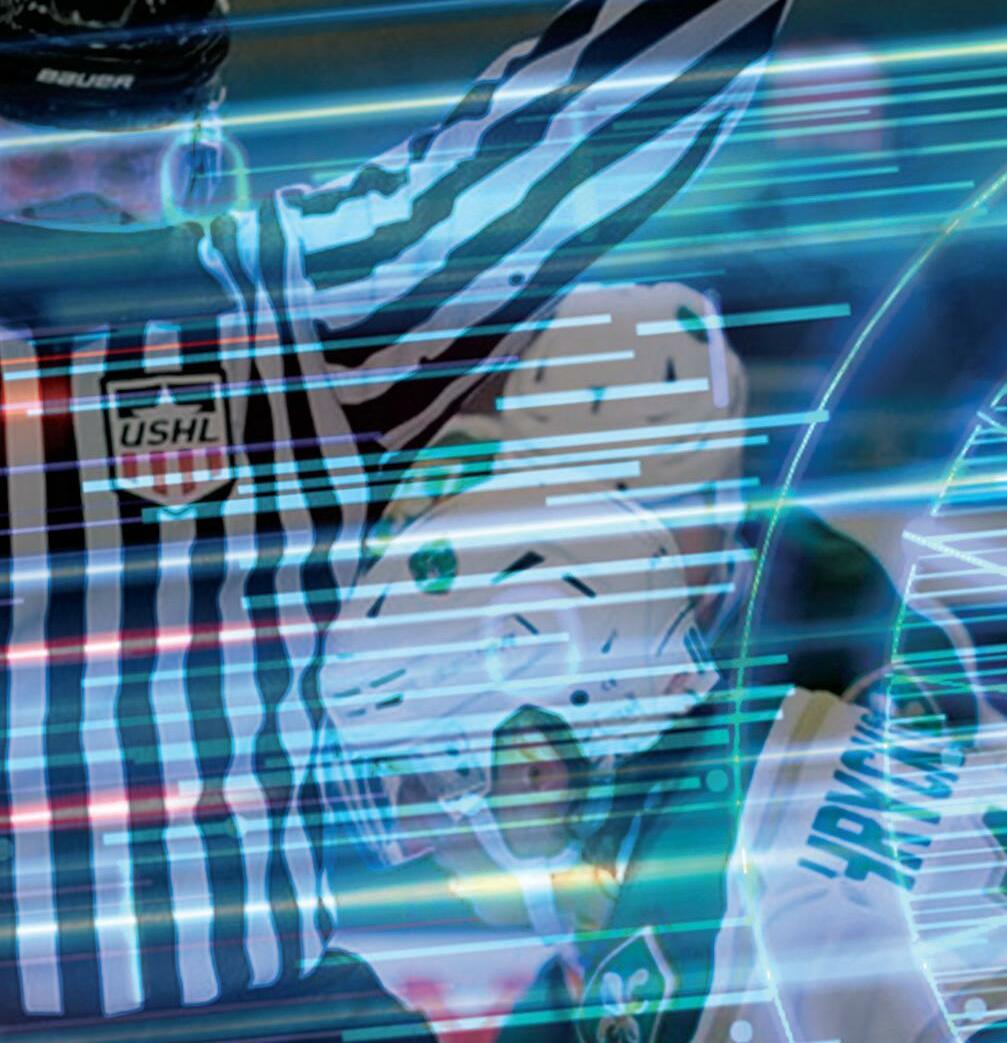


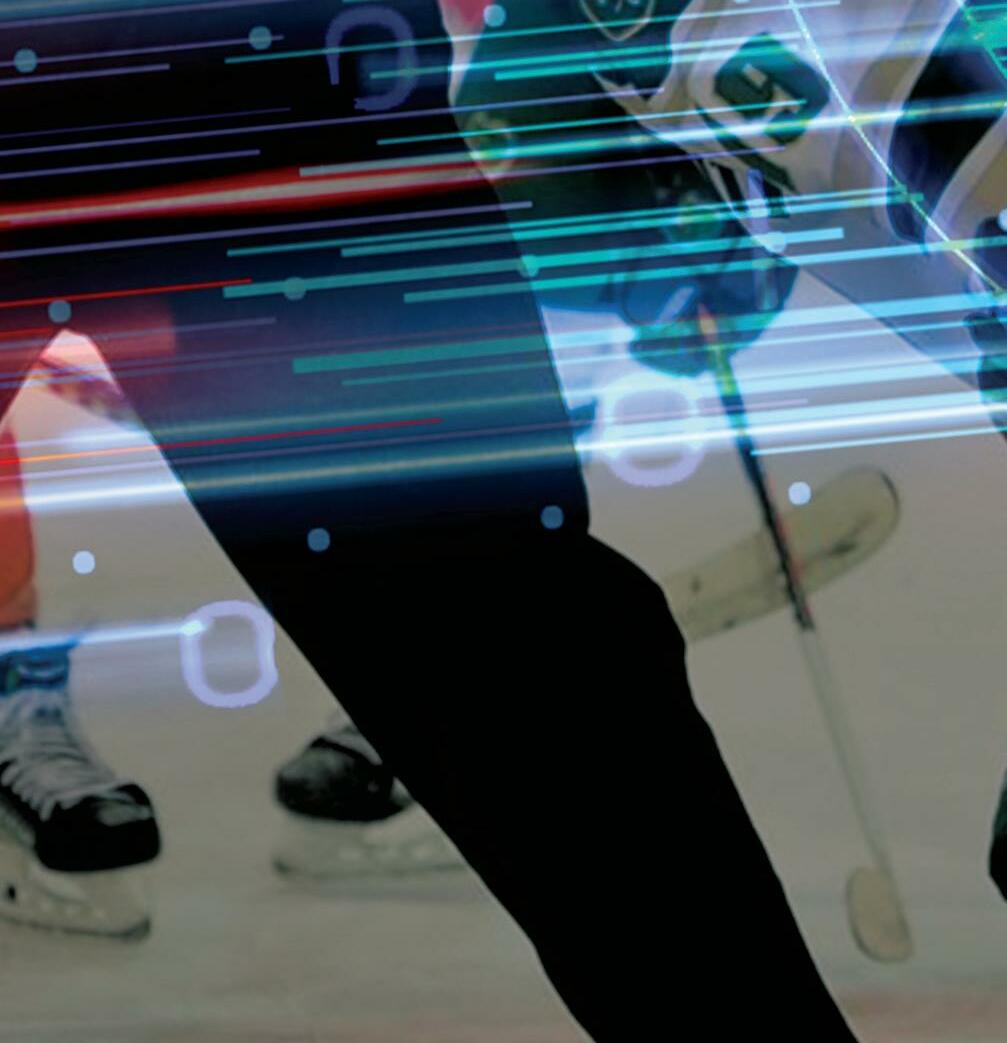

| REFEREE August 2022
Top-Tier Mental Performance is Achievable if You Put Your Mind to It
 By Luke Modrovsky
By Luke Modrovsky
Peak performance is ultimately what sports officials are seeking.
Much of what officials do in preparation for a game takes place long before it is even assigned, let alone on game day.
Mental performance is not something officials should take lightly — whether it’s generating a game day routine to get into the right mindset before the game starts, or simply making it a habit to take in the moment just prior to the start of a game.
At the virtual 2021 NASO Sports Officiating Summit, four presenters shared their expertise on mental performance — providing key insights for officials seeking to stay on top of the mental side of officiating.
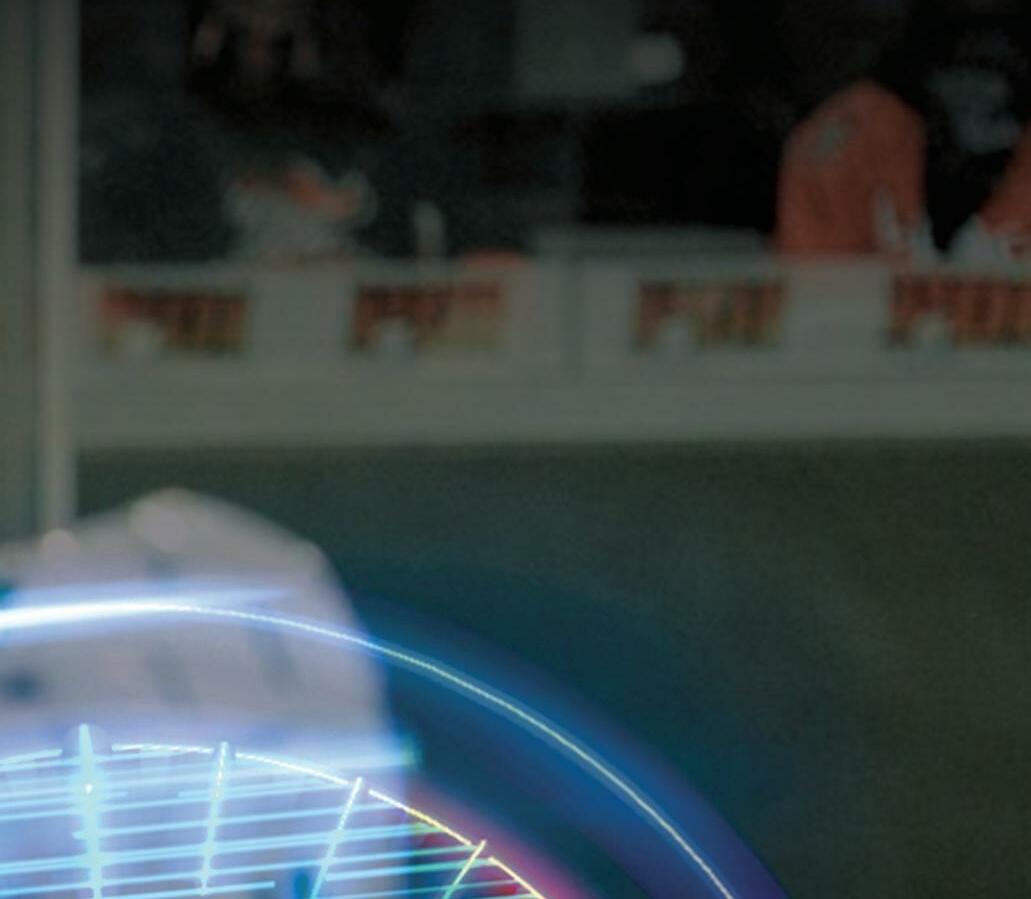
Mental Toughness/ Motivation
Lauren Johnson, a mental conditioning coach who has worked with professional sports teams including the New York Yankees, military personnel and business professionals, first worked through a definition of mental toughness.

“Let’s start with what it isn’t,” Johnson said. “It isn’t



pushing through and grinding it out while ignoring how you think and feel. No, mental toughness is processing how we think and feel in a way that maintains a high level of performance.”
Johnson cautioned that thinking simplistic in terms of black and white should be avoided. In actuality, some positive thoughts are not productive and not all negative thoughts should be discarded.
Instead of “driving down a highway and ignoring a road closure sign,” Johnson said this negative information is needed to avoid disaster. In this instance, it is about embracing the reality and need to be productive to “find the good in the bad,” Johnson said. This integrity avoids having to lie to yourself about the current situation.
Johnson’s presentation involved her sharing a video of a little girl taking on her “biggest ski jump yet” as she rattles off the various emotions the girl feels: nervous, scared, uncertain and fearful.
While having the courage to be a “crew saver” in a tense
– Lauren Johnson
REFEREE August 2022 | 53
RIGHT
It isn’t pushing through and grinding it out while ignoring how you think and feel.
MIND RIGHT
as NBC’s “Today,” ESPN’s “SportsCenter” and “Outside the Lines,” and HBO’s “Real Sports” with Bryant Gumbel, said everyone’s motivation will be different.
One might even consider the top 10 reasons on NASO’s Say Yes to Officiating website such as camaraderie, boos, adrenaline, money, love of sports and goosebumps. After all, what avocation can provide all of this?

Asking these questions will better position officials to formulate their own strategies regarding their own mental performance — translating that to officiating.
“Let me take my core personality traits and learn how to expand them because in this officiating field, there are times we need to be flexible,” Fish said.
Tying everything together, Fish said it’s important to remain a work in progress. Officials will recall a similar theme in their knowledge of rules, mechanics and philosophies. Simply one additional part of that is mental performance and how officials can better their own mental game.

situation on the court or field can be gut-wrenching, Johnson said it is natural for our mind “to second guess or try and talk us out of it.” Regardless, the “I can do this” mantra can provide the official the courage to save the crew from misenforcing a penalty or carrying out some other action incorrectly.
“Sometimes, you’ll find (mental toughness) by listening to your thoughts,” Johnson said. “Other times, you’ll find it by creating your thoughts. Wisdom is knowing the difference.”
But what drives officials and their motivations? What gives officials the courage to render decisions during sporting events that can be extremely difficult to process in such a short period of
time?
Dr. Joel Fish, a nationally recognized expert in sports psychology and the director of the Center for Sports Psychology, asks officials to reflect on a few items when reviewing their own motivations.

He asked, “What are your own attitudes about winning, losing, success, failure, competition, officiating?” I cannot come in here and paint everybody with the same brush. Everybody’s different.”
Fish, who has worked with athletes, organizations and sports officials at all levels for more than 20 years, has delivered speeches to more than 300 universities and has made numerous appearances on shows such
The late Kobe Bryant was playing his last game in Philadelphia, and Fish was in attendance. Fish spent a brief moment with Bryant and asked him what he had learned about mental toughness.
“‘What I’ve learned, and I’m still a work in progress — over 20 years now — I define mental toughness as being in control of my emotions rather than my emotions being in control of me,’” Fish said he recalled Bryant telling him. “‘Joel, nobody can get in my gut and force my blood pressure to go up, nobody. Nobody can get in my head and force me to think negative, nobody. I am in control of that.”’
54 | REFEREE August 2022 GET YOUR
CARIN GOODALL-GOSNELL
Having mental toughness means staying in control of your emotions instead of your emotions being in control of you. Erica Jungman, Stella, N.C.
I cannot come in here and paint everybody with the same brush. Everybody’s different.
– Dr. Joel Fish
What’s In Our Control?
Brian Miles, a mental performance coach for the Cleveland Indians, helps players be deliberate with the intent, habits and decision-making and belief to be the best version of themselves. Like Johnson, Miles also has experience working for the military, when he spent a combined four years in El Paso, Texas, and Fort Drum in upstate New York for the U.S. Army.
A former college soccer player, who admits he had his “fair share of run-ins both positive and maybe a little bit counterproductive with refs,” said he understands the job officials have.
Miles said it is essential to focus on what an official can control.
“What we can control is the process and the journey that we have toward that actual outcome,” he said. “You can’t change the past. You can’t predict the future. What you can do, is you can truly influence the here and the now.”
Imagine a crew working a game and down the stretch, the crew kicks a rule. While one might feel the covering official is ultimately responsible for the mistake, the blunder falls back on the entire crew. But many simply point out an incorrect ruling — likely discussing what the correct ruling should have been — without diving into the process failure, such as a crew member inadvertently withholding key information.
One question to ask: Was a crew member with information dismissed or not heard? Sorting through a pile of information is not easy, Miles said.
“In the present moment, it is about listening,” he said. “Are you listening with the intent to listen, or are you listening with the intent to reply?”
It’s understandably difficult to work in the pressure-cooker environment that officials are tasked with. But how can officials ease their mind, work
calmly under pressure and rely on good processes to get a correct end result? How can a crew effectively communicate to one another all of the information needed while doing so efficiently?

“Our mind is very stimulated and, therefore, when there are lots of things going on around us, it’s very easy for us to be pulled in different directions,” Miles said, adding that officials “need to take in the information to identify what is truly most important in that specific moment.”
In the information age, it’s essential to work on the task at hand before cleaning up minor details.


“I also want to emphasize that it’s really hard not to respond,” Miles said. “It’s really hard to have that self-control to hold back and not say what you want to say.”
For example, working through multiple flags on a football field requires the need to figure out what penalties — if any — will be assessed before moving onto items like lateral location (hashmark) of the ball and clock status. Working out of order will only hinder the crew’s ability to be efficient, but more importantly, communicate effectively.
Additionally, a calming presence demonstrated in any sport by the leader of the crew — who is typically the one responsible for rendering a final decision on a difficult play — goes a long way in managing the emotional responses likely to come from crewmates.
Finding a baseline could be a tactic worth exploring.
“There are times we need to be really clear,” Fish said. “There
are times we need to be calmer, slow down. … So what’s your starting point? Because no matter what our starting point is, we will be challenged with all the changes that are coming down the pipe.”
All of this — our emotions, choosing when to speak/not speak and handling our own duties in crew processes — remains in our control.
Additionally, egos in officiating — something else that remains in our control as an official — remain a cancer to the industry.
“Our ego wants the attention, it wants the spotlight, and it often comes with the things out of our mouth,” Miles said. “When we quiet the ego, we quiet the mind. And when we quiet the mind, we make really, really good decisions.”
Strong, sound decisions, of course, come when egos and emotions are in check.
“Mental skills training is really about an official learning how to manage one’s emotions, controlling one’s emotions, rather than one’s emotions controlling them,” Fish said.
Bouncing Back

Whether it’s disappointment, failure or other negative circumstances, mental performance coach Justin Su’a said the best in the world learn from failure.
As someone who has worked with the Tampa Bay Rays, Cleveland Browns, Boston Red Sox and IMG Academy, Su’a said he has seen athletes go through deep slumps and lose confidence because of poor performance.
Perhaps stating the obvious, Su’a said, “You don’t have
REFEREE August 2022 | 55
When we quiet the ego, we quiet the mind. And when we quiet the mind, we make really, really good decisions.
– Brian Miles
GET YOUR MIND RIGHT
to be a professional athlete to experience failure and learn from it.” An important reminder, however, is to remember that everyone experiences failure at some point in life.
Responding to that failure is what Su’a said separates people.
“Now, the best in the world are able to take their failures and use them as stepping stones instead of stumbling blocks,” he said.
However, merely being an optimist is not the ideal strategy, Su’a said.
He gave the example of James Stockdale, who was a fighter pilot and an admiral in the Vietnam War. After Stockdale was captured as a prisoner of war, he was tortured over and over again for years. When interviewed after he was rescued, he was asked who didn’t escape. Stockdale said the optimists — expecting to escape by various milestones such as Thanksgiving, Christmas, New Year’s, etc. — were the ones to die of a broken heart. When those milestones passed, the optimists became even more depleted.
Learning from onfield experiences helps good officials become great officials.
David Bautista, Laguna Beach, Calif., and Marce Almarez, Ladera Ranch, Calif.
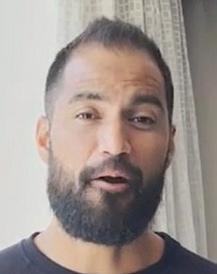
While Su’a indicated it’s important to carry a positive attitude, overlooking the hardcore facts of a situation is a big mistake.

Of the survivors, the ones who were able to stare the brutal facts in the face while thinking of a brighter future put themselves in the best state of mind to survive.
“What everyone wants to do is they look the other way,” Su’a said. “They want to point the finger and blame other people as to why they failed.”
Officials experience disappointment in officiating — whether it’s not getting called up to the next level, not being assigned one’s preferred postseason assignments or even recovering from a bad game.
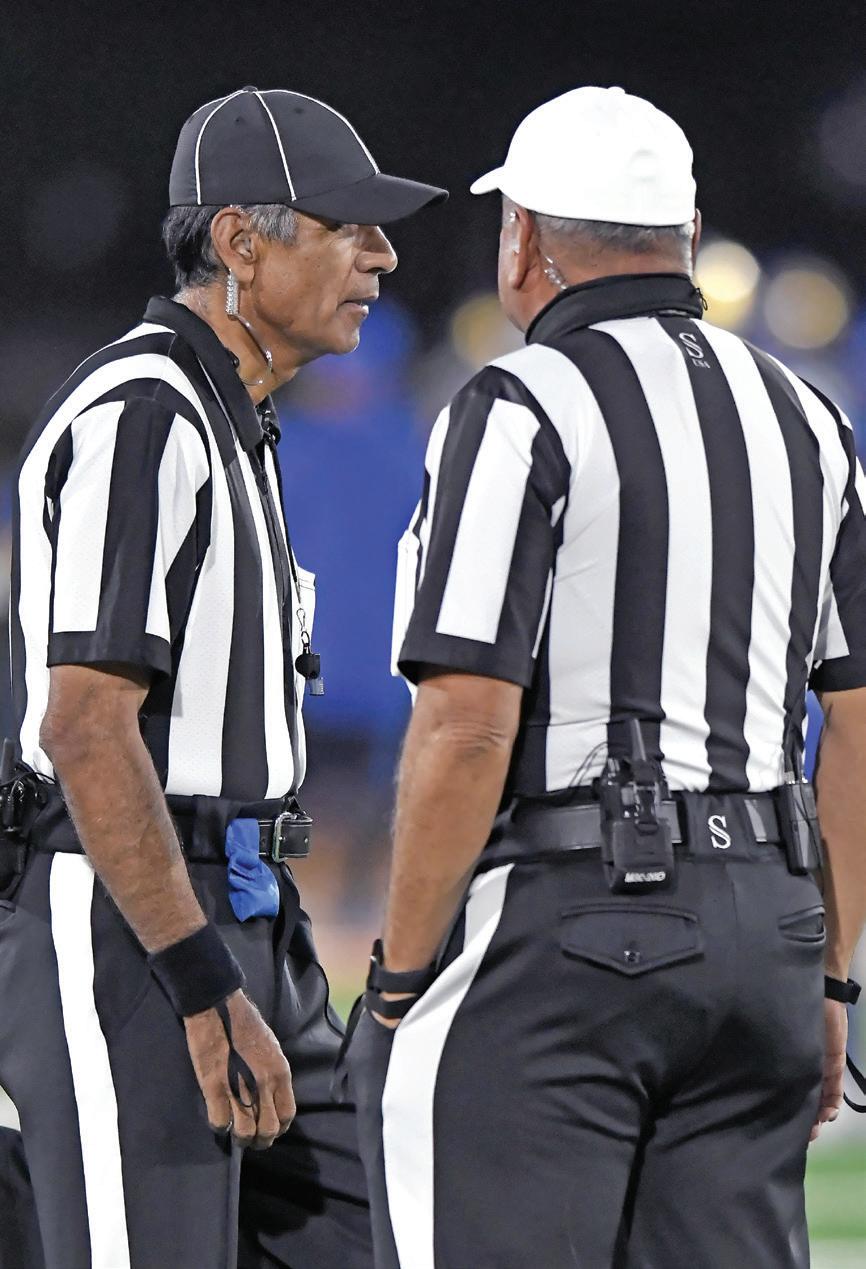
“I had an official say to me recently that ‘I can make 99 calls right,’” Fish said. “’If I make one call that’s questionable, I lay awake at night thinking about how the heck did I do that?’”
“Some of the best lessons that we can learn from come from failure and not success, from failure,” Su’a said. “However, a lot of people fail to learn from those lessons because it’s too painful. It’s too painful to look at that bad game. It’s too painful to stare and extract lessons from that poor performance.”
While some might counter sports officials are their own harshest critics, Su’a delivered a reminder that seeking feedback from others is critical to development.
“Get feedback from people,” Su’a said. “People do not like to get feedback. Seek critical feedback out so you can be a better version of yourself the next time.”
– Justin Su’a
Some questions to ask, Su’a said, include: “What can you learn? What can you do better? What can you control? How can you prevent this from happening again?”
As crewmates might be standing on an island hashing out the result of a play, an official not immediately involved in the discussion might be able to catch a rules discrepancy before play resumes. Even though the official was not a part of the discussion (out of the official’s control), an official can possibly save the crew from kicking a rule (in the official’s control).
So, if a messy situation happens, Su’a recommends a few things when looking back at the problem.
“Go back on a past failure and write down what were the brutal facts,” Su’a suggested. “What were the things you did not do well? But on the other side of the ledger, I want you to write down all the things you did do well. What were the bright sides? What was the good stuff?”
Using this process will enhance the growth process of an official’s career, as a 25-year veteran making the same mistakes over and over again is arguably a rookie who has officiated 25 years.
“You’re going to learn from those failures and you’re going to grow more than you have ever done in the past,” Su’a said.
Luke Modrovsky, Indianapolis, officiates five sports at the high school level. He also works smallcollege football and volleyball.
HESTON QUAN 56 | REFEREE August 2022
Now, the best in the world are able to take their failures and use them as stepping stones instead of stumbling blocks.



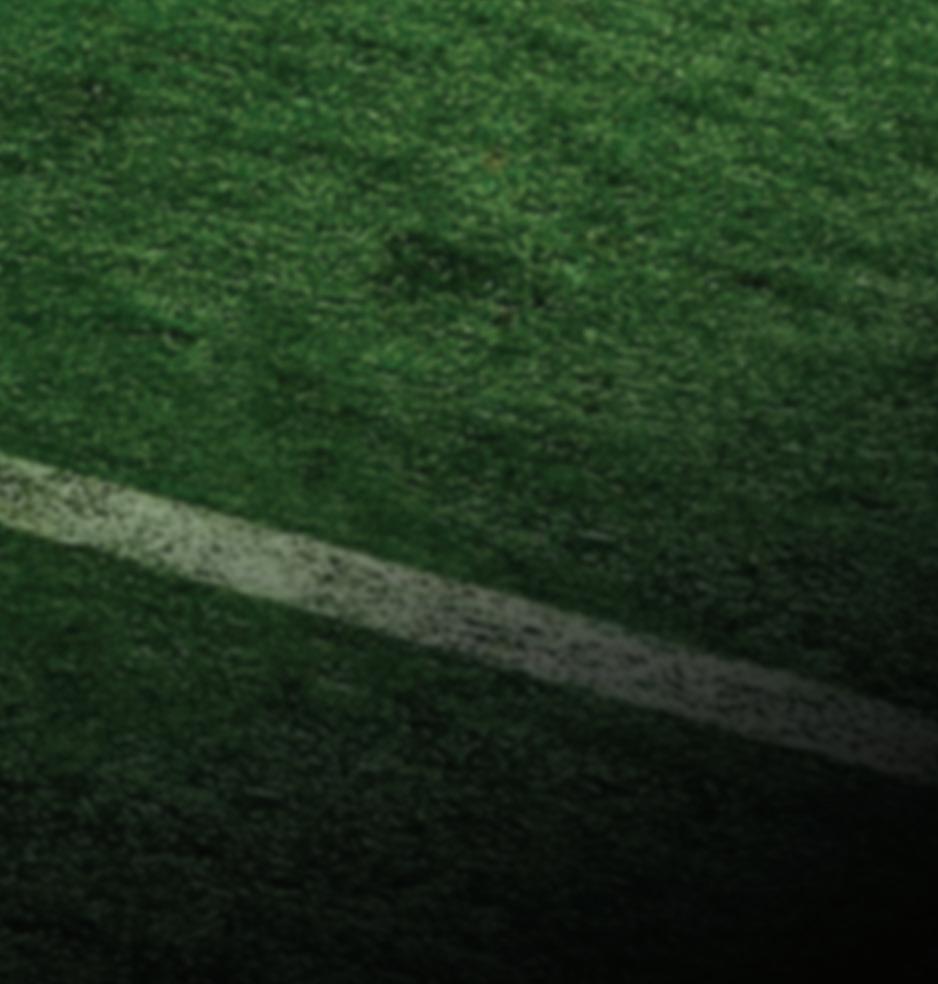





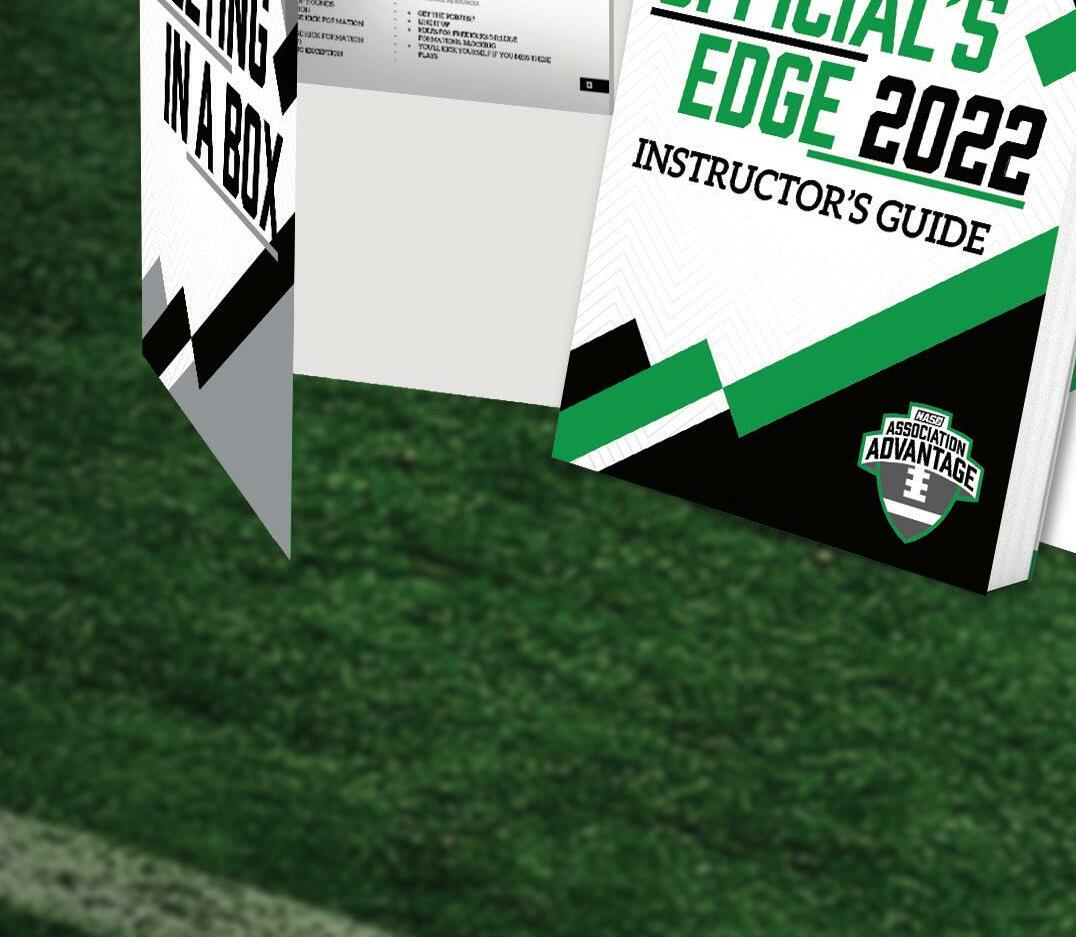

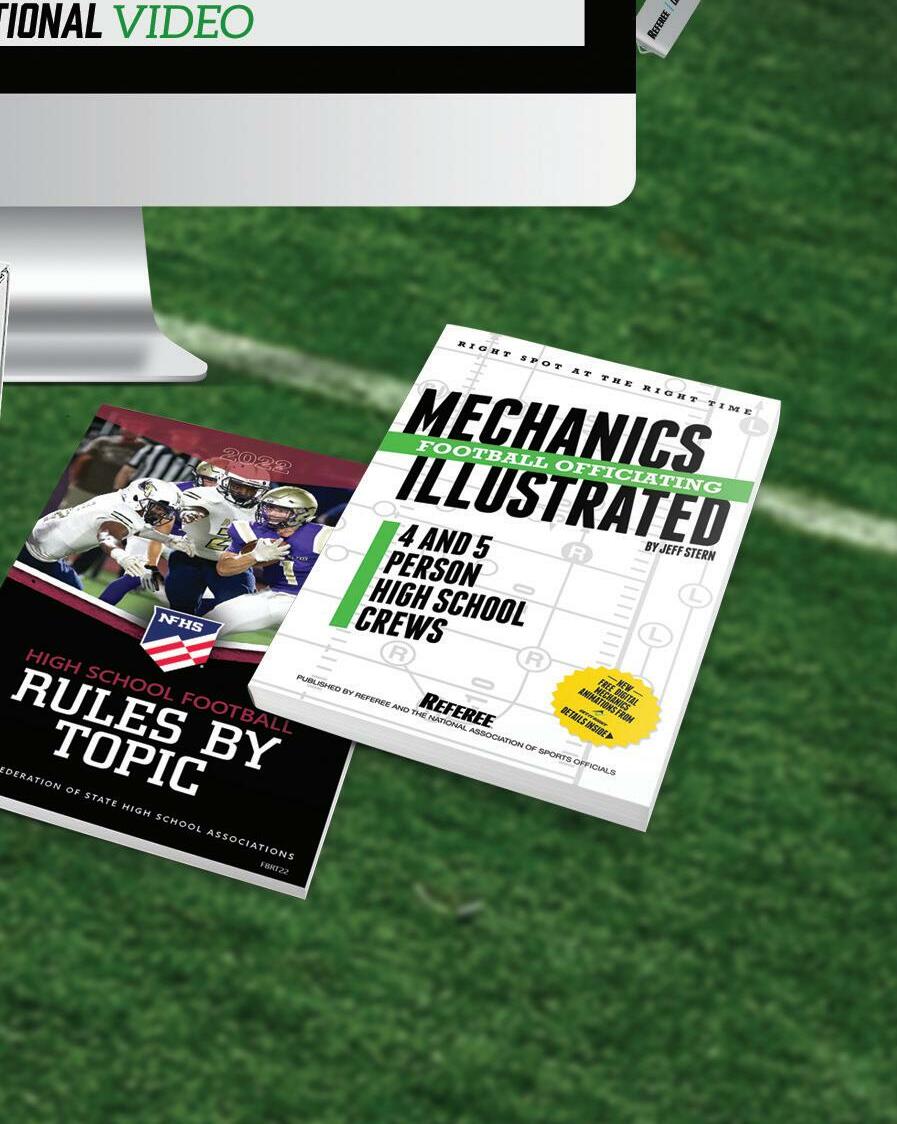


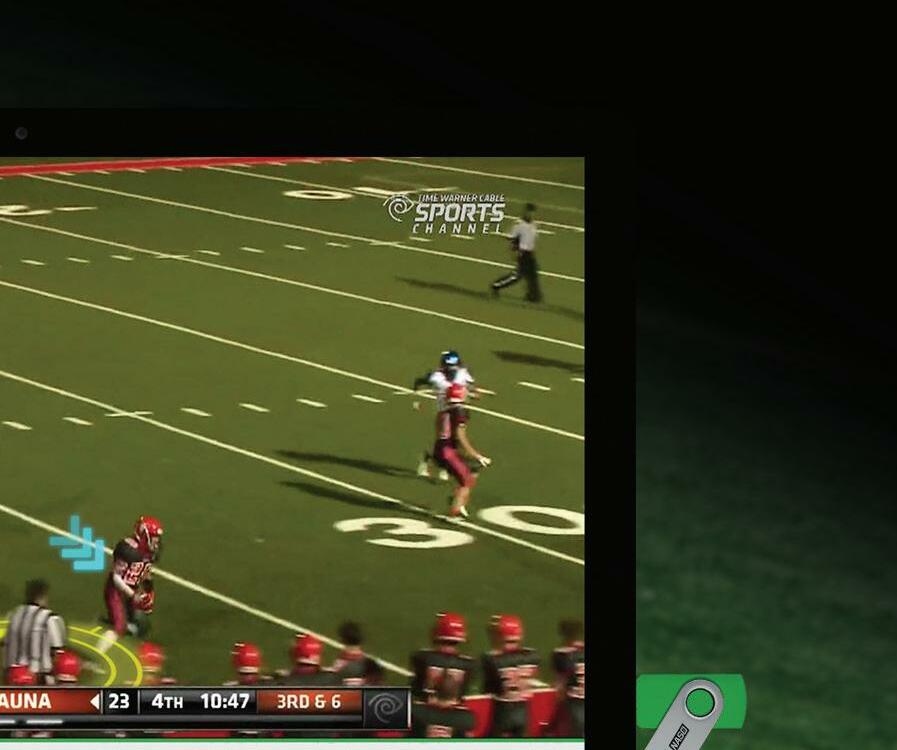
GREAT TRAINING RIGHT OUT OF THE BOX Everything you need to run a full season’s worth of football association meetings and step-by-step instructions on how to do it. Just open the box. Your Turn-key ASSOCIATION Training Solution • Handouts For All Your Members • Training Resources • Enhanced Video Plays & Digital Resources On USB Drive • Step-By-Step Instructor Guides STORE. /footBALL SPECIAL ASSOCIATION PRICE $750 • 6 Pre-Built Meeting Lesson Plans
APPROVED TO ADORN
NFHS Alters Guidelines for Hair Beads, Barrettes
By Scott Tittrington
High school basketball players will be allowed some extra creativity and flexibility when it comes to hair styles starting with the 2022-23 season due to a rule change approved by the NFHS Basketball Rules Committee

during its annual April meeting.
The committee met in person for the first time since the spring of 2019, and while doing so approved one rule change and a series of minor editorial changes to the NFHS rulebook, while also crafting three points of emphasis for the season.
Referee thanks Lindsey Atkinson, NFHS director of sports and staff liaison to the rules committee, for reviewing this information.
Team Members’ Equipment, Apparel (3-5-4d)
A change to the rule regarding
BASKETBALL RULES, MECHANICS, PHILOSOPHY 58 | REFEREE August 2022 EDITOR: SCOTT TITTRINGTON stittrington@referee.com
Players will have more options for hair adornments for the 2022-23 season due to a rule change approved by the NFHS Basketball Rules Committee. In addition to headbands and hair ties, players can now wear hard items such as beads, barrettes and bobby pins, so long as they are securely fastened to the head. Chris Riddle, Winterville, N.C.
CARIN GOODALL-GOSNELL
In PlayPic A, the player cannot participate with the hair adornments worn in the current position since the adornments are not securely fastened to the head. PlayPic B shows how those adornments could be made legal by securely fastening them to the head. The hair adornments in PlayPic C similarly could be made legal by securely fastening them to the head as shown in PlayPic D.


hair adornments now allows for players to wear items provided they are securely fastened close to the head and do not present an increased risk to game participants.

Rule 3-5-4 begins with the following: “Wristbands and headwear shall meet the following guidelines,” and the fourth clause, 3-5-4d, now reads as follows:

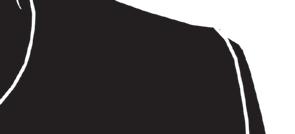
“Rubber, cloth or elastic bands may be used to control hair. Hard items, including, but not limited to, beads, barrettes, bobby pins and other adornments in the hair that are securely fastened to the head and do not present an increased risk to the player, teammates or opponents are allowed. Hair-control devices are not required to meet color restrictions.”
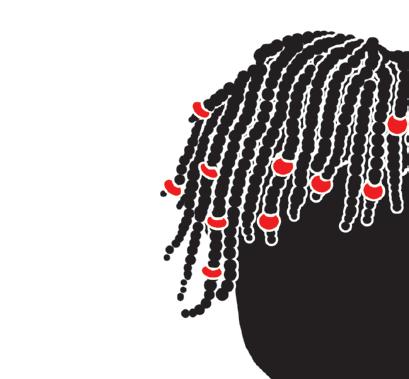

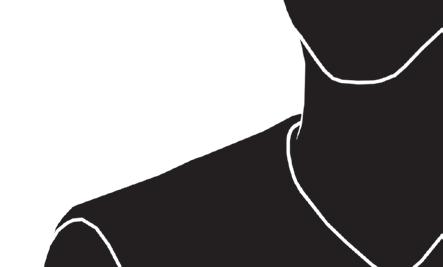

Play 1: During team warmups, the officials notice a team A player is wearing beads in the hair. The hair is (a) wrapped with elastic hair ties, keeping the beads tight to the head,
or (b) free flowing allowing the hair to sway back and forth and the beads are on the end of the hair. Ruling 1: In (a), the beads would be legal as they are securely fastened to the head and there is no danger to other players. In (b), the beads would be illegal as the beads are not tightly secured and could cause injury to other players as the hair moves around.




Play 2: During team warmups, the officials notice A1, A2 and A3 wearing beads in the hair. For all three players the hair is wrapped with elastic hair ties, keeping the hair tight to the head. A1 is wearing red beads, A2 is wearing white beads and A3 is wearing blue beads. Team A is wearing uniforms that are red and white. Ruling 2: The beads are legal for all three players, as they are securely fastened to the head and there are no color restrictions on haircontrol devices.
THEY SAID IT
— Golden State head coach Steve Kerr, about his team’s Western Conference Finals opponent, which the NBA fined three times for bench-decorum violations during the 2022 postseason

number of NBA Finals appearances for each member of the 2022-23 Finals officiating crew, who worked the series between the Boston Celtics and Golden State Warriors:

Scott Foster
Tony Brothers, James Capers, Marc Davis
Zarba
John Goble
David Guthrie
Kane Fitzgerald, Eric Lewis
Tiven
Courtney Kirkland, James Williams
REFEREE August 2022 | 59
“I love the fact that Dallas’ bench is energetic and talking trash and into it. I think that’s what fans want to see. They want to see a team that cares … but when it interferes with the game, that’s when it crosses the line.”
SOURCE: AUDACY.COM
A Illegal B Legal C Illegal D Legal
The
15 —
11 —
9 — Zach
6 —
5 —
4 —
3 — Josh
2 —
SOURCE: NBA.COM BY THE NUMBERS
TEST YOURSELF
In each of the following, decide which answer or answers are correct for NFHS, NCAA men’s and NCAA women’s rules, which might vary Solutions: p. 81.
1. Which of the following results in a three-second violation?
a. A5 is in the key for more than three seconds during team A’s throw-in.

b. A5 is in the key for more than three seconds during A1’s interrupted dribble.
c. A5 is in the key for more than three seconds after B2 knocks the ball away from dribbler A1.
d. A5 is in the key for more than three seconds when team B has control of the ball in team B’s backcourt.
e. Both b and c.
2. Which results in a violation during A1’s throw-in?
a. A2 jumps from team A’s frontcourt, catches the ball and passes the ball to A3, who is in team A’s backcourt.
b. A2 jumps from team A’s frontcourt, catches the ball and lands in team A’s backcourt.
c. B2 is in team A’s frontcourt, fumbles the ball into team A’s backcourt and A3 recovers the ball.
d. A2 is in team A’s frontcourt, fumbles the ball into team A’s backcourt and A3 recovers the ball.
3. After team A had earlier been given a delay-of-game warning for interfering with the ball after a made goal, following A1’s successful try, A2 knocks the ball away. What is the result?
a. Administrative technical foul.
b. Team technical foul.

c. Technical foul charged to A2.
d. Technical foul charged to the head coach.
4. Which of the following result in a throw-in violation to thrower-in A1?
a. A1’s throw-in pass touches A2, who is inbounds, then A1 steps inbounds and grabs the ball.
b. A1’s throw-in pass touches B2, who is inbounds, then A1 steps inbounds and grabs the ball.
c. A1’s throw-in pass touches B2, who is standing with one foot out of bounds.
d. A1’s throw-in pass touches an official who is inbounds, then A1 steps inbounds and grabs the ball.
Points of Emphasis
Unsporting behavior in educationbased athletics has increased across all sports and as a result, the NFHS has again made sportsmanship its primary point of emphasis (POE) for the 202223 season. Reducing illegal contact (hand checks, post play, off-ball play) and use of the pregame meeting to address illegal uniforms, equipment and apparel round out the three POEs.
• Sportsmanship. Good sporting behavior is one of the fundamental ingredients to the continued success and enjoyment of education-based high school sports and activities. NFHS playing rules are written to encourage sportsmanship, and participation in these programs should promote respect, integrity and sportsmanship.
There must be a collaborative, working relationship between game officials and game administration to promote good sportsmanship and safely conduct the game. Everyone has their roles to play in creating a positive, sportsmanlike atmosphere at games.
Officials should focus on the actions of players, coaches and other bench personnel. A positive, open line of communication between officials and coaches ultimately results in a better game for everyone involved. Officials should not, however, engage with spectators who are exhibiting

unsporting behavior (PlayPic E). Once the game begins, school administration is responsible for dealing with unruly spectators. A proactive approach by school administration includes monitoring the behavior of spectators and intervening as needed. If spectators are using demeaning or profane language at officials, or others in the stands, those individuals should be removed from the contest by school administration.
The use of demeaning language, or hate speech, by students, parents and other fans must cease. High schools must establish a culture that values the worth of every single person — both players on the school’s team and players on the opposing team. There must be a no-tolerance policy regarding behavior that shows disrespect for another individual.

• Reducing illegal contact. The NFHS Basketball Rules Committee expects officials to adhere to the playing rules for high school contests as written. Of particular concern for the committee is the growing number of individual interpretations by game officials of certain plays that are increasing the amount of illegal contact being allowed.


Officials need to remember the simple concepts of rule 10-7-12 that prohibit defensive players from placing two hands, an extended arm bar, keeping a hand on an opponent

BASKETBALL 60 | REFEREE August 2022
E
or contacting an opponent more than once with the same hand or alternating hands. It’s critical for officials to keep these principles related to “hand checks” in mind and rule on them when they occur.

While freedom of movement has generally improved, there is still a need for officials to pay attention to play in the post (PlayPic F). A review of national injury data shows more injuries occur in the post than any other place on the floor, and officials need to monitor play in the post, whether the ball is involved or not. Players who either illegally carve out space for themselves or defenders who repeatedly push, knee or otherwise attempt to knock offensive players off balance need to be penalized for their actions.

Finally, keeping eyes on off-ball plays is also necessary to help reduce physicality in the game. Officials need to keep their focus on their primary coverage area and trust their partners will handle plays in their areas. Of particular concern are screening plays that involve illegal contact.
• Pregame meeting, addressing illegal uniforms, equipment and apparel. NFHS rule 2-4-5 requires game officials verify with each head coach, prior to the start of a game, the teams’ uniforms and equipment are legal and will be worn properly. Before and after this meeting, game officials should monitor players and notify the head coach if they notice anything that needs to be addressed (PlayPic G), including uniform colors, undershirts, jewelry and items worn in the hair.
Officials should allow head coaches to address any items of concern with the player(s) and never directly address the player(s) themselves.
Game officials should also know who the game administrators are in case they are needed. This will
allow officials to confidently execute their duties should any behavior or sportsmanship issues arise.

Scott Tittrington is an associate editor at Referee. He officiates college and high school basketball, college and high school baseball, and high school football.
Hone Your Way to a Smoother Game

 By Tim Sloan
By Tim Sloan
In past articles, I’ve regularly stressed the need to keep ahead of the game when officiating. Don’t just show up and make the calls, relying on the table and game administration to do their part to avoid pickles. Work out a way of monitoring what these people are doing so that you’re ready if they slip up when it would hurt the most: Trust but verify, as Ronald Reagan used to say.
In that connection, through some combination of trial and error, hard knocks and shameless mimicking of other officials, our crew has come up with some helpful solutions to avoid unfortunate occurrences. You won’t find these suggestions in any mechanics manual, but they might make life simpler for you, if practiced. I might use the first person a lot here, but it’s something my two crewmates practice, as well.
Check the book in the presence of the visiting scorer. Most of the time, the visiting scorer is a nice person — perhaps the bus driver, too — who is asked to do something useful to relay pertinent info to the coach. Very occasionally, he or she is a Lothario, suspicious of everyone and forgiving of no one. Whatever the case, it’s good practice to make sure the two scorers are elbow-toelbow if possible. What I do during the pregame is take the official book and read the rosters and starters to the visiting scorer for that person to confirm both books tell the same story. I then put a little mark below the last filled name space, initial it and tell both scorers that anyone else showing up below my initials will cost a technical foul. In addition to being a triple-check against administrative T’s, it also gets the two scorers working with each other and reassures the visiting scorer
REFEREE August 2022 | 61
F G
CASEPLAYS
Double Foul During Try
Play: While A1’s try is in flight, A2 and B2 are in the lane area trying to get rebounding position and are making illegal contact against each other. The nearest official blows the whistle and calls both fouls. What is the result? Ruling: When two opponents commit personal fouls against each other at approximately the same time, the result is a double foul, no free throws are shot and the game is resumed at the point of interruption. If A1’s try is successful, team B shall be awarded the ball for a non-designated spot throw-in anywhere along the endline. If A1’s try is unsuccessful, since there is no team control, play shall resume with a throw-in to the team that has the alternatingpossession arrow in its favor. In NCAAM/W, if team A is entitled to the ball, the shot clock shall be reset to 20 seconds when the try strikes the ring or flange or is not reset when it fails to strike the ring or flange. If team B is entitled to the ball, the shot clock shall be reset to 30 seconds (NFHS 4-19-8a, 4-36-3, 10-7 Pen. 1.c, 4.19.8C; NCAAM 2-11.6.b.4, 2-11.6.d.4, 4-9.4.c, 7-3.1.i, 7-3.2.a, 7-4.10, 10-1 Pen. f, AR 270; NCAAW 2-11.6.b.4, 2-11.6.d.4, 4-8.4.c, 7-4.10, 10-11.1, AR 324).
Backcourt Violation
Play: A1 secures a defensive rebound in team A’s backcourt. A1 throws a long outlet pass to A2, who is just past the division line in team A’s frontcourt. B1, who is defending A1, jumps from team A’s backcourt (team B’s frontcourt), catches the ball while airborne and lands while holding the ball in team A’s frontcourt (team B’s backcourt). Has B2 committed a backcourt violation? Ruling: No. There is an exception to the backcourt violation rule in which a defensive player shall be permitted to secure control of the ball while both feet are off the playing court and land in the team’s backcourt (NFHS 9-9-3; NCAAM 9-12.9, AR 245; NCAAW 9-12.9, AR 285).
During the pregame, it’s always a good idea to check the scorebook of both the official scorer and the visiting team to make sure everything matches up regarding names, numbers and starters. Brandon Bubar, Coeur d’Alene, Idaho.

he or she matters: Good proactive officiating.
Watch the auxiliary scoreboard during introductions. OK, so far, I know the two scorebooks are accurate. While introductions are taking place, I’ll quickly compare the 10 starters in the book to the 10 starters on the auxiliary board. If there are any discrepancies, I’ll ask the coach why 52 was introduced but 42 is on the board. That gives him or her a chance to fix the problem. You don’t have a technical foul, yet; that only occurs when the “wrong” player comes out on the floor and attempts to play. Coach has a choice to put the correct player out there, correct the number in the book or let the incorrect player play. The latter two choices cost an administrative technical and the game begins with free throws. Paranoia, you say. My crew’s caught it twice in the past two seasons.
Carry a spare whistle and use it to track the possession arrow. I carry a spare lanyard with me, too, because it’s the thing that more likely will fail me. Anyway, we all keep the spare whistle in a front pants pocket so that when we face the table it’s in our right pocket when the alternatingpossession arrow points to the right or left when left. The direction of the arrow is the most likely thing to be wrong — even among the most dedicated of scorers — for a host of
reasons. When an AP call occurs, I check the arrow, confirm my pocket agrees and then move my whistle to the other pocket ahead of the throw-in because I might be busy later. (In the one-in-500 case where the arrow remains the same, I’ll have lots of time to put it back.) If I check the arrow and the whistle’s in the wrong pocket, my quizzical expression usually matches the two of my partners who are walking up, tapping their upper thighs, too. The fun starts when the scorer — for reasons known only to him or her — switches the arrow after it’s been properly set and checked. Actively using the spare whistle in this way keeps everyone on top of it.
Thumbs up. At the start of a quarter or after any timeout, the crewmate managing the throw-in looks to the other two officials for a positive-but-discrete thumbs up, signifying the proper number of players are on the floor, the clock looks correct, the cheerleaders are off the court and all is right with the world. As a bonus, the team-side umpire doesn’t raise a hand to chop the clock for the opening jump ball until confirming the table is ready to rock.
Confirm what your partner reports against what changes on the scoreboard. While one official is reporting, another is collecting the ball. The third should be auditing the
BASKETBALL 62 | REFEREE August 2022
scoreboard to make sure the team fouls, player foul, timeout count, score and/or possession arrow is changing properly.














Never turn your back on the players. While you’re confirming the scoreboard as in the previous point, be positioned where you have the players in your gaze. If you’re the crewmate retrieving the ball, forget about it if you have any inkling of unrest. Get among or between the players, interact, communicate, soothe — whatever you need to suggest they picked the wrong night to give up sportsmanship.
Onesy-twosy. We all check the scoreboard after fouls. When a team foul count becomes six or nine, one of us wiggles one or two fingers at waist level, pointing at the team who will be getting the bonus free throw(s) on the next foul. That reminds all of us it’s even more important to have a potential fouler and shooter after every foul.

Verbally state the shooter’s
number to your partners prior to any free-throw attempt(s). It precludes any shenanigans and helps everyone remember who it will be in the event of a timeout before one or both throws are taken. Personally, I’ve only ever assessed a technical foul to one player in 20 years for attempting to shoot someone else’s free throws … it can happen, “by accident.”








Draw your partners’ attention to time remaining. Everyone gives a last-minute signal to crewmates. What I find even more helpful is to gesture toward the clock for any throw-in or free throw inside of about 10 seconds in the period. It’s amazing how you can get swept away in the game only to be surprised by the sound of the horn in the middle of a play. On our crew, that warning alerts one official to maneuver into a view of both the thrower and the clock to assure the latter starts properly. If it doesn’t start properly, the official keeps a mental count of how many
seconds run off before the whistle is blown (which might be variable) and adjustments are made.
Thank people. It is more than just polite to thank the table, the AD, the cheerleaders (for staying out of your way) and anyone else for assisting you — even if it didn’t feel much like assistance some nights. Nothing helps “next time” go better than finishing up “this time” on a high note.

Some of these practices seem far more likely than others to be truly necessary, but that’s not the point. Any successful practitioner, in any profession or avocation, has a routine they follow, acting as an insurance policy. To my basketball crew, these tips keep us methodical and help ensure that we’re on the same page when there’s no room for error.


It’s a good place to be. Tim Sloan, Davenport, Iowa, is a high school football, basketball and volleyball official, and former college football and soccer official.

TO STAY FOCUSED
ORDER TODAY AT STORE. /BASKEtBALL FAST•EASY•DIGITAL THE SMART WAY FOR BASKETBALL OFFICIALS
IN THE OFFSEASON Featuring EIGHT fully immersive units, these interactive multimedia study guides deliver a massive amount of training right from your phone or tablet. You’ll get tons of video, snapshot graphics and quick-hitting tutorials in every unit to keep you fresh, focused and at the top of your game all year long! $1995 ONLY for all 8 units!
‘FEEL IT’ AT FIRST BASE
Let the Action Guide You to the Proper Mechanic on Force Plays
By Scott Tittrington
While there is still plenty of baseball to be worked during the summer of 2022, it’s also true that for many umpires, camp season is here. That means it’s time to open the eyes and ears, close the mouth and become a sponge to all of the information, insights and instructions you’re dropping your hard-earned money for by attending an umpiring camp or clinic.
While this extra education is invaluable for umpires who are dedicated to working on their craft and/or looking to advance to a higher level in their career, it doesn’t come without the occasional obstacle. One of the biggest is deciphering what
you should do when you are given conflicting information about the proper umpiring mechanics of a given play.
Case in point: When working the A position, where should you move to take plays at first base following a ground ball that’s hit somewhere in the infield?

Go to one camp, and you’ll receive detailed instruction about working hard to obtain a 90-degree angle with the location from where the throw originates. So, if a ball is hit to the third baseman, you are going to take at least two to three additional steps into the infield dirt toward second base than if the throw is coming from the second baseman who is deep into the hole moving toward shallow right field.
Fast forward a couple weeks, and you may find yourself at another camp where you’re taught the 90-degree rule is out of style, and instead all you need to do is to take one or two steps off the foul line for all plays at first base, because this gives you the best angle to see if there is any daylight between the first baseman’s foot and the bag when he catches the throw.
Sound familiar?
Every good camper knows which mechanic is correct: It’s the one being taught in that moment. You do as the instructor wants you to. Six months later, when you’re lined up for the first pitch of the new season and anticipating that first ball being put in play, your pre-pitch preparation, your DALE GARVEY
BASEBALL RULES, MECHANICS, TECHNIQUES EDITOR: SCOTT TITTRINGTON stittrington@referee.com 64 | REFEREE August 2022
Proper positioning for force plays at first base includes being in a location where Jonathan Jackson, Kelso, Wash., can see the completion of the catch, the first baseman’s foot in relation to the bag and the batter-runner hitting the base.
read of the action and muscle memory are going to dictate which mechanic you use.
And here’s the good news: Neither is wrong … until it is. Because as we all know, no two plays are created or executed exactly the same. The mechanic that might best fit one particular play may not be best suited for another. That’s where we need to use all of the tools in our bag to get in the best position to make a ruling.
For example, let’s say you’re a general practitioner of the second mechanic — you take one to two steps off the line each time and achieve a strong position for ruling on a possible pulled foot whenever possible. With that in mind, the leadoff hitter drops a bunt that rolls 10 feet into fair territory, the catcher pounces on it and here comes the throw on a bang-bang play at first base.
The good news is you may have a great look at whether the first baseman pulls his foot. The bad news? That first baseman is stretching toward home plate, not one of his fellow infielders, in anticipation of the throw. And given your positioning near the foul line, you are looking through his back, trying to determine when the baseball has entered his glove without a clear line of sight for doing so.
Now, imagine the look you would have at the play by taking two or three more steps toward the middle of the diamond. Not only do you still have a great view of whether the foot remains on the bag — I would argue it’s an even better view because it involves the very front corner of the base with any possible foot pull going toward the plate — but also a clear view of the thrown ball as it approaches the glove. With this small positional adjustment, you have created an optimal look at all the necessary pieces of information needed to make — and sell — this ruling.
Conversely, let’s say you ride or die with the 90-degree angle. A ball is hit deep in the 5/6 hole, the shortstop fields it and his throw is up the line to the right-field side of the bag. The first baseman stretches almost directly toward you and you have a great look
at when the ball enters his glove.
The problem? You have no idea if he kept his foot on the base, as you are in no position to see if there is any separation due to the first baseman’s movement coming at you instead of away from you at any type of angle. Rest assured, this is going to be a play where a coach is going to ask you to go to your home-plate partner for help, and you’re going to realize you need it, as you’re not sure if he held the bag or not.
Reading the ball off the bat and realizing this is going to be a close play where a pulled foot is a strong possibility, this is a good opportunity to stay near the line and make sure you have a great look at that particular element of it. Because the ball is coming from an infielder, you’ll still have an unobstructed look at the catch/no catch by the first baseman. Staying near the line gives you the best opportunity to have all the information you need to make this ruling.
As these two examples show, umpires need to be able to read plays and adjust, and understand when the dictums about “always” taking a play a certain way do not apply. Yes, there are absolutes we must follow when ruling on force plays at first base. We don’t want to be moving, so that our eyes have a set look at the action. We want to be far enough away from the play to see everything and not allow it to blow up on us. We want to do everything we can to remain in fair territory, as taking a force play at first base in foul territory in two- or threeperson mechanics has the potential of creating additional problems for you and the crew. We want our timing to be on point, so we aren’t in the middle of our big “whacker” mechanic with the ball lying in the dirt.
Where do we set up shop to make that ruling? That comes with feel, experience and understanding it’s not necessarily a final destination, but a road map to help you ultimately get where you want to be. Scott Tittrington is an associate editor at Referee. He umpires college and high school baseball, and officiates college and high school basketball and high school football.
THEY SAID IT
“It’s an imperfect game and has always felt perfect to me.”
— Joe Torre, special assistant to the commissioner of MLB, arguing against the use of roboumpires to call balls and strikes
BY THE NUMBERS
2:35
Need evidence why it’s important for umpires to enforce the pitch clock rule in their respective leagues? Above is the average nine-inning game time for all minor league games using a pitch clock through May 16. Last season, the average nine-inning game time was 3:03.
SIDELINE
New Balance Trims Shoe Lineup
While your 2022 season may still be in high gear, it’s not a bad idea to start thinking ahead about your footwear needs for 2023 and beyond.
Plate shoes proved to be a tough commodity this spring and summer due to supply chain issues caused by the ripple effect of the COVID-19 pandemic, and now comes word the number of models umpires will have to choose from is shrinking considerably.
New Balance announced this spring it is discontinuing four of its eight umpire shoe models. The company will no longer manufacture low-cut plate shoes or mid-cut base shoes. The styles that will continue are the mid-cut plate shoes and low-cut base shoes, each with the all-black and white “N” logo options.


REFEREE August 2022 | 65
SOURCE: MLB.COM
SOURCE: NEWYORKER.COM
TEST YOURSELF
In each question, decide which answer is correct for NFHS, NCAA or pro rules. Solutions: p. 81.
1. If any situation arises that could lead to an appeal by the defense on the last play of the game, the appeal must be made:
a. While all umpires are on the field.
b. While an umpire is on the field.
c. Before the infielders cross the foul lines.
d. Before the infielders cross the foul lines and the catcher has left the dirt circle around the plate.
e. Before the official scorekeeper declares the game over.
2. The runner is standing on second base when a line drive hits him. The second baseman was playing in front of him and did not contact the ball. The shortstop was behind second base in position to catch the line drive.
a. The ball remains in play since the second baseman had a play.
b. The ball remains in play since a base protects the runner.
c. The ball is dead and the runner is out since the shortstop had a play on the ball.
3. A runner acquires the right to the proper unoccupied base if he touches it before he is out. He is then entitled to this base until:
a. He is put out.
b. He legally touches the next base while it is unoccupied.
c. He is forced to advance to the next base by a following runner.
d. All of the above.
4. The runner and the batterrunner are both between first and second bases when the left fielder throws the ball to third base. The ball gets past the third baseman and rolls into the dugout.
a. Both runners are awarded third base. Since they cannot both occupy third, the lead runner is awarded home.
b. The lead runner is awarded second and the batter-runner must remain at first.
c. Both the runner and the batter-runner are awarded home.
d. The lead runner is awarded third and the batter-runner is awarded second.
Chitchat? Careful
By Jon Bible
T
he other day I tuned in to a college baseball game on TV as the camera was focused on an umpire and a player having a lively conversation. This brought back memories of when I was head of the NCAA Umpire Program (1990-96) and polled college coaches about their biggest pet peeves. Certain that judgment and/or consistency would lead the pack, I was stunned when the top choice was umpires who talk too much with their players.
Early on I learned too much idle chitchat can come back to haunt us.
In a pro ball all-star game, I was having a wonderful time with both catchers when, in the 10th inning, I made a safe call that scored the winning run. Later on I learned the catcher ripped me a new one with the team, saying I had spent so much time yapping that I wasn’t focused enough to get the call right.
From then on I took a new tack. I decided I would be friendly but would concentrate on business and largely avoid small talk. If I exchanged more than five or six sentences with both catchers combined it was a Chatty Cathy day for me. I followed this approach for the remaining 46 years of my career and it served me well.
I also kept conversations with players to a minimum on the bases. Most won’t ignore us if we say something, but their coach may not like it (as my poll showed); some players telegraph this by talking out of the side of their mouth. Again, a few words are fine — we don’t want to seem rigid and unapproachable — but keep it to a minimum.
If you talk with players, keep it clean, especially with the younger ones. No profanity or bragging about your drinking (or other) exploits. Don’t run down partners or other teams, players or coaches. I’ve never believed players are “rats,” but they can be tale-carriers, and we know stories can get distorted in the retelling. Give a coach a reason to
think we’re saying out-of-line things and we can end up in a world of hurt.
Be equal opportunity in visiting with players, base coaches, etc. You’re likely to know some better than others, but if you chat up team A and ignore team B, it can feed the paranoia that some players, coaches and fans feel anyway.
Before the game starts I’ve seen umpires go to a dugout to visit with a coach they know. How will this come across to the opposing coach, especially if you don’t know him well or at all, who may already wonder if it will be a level playing field in terms of umpiring that day? Everything may be innocent, but it may not be perceived that way, and I learned a long time ago perception is more important than reality.
The home plate conference can be a trap. I’ve had partners who couldn’t wait to tell an off-color or politically incorrect joke or story, apparently assuming because they’re in the world of jockdom the coaches would appreciate it. Not all will; in fact, whether because of religious or moral beliefs or otherwise, some may resent this. They won’t let you know because they don’t want to tick you off, but it may register in their memory bank.
While I’m on the subject of plate conferences, I always believed we shouldn’t take the same approach in every one, but instead should try to read our audience each day. As I approached the plate I tried to sense whether the coaches were uptight or loose so I could adjust. Even those who are usually jocular may not be that day. If I sensed tension, I took a strictly business approach — take the lineup cards, look them over, ask the home coach to go over the ground rules if necessary, ask if there are any questions, and that’s it. Even if they were loose, any attempts at humor pretty much came from them; I reacted rather than initiated. I think it’s better this way, for I’ve seen coaches walk away with a, “Who in the heck is
66 | REFEREE August 2022 BASEBALL
that clown?” look on their face due to something my partner said.
As for partners, I’ll plead guilty to engaging in more betweeninnings chatter than I should have, especially in four-umpire crews, which made it easier. Especially if we’re laughing, we can be perceived as not taking our job seriously. I remember a coach I didn’t know who had gone out to argue an inning-ending call blasting me and a partner on the way back to his dugout because we were engaged in a boisterous discussion. It’s worse if we get so wrapped up that we don’t realize the inning is about to start and hold up the game by racing back to our bases.
Between innings, we should go to the outfield, to lessen the chance that a player or coach will take some cheap shot at us, and return after the catcher’s throw-down to second base. Believe it or not, when I started, umpires often leaned against the field screens outside of first and third base — and even smoked a cigarette — and engaged in casual conversation with fans.
Many college coordinators don’t like excessive chitchat and have rules about it. If you work in such a conference, end of story, for if you don’t abide by the rules you’ll likely find yourself looking elsewhere to work.
In sum, it should be apparent perceptions drive my attitude about talking with players and coaches.
The perception we’re not taking things seriously, distracting the players, favoring one team, etc., makes me believe the less said, the better. The more we open our mouths, moreover, the more we risk saying something that can be used against us. We already attract enough attention because of the
nature of what we do and our calls; why give people one more thing to complain about?
Jon Bible, Austin, Texas, worked seven NCAA Division I College World Series.

In 2019, he was inducted into the National College Baseball Hall of Fame in Lubbock, Texas.
Conducting the Obstruction Orchestra
By George Demetriou
Obstruction is an act that requires a high degree of judgment. It is essential for umpires to not only understand what constitutes obstruction, but also the factors that go into deciding what bases, if any, to award. In general terms, obstruction is the act of a fielder who impedes the progress of a runner; contact is not a prerequisite. Except where noted, the material applies
equally to NFHS, NCAA and pro rules.
In NFHS play, an obstructed runner is always awarded a minimum of one base beyond the base last touched legally before the obstruction (8-3-2). Under NCAA and pro rules, the same applies, but only if a play was being made on the runner (NCAA 8-3e1 Pen.; pro 6.01h1). If a play was not being made on the runner, there is no minimum award that must be
made. The runner is awarded any base(s) justified to nullify the act of obstruction (NCAA 8-3e2 Pen.; pro 6.01h2). It should be helpful to discuss obstruction with regard to four distinct scenarios.
Between the bases (including rundowns)
There are many scenarios where a runner approaching the next base or returning to a base can be obstructed. Causing a change in the runner’s
REFEREE August 2022 | 67 VICTOR CALZADA
Umpires are going to have varied opportunities to interact with players, coaches and one another on the field during games. While there is nothing wrong with being helpful and answering questions, conversations should be kept short and polite and not prevent anyone from doing their job. Trey Plummer, El Paso, Texas.
CASEPLAYS
Game Over?
Play: With the bases loaded and the score tied in the bottom of the last inning, B1 receives a two-out walk. B1 runs down to first as R3 scores, but R1 goes off to celebrate. Ruling: In NFHS and NCAA, all runners are required to advance and touch the next base. The umpire should call R1 out for abandoning the bases and because he was forced, the run does not score. In pro, the run counts; only B1 and R3 are required to advance in a gameending situation (NFHS 8-2-1, 9-1-1 Exc. b; NCAA 8-1a Note; pro 5.08b).
Returning DH Play: Team A’s DH, B10, is batting for the pitcher. In the third inning the coach decides to have the pitcher bat for himself. In the fifth inning, the coach decides to have the original DH bat for the pitcher. Ruling: That is allowable in NFHS because the DH is a starting player and has re-entry rights. In NCAA and pro, the substitution is not allowed (NFHS 3-1-3, 3-1-4; NCAA 7-2d3a1; pro 5.11a10).
Oops Salvaged Play: B1 homers over the left field fence but doesn’t touch second. The third-base coach verbally sends him back to touch the missed base before he touches third. B1 complies and continues around the bases touching third and home. Ruling: Legal play; while the ball is dead a runner may return to touch a missed base any time before he touches a succeeding base (NFHS 8-2-3 Pen.; NCAA 8-6a Note 2; pro 5.09c2).
One Foot, Two Foot Play: With R1 on first, F1 is in the set position. F3 holds the runner by standing with both feet in foul territory. The first-base coach notices and complains. Ruling: In NFHS and NCAA, the base umpire should tell F3 to get at least one foot in fair territory. In pro, he should tell F3 to get both feet in fair territory (NFHS 1-1-4; NCAA 5-4; pro 5.02, MLBUM interp.).
path without actual contact can be deemed obstruction if it causes the play to be altered. A first baseman can get in the batter-runner’s path as he rounds first. Unless there is a possibility for an extra-base hit, obstruction has not occurred. The same holds true if the batter-runner is returning to first while the ball is being thrown to another base.
Rundowns are likely the greatest opportunity for obstruction — the runner tends to abruptly change direction and fielders are rotating to take a throw. The presence of other runners who try to advance as far as possible may complicate the play and the subsequent awards. Umpires should be wary of enticed obstruction where the runner alters his path to contact a fielder who is moving away.
Pickoffs
Pickoffs are mostly attempted at first base, sometimes at second and rarely at third. At second, the fielder is almost always moving toward the base so it’s very difficult to completely block access to the base. On the other hand, a stationary first
baseman can easily block the runner from reaching any part of the base. The ball will almost never arrive prior to the start of the runner’s return to the base and if it does, he’ll probably be heading in the opposite direction.
If the first baseman puts his knee to the ground with his lower leg roughly perpendicular to the runner’s path, obstruction should be called. Any other configuration will probably get the runner access to the base and is not likely to be obstruction.
Plays at the plate
These are the plays that generate the most controversy, primarily because the ball is coming from a long distance and it is very difficult for catcher, runner and umpire alike to anticipate exactly how the play will pan out.
In high school play, a fielder blocking a base must have possession of the ball. “In the glove” is not good enough; it must be clear he has control of the ball. Furthermore, a fielder is not guilty of obstruction unless he totally denies the runner
When a fielder obstructs a baserunner, the umpiring crew must know what type of obstruction has occurred according to NFHS, NCAA and pro rules, whether the ball becomes dead immediately or is a delayed dead ball, and the proper base award.

68 | REFEREE August 2022
BASEBALL
access to the base. If a fielder without the ball blocks the portion of the base the runner is trying to reach, it is not an infraction of the rule unless the base is totally blocked. There is no minimum access required as long as the runner is given some access. Whether or not the base is totally blocked is a judgment call (2-22-3).
Under NCAA and pro rules, less judgment is involved. The key is whether the ball is in the fielder’s possession or not. It does not matter how much access the baserunner has. On a slide play, if the fielder doesn’t have the ball when contact with the runner occurs, it is obstruction. If the fielder does not have possession of the ball, he cannot block the pathway of the runner. If, in the judgment of the umpire, the fielder without possession of the ball blocks the pathway of the runner, the umpire should call the runner safe. It is not a violation if the fielder blocks the pathway of the runner in a legitimate attempt to




field the throw, (e.g., in reaction to the direction, trajectory or the hop of the incoming throw, or in reaction to a throw that originates from the pitcher or drawn-in infielder). In addition, a fielder without possession of the ball should not be judged to be in violation if the runner could have avoided the collision by sliding. The fielder should not be deemed to have obstructed the runner if, in the judgment of the umpire, the runner would have been called out notwithstanding the catcher having blocked the plate (NCAA 8-7c; pro 6.01i2).
Before the batter-runner reaches first


When the catcher impedes the batter’s swing it is referred to as “catcher obstruction” in NFHS, while NCAA and pro call it “catcher’s interference.” That is a separate topic all its own. For this discussion, the scenario is a batter-runner who has batted the ball without the catcher







hampering him and he is obstructed before reaching first base. When that happens, he may not be entitled to any award. If his fly ball or line drive is caught, the out stands. Also, if a foul ball is not caught, the foul ball stands. The principle is the obstruction had no bearing on the result of the play (NCAA 6-3d; pro MLBUM II-62). Because NFHS rules always require a minimum one-base award, umpires should avoid signaling obstruction in the preceding situations.
An award will be made in three situations. A ground ball to an infielder is a direct play on the batter-runner and he is awarded first. If a fly ball or line drive is dropped and he has not yet reached first base, he is awarded first. On any ball hit to the outfield, including fly balls that fall or are dropped, play continues and the appropriate award is made after all action ends.
George Demetriou, Colorado Springs, Colo., is the state’s rules interpreter.









In baseball, the pitcher makes the world go round. As umpire, you have to know what they can and can’t do, inside and out. LEARN MORE STORE. /baseball Size: 8” x 11” Pages: 40 *NASO member discount available. $1395 * DIGITAL PRINT $2095 COMBO $1595 * THE GUIDE TO PITCHING
PROFILES
Weather on TV or on the Field, He Loves His Work
 By Steven L. Tietz
By Steven L. Tietz
Lance Blocker has been on the move most of his career. His most recent stop landed him a job as chief meteorologist at WCBI-TV, a CBS affiliate station in Columbus, Miss.
He knows being a meteorologist is serious work and, when warnings are issued due to severe weather, he can save people’s lives. But he is hoping he can get back into his beloved side job, that of a baseball umpire. It’s a job he decidedly does not see as labor at all.
“When you start out as a meteorologist, you sort of do one year here, one year there,” he said. “It’s like being (an umpire) in the minor leagues.”
Blocker, 34, has had to put his umpiring dreams on hold in recent years because of his career moves and the pandemic. But he kept busy.
He’s been officiating since he was 15, and always admired umpires.
“I started doing rec league stuff,” said the Roswell, Ga., native. “I just enjoyed it and it was fun. I loved the camaraderie and the people.”
He went to the University of Georgia but took time off for a good job working for a security company, which afforded him the flexibility to umpire a great deal, primarily travel and high school ball.
“If I had the opportunity, I would work three to five games a day,” Blocker said, “and with my schedule the way it was, I would sometimes work Monday through Sunday if I wanted to.”
Stating His Case
Jim Foran
Age: 65 Christina, Mont.
When Jim Foran decided to call it a career after 32 basketball seasons, it was only fitting his final game was the Montana Class C girls’ state championship game.

“Basketball has always been a part of my life,” Foran said. In addition to officiating, Foran coached high school basketball and football. “I had the pleasure of coaching all three of my boys and winning a state basketball title in 2008, when my middle son was a senior and my youngest a sophomore,” he said.
Foran’s final game as an official marked his 23rd state tournament. And while he has enjoyed all of them, perhaps his proudest moment came weeks earlier when he worked a game with his son, Jared.
Early Starter
Zachary Frattaroli

Age: 18 Stanford, Conn.
Lance Blocker knows what kind of weather will await him when he arrives for his next baseball umpiring assignment. As a TV meteorologist in Columbus, Miss., he has access to maps, charts and radar other officials don’t.
“I love being a meteorologist,” Blocker said. “They say if you do things right, you will never work a day in your life. I’ve sold security systems, repaired roofs. That was work.
“Umpiring baseball and being a meteorologist — that ain’t work.”
He started his career in meteorology not many years ago and used a baseball analogy to describe his travels.
He recalled one ungodly hot day when his partner did not show and he worked five straight games, drinking 26 bottles of water in the process.
“(It was so hot) I don’t think I went to the bathroom but twice,” he said.
Along the way, he graduated from the Minor League Baseball Academy and went back to UGA to earn his degree in atmospheric science. That’s where his odyssey as a traveling meteorologist started. And where he hopes his umpiring career will resume.
“I’m really looking forward to getting back into this as quickly as I can because there’s a real need,” he said.
Steven L. Tietz is an award-winning journalist from Milwaukee.
Zachary Frattaroli, a freshman at Harrisburg (Pa.) University, loves baseball. He never was the best player on his team, but he was the most knowledgeable. He chose umpiring because he felt his impact there was greater than it would be as a coach. He’s now in his second year as an umpire. Frattaroli attended Little League International’s weeklong umpire training academy at its complex in Williamsport, Pa.
“I wanted to continue working with kids in a way that I knew that I would impact the game,” he said. “And I can impact more kids by umpiring than just a single group of kids like if I was coaching.”
After graduating from college, Frattaroli is considering attending umpiring school to pursue a job in pro ball.
The original version of this story can be found at LittleLeague.org.
Do you know a person or group who should be profiled?
Send info to us at
LANCE BLOCKER; COURTESY JIM FORAN, LITTLE LEAGUE BASEBALL
PERSONALITIES PLUS 70 | REFEREE August 2022
profiles@referee.com
PLAY IT FORWARD
You are part of an exclusive community of sports officials. Our nation’s sports cannot be played without you. Make sure you continue to advocate and protect yourself – and the future of our great avocation –by joining NASO today!
Exclusive Covid Liability Protection – Coverage if a player or other participant gets COVID-19 during a game and sues you.
Discounts – Refresh your rules & mechanics knowledge fast with 20% off all Referee training guides plus discounts on gear from Ump-Attire.com so you’re game ready.
Advocacy – Stand with your fellow officials knowing your dues help NASO push for better protections, pay and working conditions for officials nationwide.
Stay Connected – With Referee Magazine monthly, exclusive newsletters and important notices, you’ll have your finger on the pulse of officiating like never before.

NASO.ORG/JOINRENEW JOIN or RENEW NASO TODAY AT
what is our hourly
By Wade Turner
Compensation for officials has long been a point of contention and trying to find an equitable way to adequately pay officials in all sports can be a daunting task.
One interscholastic governing body in Southern California has taken a unique approach by moving to pay officials based on the time they spend onsite at their respective athletic contests, including pregame and postgame responsibilities.
In April, the California Interscholastic Federation (CIF) Southern Section approved a new game fee structure which aims to pay officials at least $35 per hour for their varsity athletic assignments, with the game fee calculated using an estimate of the average time spent working those contests. The new pay rates will be incrementally phased in over three school years, starting with the 2022-23 school year.
In basketball, with an estimated 2.5 hours of time spent per game in officiating duties, pay will increase over three years from $73 per official in a crew of three and $82 per official in a crew of two to $88 per official whether a crew of two or three.
A crew of two or more umpires working a varsity baseball game — estimated at 3 hours — will see pay increase from $85 to $105. In softball, the pay increased for a crew of two or more from $78 to $88, based on 2.5 hours of estimated time involved.
In soccer, based on 2.25 hours of time involved, the referee working in a crew of three will not see an increase as the current $80 rate is already at $35 an hour. But other crew members will see the rate increase from $68 to $79 by year three, which is the same pay boost for each official in a crew of two working a varsity contest.
In boys’ lacrosse, pay increased from $77 to $79 for a crew of two; it remained at $115 for a single official as that was calculated at above $50 an hour based on 2.25 hours of time. In girls’ lacrosse, pay increased from $73 to $79 for a crew of two; and from $109 to $115 for a single official, providing parity with boys’ lacrosse.
Fee and Relations Committee, comprised of school district members, principals, athletic directors and officials associations from the CIF’s Southern Section, after hearing pay proposals from various associations.
“With a shortage of officials, the committee recognized the need to develop a professional and competitive fee structure across all sports to assist in the recruitment and retention of officials,” said Brice Sunderland, chairman of the committee, noting the CIF Southern Section Council has not granted a significant pay increase in 12 years.
The current three-year contract gave $1 annual increases to game fees in all sports.
“We wanted people to understand we are creating a new way to pay officials,” said Sunderland, a former athletic director for 16 years. “We wanted it to be viable and equitable. We’re trying to entice more officials to an association, with the hope that less games, if any, would have to be moved from their originally scheduled dates due to the inability to find officials.”
Football officials will see the biggest boost. Based on 4 hours of time spent on average officiating a varsity game, the rate will increase from $89 for the referee and $87 for other crew members to $140 regardless of position by the 2024-25 school year.
Pay for field hockey and water polo officials remained the same over the three-year period as their calculations showed those game fees already compensated officials at or above $35 an hour. CIF Southern Section officials did not propose any pay decreases, even in sports where the game fee exceeded $35 an hour in their calculations.
The Southern Section represents the largest region in California, including more than 565 public and private schools. The pay increase proposal emerged from the Officials

The consensus of the committee was this was the proper time for a more aggressive overhaul, Sunderland said.
“We saw that there wasn’t equity among certain sports with the old model,” Sunderland said. “We made some pretty drastic changes and football had some significant raises.”
The committee came up with projected on-site, game-time hours for each of the respective sports by talking to officials association presidents and athletic directors, and reviewing the NFHS rulebooks that stated when an official was required to be on-site to take control of the contest, Sunderland said.

72 | REFEREE August 2022
“We saw that there wasn’t equity among certain sports with the old model. We made some pretty drastic changes and football had some significant raises.”
- Brice Sunderland
rate?
“We tried to be as empathetic as we could to all sports but we tried to be the most equitable at this time,” Sunderland said. He was unaware of any similar fee structure like this in the state or country.
Not everyone was thrilled with the way the pay increase provided large boosts for some sports and small or nonexistent boosts for others.
“It should not be lost that the large fee increases are for the big three traditional U.S. sports — football, basketball and baseball,” said Jonny Joseph, a soccer referee from the Los Angeles area.



The committee did not consider the soccer referee rate a “freeze” of pay, said Thom Simmons, assistant commissioner of the CIF Southern Section. “This is an adjustment to allow sports that have not been compensated equitably to catch up and keep up,” he said.
Joe Lloyd, a collegiate lacrosse official and president of the Los Angeles-Ventura Lacrosse Officials Association, said his officials were unhappy with the new pay structure.
“All of our members were quite upset,” Lloyd said. The association had requested a $5 annual increase for the three-year period.

“We want to be equal to everyone else in the state,” Lloyd said. “That ($5 requested) increase will actually just pay for a gallon of gas for each of our officials for one year. I don’t think we’re asking for a lot. We’re simply trying to recruit and retain younger members. But when you look at other sports, it looks biased against us (lacrosse). We’re not worried about what the other sports are being paid. We just want to be paid what’s fair for us.”
CIF Southern Section Moves to an Officiating Pay Rate
That Targets $35 an Hour
Unhappy with the lack of an increase and wanting credit for another 30 minutes of time for the duties of officiating an average lacrosse game, some boys’ lacrosse referees declined to work games in early April, prompting several to be canceled. But the Southern California Lacrosse Officials Association (SOCALOA) and CIF Southern Section reached an agreement after a couple days that averted a further work stoppage.
“Our organization received a good-faith commitment from CIFSS that the fee committee will hear and consider our request to adjust

the game hours used to determine our new pay rate for the 2023-2025 seasons,” the board of SOCALOA said in a statement. SOCALOA plans to present a proposal to the fees committee in August.

Sunderland said the Officials Fee and Relations Committee tried to be as fair as possible when formulating its new pay structure system.
“We think this is a good way and a step forward to modernize things for officials,” Sunderland said. “We want to show appreciation for our officials the best way we can.” Wade Turner is a high school football and basketball official from New London, Wis.
Section Varsity
REFEREE August 2022 | 73
Sport Football (Crew of 3-7) Basketball (Crew of 3) Basketball (Crew of 2) Baseball (Crew of 2-4) Softball (Crew of 2-4) Soccer (Crew of 3) Soccer (Crew of 2) Volleyball (Crew of 2) Boys Lacrosse (Crew of 2) Girls Lacrosse (Crew of 2) Field Hockey (Crew of 2-4) Water Polo (Crew of 2-4) Current Pay $89 Referee / $87 Others $73 $82 $85 $78 $80 Referee / $68 Others $68 $77 R1 / $67 R2 $77 $73 $77 $70 By 2024-25 School Year $140 All $88 $88 $105 $88 $80 / $79 $79 $88 both $79 $79 $77 $70 Hours* 4 2.5 2.5 3 2.5 2.25 2.25 2.5 2.25 2.25 1.5 1.25 CIF Southern
Pay Increases * Estimated average hours for game responsibilities used in a $35-an-hour pay calculation.
SAY WHEN
Timeout to Talk? Choose Moments (and Words) Carefully
By the Referee staff
In most sports, teams are allotted a specific number of timeouts so coaches may confer with players. Although timeouts may also be used in order to prevent precious seconds from running off the clock, most timeouts are used by teams for mini strategy sessions.

Sports such as baseball and softball have breaks between innings. Volleyball matches have breaks between sets.
At those times, officials may feel the need to get together themselves. Depending on the situation, that may or may not be a good idea. Getting together just to chitchat is time wasted and a bad optic. But if there is
something to say, and a timeout gives a crew an opportunity to say it, a conversation needs to happen.
Any official should be able to initiate a meeting. A partner who is afraid to talk may not share critical information. The crew chief should give the crew complete freedom to speak up if a crewmember senses a problem, such as an incorrect down
ALL SPORTS FOR ALL SPORTS, ALL LEVELS 74 | REFEREE August 2022 EDITOR: JEFFREY STERN jstern@referee.com DALE GARVEY
When Washington state officials (from left) Julie Mitchell, Seattle; Kaitlynn Bunger, Tacoma; and Ryan Taylor, Everett, gather during a break in the action, the discussion won’t be about something trivial. Conferences during timeouts should be brief and on point.
or the incorrect count. Don’t wait until you’re back in the locker room at halftime or the end of the game to speak up.
A conversation during a timeout can have multiple positive impacts. In some cases, a veteran is paired with a less-experienced official. As long as the experienced partner limits suggestions for improvement to one or two areas — more than that can be overwhelming — it can create better coverage and calls for the remainder of that game. It also makes the game an educational experience for the lessexperienced partner, which will be good for everyone down the line.
That also can create crew cohesion. A veteran doesn’t want a lessexperienced partner to feel intimidated to the point the old head is making all of the rulings. A quick, encouraging timeout meeting can prevent that.
A veteran can point out positives such as positioning or body language, or pass along helpful reminders like telling the newbie to be strong and confident and have fun. Engaging newer officials will make them feel like they have an ally on the court or field and not another reason to be nervous.
When not to talk
There are several reasons not to get together during a timeout. One, of course, is after a crewmember has made an unpopular call, and that’s the only thing on anyone’s mind, including the calling official. Is it right to go talk to the official who made that call in order to provide support and put the moment in the past? Or is it better not to talk to that official for fear of giving a wrong impression to the coaches and fans?
Most officials advise avoiding conversations at such times. There’s a strong chance coaches and spectators may read a post-controversy timeout conversation negatively, as admitting a mistake or making one official appear weaker than the other. But if the possible negative is outweighed by the possibility of bringing a down, distracted official back into the game, a timeout conversation, even with just one partner, might be a good idea.
Let the storm pass, and if you
do choose to chat an inning or a few minutes later, be brief and supportive. Sometimes a small gesture — a thumbs-up, a nod and a smile, a pumped fist — instead of a chat can be more helpful.
If the game is going smoothly, there’s no reason to get together. In fact, many officials find it to be distracting.
Late in a close game
Conversations between officials during breaks late in a close game can be beneficial for the crew and for the participants. But again, the reason for the discussion must be really important. Are we getting close to some kind of bonus? Specific players, tendencies, the arrow, special timing rules, the number of timeouts the teams have remaining — those are worthwhile subjects.
Perhaps the best reason not to gather during breaks is there are things to do between plays. Keeping track of substitutions and observing bench decorum are just two of several housekeeping items mandated by the rulebook or mechanics manual. You might be able to take a mental rest for a few seconds, but don’t let your mind drift away from your ongoing responsibilities.
Be aware of the game situation. What will the clock status be when play is resumed? What is the down and distance, who should be on the foul line, etc.?
Be available should a coach or player have a question. Don’t allow yourself to be drawn into a debate, but a legitimate question should be answered.
Use the time to think like a coach. Anticipate what play, or series of plays, could happen next. The answer will vary according to where you are in the game and the score. Mentally picture likely scenarios, while being careful not to prejudge a play.
The bottom line is, in most cases, timeouts belong to the players and coaches. It’s their time to huddle up and talk things over. Unless there’s a solid, legitimate reason for a discussion with your crewmates, save it for the locker room or the ride home.
SURVEY SAYS …
Yes 31.6% No 68.4%
QUICKTIP
Hustling is working hard to get into proper position and handling penalty assessment with dispatch. Rushing is overhustling, outrunning plays for the sake of breaking a sweat or showing off. Is being correct secondary to how you look to others? Your games will flow better if you hustle but never rush. Realize that no matter what you do, some games will be smooth and uneventful. Don’t allow that to deter you from working hard to do the job.
BY THE NUMBERS
1,162
Number of technical fouls called in the 2021-22 NBA regular season.
$2.4 million
Fines levied by the NBA for technical fouls during the 2021-22 season.




$1.98 million

Fines levied by the NBA for technical fouls during the 2020-21 season.

REFEREE August 2022 | 75
Did you ever have to leave a game because of a physical injury?
SOURCE: REFEREE SURVEY OF 117 OFFICIALS
SOURCE: NEW YORK DAILY NEWS
Dressed for the Occasion: Arrival Apparel Counts, Too
By Jeffrey Stern
Much has been written about the need for officials to present a positive image on the field or court. An official whose shoes are polished and whose uniform is clean, pressed, does not show wear and fits properly will enjoy more credibility than someone with a more slovenly appearance.
But what about the attire you wear to and from the game site? Do you use the same care about how you look in your street clothes?
The image you project begins well before the contest begins. It starts when you arrive for an assignment. You will likely be seen by fans, players, coaches and school officials before you find your way to the locker room. That is when you will make that all-important first impression. Here are some things to consider in regard to your pregame and postgame appearance.
• Shirt or blouse. A collared shirt, either a dress shirt or polo, is the way to go. In chillier weather a nice sweater may be worn. In most areas it is also acceptable to wear shirts that carry the logo of your local officials association, a national officiating organization (e.g. College Football Officiating, NASO, etc.) or the conference in which you are working.
Avoid apparel with team logos, even if it’s a pro team and you are working at a lower level. Most
With a clean, pressed, well-fitting uniform Kim Bly, Gardena, Calif., looks every bit the professional on the court. Showing up for the game dressed well will complete the picture and enhance the impression she leaves with anyone who sees her off the floor.
reasonable people will understand and accept that officials are also sports fans. But believe it or not, it gives unreasonable people one more thing to criticize — especially those who root for a rival team. Never wear a shirt carrying the logo of another team in the conference you are working, even if you are a proud alum. It will raise questions about your ability to be impartial.
• Pants. Jeans and shorts are too casual and should be avoided. Business casual clothing should be clean and pressed.
• Shoes. Officials spend a great deal of time and effort making sure the shoes they wear on the court or field are polished. But what about the shoes worn to and from the game? Are they scuffed, dirty or unpolished? Consider giving your street shoes the same attention as your game shoes.
As with jeans and shorts, sneakers, flip-flops and sandals are inappropriate for those wishing to convey an image of professionalism.
Remember, your appearance leaving the game site should be just as sharp as it was when you arrived. Treat your games like a job interview. You may well find it’s the difference between getting so-so games and getting the plum assignments we all crave.
Jeffrey Stern is Referee’s senior editor. He officiated high school and collegiate football and umpired high school baseball.
‘Not the Strongest’ Doesn’t Mean You Aren’t Darned-Good
Officiating has its ebbs and flows. We all start at the bottom as rookies and go through different stages of our careers. We work with different officials with varying abilities. Even if

we think we are the best official on a given game, that won’t always be the case.
So how do you react when you go into a game knowing you won’t be the
strongest on the crew? You can still work a great game. Here’s how.
Work to stay within your area of responsibility. In football, stay focused on your keys. In basketball, make
ALL SPORTS 76 | REFEREE August 2022
HESTON QUAN
your primary area of coverage as small as you can. In soccer, if you’re the assistant referee, keep your eye on the second-to-last defender and concentrate on offside and boundary line decisions.
Listen to what your partners have to say. Be receptive to the feedback you get, even if you disagree with it. Be willing to hear them out. Later, evaluate if the advice fits your makeup and where you want to go with your officiating.
When working with people you may think are stronger or better, you may feel like you should remain in the background. One way to gain respect of others is to offer opinions or provide information. Don’t be afraid to offer your opinion on a rule interpretation. It is valuable to have everyone on the crew have input. Crewmates may know aspects of a particular rule, but in the heat of the moment may forget a nuance.
Have good clock awareness. If you know the clock didn’t properly
stop or start and you know how much to add or take off, have it taken care of. In baseball and softball, know the proper count at all times.
A struggle for some officials is judgment or handling adverse situations. Your crewmates are perceived to be stronger for a reason. Ask them questions. Talk with them about situations that came up in the game. What did they do? What gets them through those situations? How do they handle coaches? How do they handle difficult players?
There are times when you will work with people you have come to respect or admire, even officials who are legends. You might even feel some honor in working with that individual. Whatever the case, you were assigned to the game for a reason. You are good enough to be on that game with that official. Don’t let it shock you and cause you to lose your focus on the action. Take care of your responsibilities as if you were working with any other official.
You still have a job to do and even legends can’t bail you out of every situation. Nor should they have to.
Throughout your journey and progression, you go through varying degrees of expertise. After you master the youth level, you move onto the sub-varsity level. After mastering the high school level, you often move onto the small-college level, and maybe beyond. Don’t forget the people who helped you along the way. Stay humble and understand everyone does it for different reasons.

Officials will sometimes suffer a downswing and will once again work with the people they passed earlier. How do you want to be remembered? Don’t forget the way back.
Most importantly, never get content with the stature on a crew. Continue to put in the time and effort to improve your craft. Others on your crew were in the same spot you were at one point. They likely have experiences to share.
FOR THE RECORD AWARDS, ROSTERS, NOTABLES
POSTSEASON ASSIGNMENTS
COLLEGE

• Northwest Missouri State defeated Augusta, 67-58, to win the NCAA Division II men’s basketball championship. Officials were Dan Basile, Michael Swoboda and Dave Schattauer. Semifinal results — Northwest Missouri State 70, Black Hill State 57: Basile, Schattauer, Nick Terry. Augusta 76, Indiana (Pa.) 61 — Swoboda, Cody Crum, Reggie McNeal. Semifinal alternate was Devyn Page. Finals alternate was McNeal.
• Glenville State defeated Western Washington, 85-72, to win the NCAA Division II women’s basketball championship. Officials were Michelle Kramer, Danielle Jackson and Michal-Ann Watts Semifinal results — Glenville State 77, Grand Valley State 53: Julie Krommenhoek, Jackson, Watts. Western Washington 74, North Georgia 68: Kramer, Amy Sanchez, Danielle Johnson Josh Beutell was the semifinal alternate and Krommenhoek alternate for the finals.
• Randolph Macon defeated Elmhurst, 71-58, to win the NCAA Division III men’s basketball championship. Officials were Jim Miller, Ed Corliss and Jack Loughran. Semifinal results — Randolph Macon 81, Marietta 63: Ken Moreland, Bobby Daw, Kevin Raher. Elmhurst 90, Wabash 68: Damon Williams, Haywood Bostic, Michael Terry. Brian Shore was the alternate for all three games.
• Hope defeated WisconsinWhitewater, 75-45, to win the NCAA Division III women’s basketball championship. Officials were Joi Jefferson, Mark Gines and Laura Isabelle Semifinal results — Wisconsin-
Whitewater 55, Amherst 51: Mark Woelfel, Jessica Smith and Joe Emerson. Hope 57, Trine 52: Jermaine Griggs, Victoria Francis, Mike Walsh. Kirk Harbinger was the alternate for all three games.
POSTSEASON ASSIGNMENTS
HIGH SCHOOL
• Officials working winter postseason assignments for the Minnesota State High School League — Girls’ hockey: Ethan Anderson, North Mankato; Michaela Bahl, St. Paul; Brandon Beaudry, West Fargo; Andrew Bell, Eden Prairie; Joe Bennek, Blaine; David Berndgen, Eden Prairie; Brooke Branson, Savage; Sarah Buckner, Plymouth; Brian Deyak, Saint Cloud; Melissa Doyle, White Bear Lake; Eric Frykman, Apple Valley; Kendall Glaser, Hutchinson; Travis Hanson, Paynesville; Andrew Hasbargen, Baxter; Mike Hill, Duluth; Mitchell Jorgenson, Walker; Jon Loye, Duluth; Haley Ludwig, Albertville; Justin Mackey, Rochester; Ryan Malecha, Northfield; Shane Mckinlay, Stillwater; Sarah Moe, Shakopee; Gavin Nichols, Proctor; Brian Perpich, Chisholm; Sam Pitka, Lakeville; Ben Richter, Minnetonka; Shawn Storey, Warroad; Nick Svac, Maple Grove; Ryan Szymanski, Sauk Rapids; Tai Thorsheim, Oakdale; James Tuft, Shoreview; Broc Vike, Plymouth.
Boys’ swimming and diving: Gary Albrecht, Woodbury; Greg Andrews, Rochester; Michael Bauerle, Rochester; Brenda Bebeau, Blaine; Gary Bork, Eden Prairie; Terry Bumgarner, Richfield; Jerry Casey, Chisholm; Mark A. Challgren, Apple Valley; Annette Crews, White
Bear Lake; Daniel Croaston, Excelsior; Robert Crunstedt, Savage; John Dailey, Champlin; Thomas Eaton, Albert Lea; James (Jim) Ellingson, Litchfield; Craig Feil, Brooklyn Park; Linda Groebner, Andover; Michael Hilber, Lindstrom; Tanya Iverson, Inver Grove Heights; Jason Jech, Red Wing; Jeffrey Jezorski, Stillwater; Robert N. Johnson, St. Cloud; Bonnie Kee-Bowling, Minneapolis; Martin Knight, Stillwater; Kelly Lenz, Maplewood; Kimberly Lichtenwalter, Chaska; Tom Madura, Apple Valley; Mike Mattson, Mayer; Thomas McGowan, Saint Augusta; Tracy Meece, Alexandria; Charles Nelson, Lake Elmo; David (Rusty) Nelson, Minneapolis; Brad Ness, Northfield; Kellie Olson, Shafer; Craig Porter, Lewiston; Chuck Quistad, Chisago City; Lee Raihle, Spring Lake Park; Henry Ring, Farmington; Aaron Rooney, Alexandria; Kevin Schuerman, Brooklyn Park; Amy Schulz, Austin; Ann Simms, Inver Grove Heights; Julie Singewald, Farmington; Melany Souther, Willmar; Charles Stewart, Eden Prairie; Marcus Stromberg, Buffalo; John D. Tegg, Burnsville; Patrick Thompson, Red Wing; Rachel Treadway, Cottage Grove; Brian Tschida, Mendota Heights; Deborah Welch, Forest Lake; Christine Whritenour, Le Sueur.
Wrestling: Jeff Adams, Janesville; Tony Andres, Pierz; Brian Bakke, East Grand Forks; Jeff Becker, Apple Valley; Paul Beech, Pelican Rapids; Spencer Beech, Minneapolis; Kevin Beehler, Becker; William Benson, Maple Grove; John Bergeland, Hugo; Brad Davick, Richfield; Mark Ernst, St. Cloud; Greg Ewing, Hutchinson; Paul Fishbaugher, Rochester; Dustin Geiser, New York Mills; Kyle Glynn, Robbinsdale; Steve Graff, Owatonna; Jim Henrickson, Onamia; Gary Heydt, Clear Lake; Glen Hinz, Rosemount; Hans Horning, Avon; Patrick Irlbeck, Blue Earth; Jason Kelly, Brooklyn Park; Peter Knoble, Apple Valley; Scott Larson, Blackduck; Nate Lefebvre, Bloomington; Dennis Lenz, Royalton; Sam Lepa, Rogers; Mark Levasseur, Buffalo Lake; Dwayne Lundtvedt, Decorah; Jeff Mahoney, Lakeville; Greg Martin, Dassel; Joseph Morgan, Lake City; Kurt Nathe, St. Paul; Dean Nelson,
Mantorville; Joe O’Connor, Shakopee; Alan R. Olson, Lengby; William J. Olson, Byron; Dana Patenaude, North Mankato; Michael Roff, Champlin; Rick Rud, Lakeville; Craig Sanders, Princeton; Camille Snobl, Tracy; Scott Snobl, Barnesville; Matt Sogla, Rochester; James Stangler, Fridley; Matthew Stein, Hastings; Rod Stevens, Norwood Yound America; Brady Storhaug, Golden Valley; Brent Weller, Perham; Jon Wheelock, Janesville; Terrence White, Maple Grove; Roger Wilson, Sauk Rapids; Leonard Woelfel, Mankato; Michael Woltman, Stewartville; Robert Zehnder, Brooklyn Center.
Boys’ hockey: Justin Anderson, West Fargo; Jason Bergeron, Maple Grove; Randy Best, Elko New Market; Nick Biondich, Hermantown; Joe Capocasa, White Bear Lake; Kyle Domin, Bayport; Doug Durgin, Fargo; Robert Erickson, Coon Rapids; Jake Flanagin, Maple Grove; Mark Germain, Apple Valley; Ricco Guzman, Sartell; Tyler Harrison, North St. Paul; Jeremy Hendrickson, Lakeville; Brennan Hockman, Bemidji; Adam Knutson, Shoreview; Daniel Kovarik, Mendota Heights; Tony Lancette, Shakopee; Tyler Landman, Roseau; Rick Larsen, Burnsville; Brandon Linquist, Waite Park; Dustin Martin, Forest Lake; Troy Nichols, Mountain Iron; Ryan Nolander, Rochester; Dan Olson, Cottage Grove; Todd Scaia, Chisholm; Morgan Shepherd, East Gull Lake; Ryan Swafford, Mankato; Chad Theisen, Brooklyn Park; Nathan Voll, Roseau; Sam Warzecha, Otsego; Ben Yanez, St. Paul; Bay Zuehlke, Bovey.
Adapted floor hockey: Christopher Flowers, St. Paul; Chris Jessen, Minneapolis; Claudia Learned, Minneapolis; Dave Malley, Brooklyn Park; Craig Pearson, Victoria; Paul Pranghofer, Golden Valley; Tony Ruiz, Mendota Heights; Michelle Schneider, Brooklyn Park; Tom Stephan, Brooklyn Park; Jim Sunquist, Dennison; Ryan Swafford, Mankato; Jacki Wincek, Minneapolis; George Winn, Maple Grove.
Girls’ basketball: Angie Ahrendt, Bloomington; Curt Barker, Maple Grove; Timothy Bass, Springfield; Karen Beckmann, Rice; Marshall Behrens, Rochester; Robert
78 | REFEREE August 2022
Designate NASO as a beneficiary of your retirement plan or life insurance policy. LEARN MORE AT NASO.ORG/LEGACY OR CALL 800-733-6100
Shakopee; Dawson Blanck, Mounds View; Ben Boldt, Rochester; Cheryl Bolitho, Minneapolis; David Broadwater, St. Charles; Tom Bromeland, Blue Earth; Chad Burau, Cokato; Jeremy Carter, Farmington; Ashley Deisting, Minneapolis; Carolyn Derksen, Maple Grove; Danny DuChene, Dundas; Sandy Engdahl, St. Cloud; James Erzar, Grand Rapids; John Faison, St. Paul; Jim Fall, Pine Island; William Floersheim, Coleraine; Brian Fredrick, Spicer; Zach Freeman, Hermantown; Jason Gerdts, Janesville; Chris Goebel, Isanti; Eric Gray, Minneapolis; Joseph Guidarelli, Elk River; Zach Gustafson, Elk River; Mallory Harber, Austin; Tristan Hardt, Rogers; Jon Harris, Underwood; Maddy Helget, St. Louis Park; Mark Herman, Willmar; Timothy Hinkeldey, Windom; Timothy Holmstrom, Duluth; Scott Hughes, Brooklyn Center; Aric Hurd, Sauk Rapids; Doug Inman, Kasson; Matthew Johnson, Morris; Zack Johnson, Bloomington; Joshua Junker, Sioux Falls; April Kabes, Shakopee; Tobey Kass, Minneapolis; Christina Katke, Blaine; Bryan Kemnetz, Stillwater; Todd Klingsporn, Oakdale; Steven Knutson, Esko; David Krzmarzick, Saint Peter; Kevin Kuznia, Stephen; Jon Labine, Argyle; Scott Landy, Plymouth; Craig Lipinski, Proctor; Nick Litfin, Eden Prairie; Tim Litfin, Waconia; Macy Madsen, Richfield; Dan Matejka, Winona; Lee Meyer, Kasson; Bill Mills, Glenwood; Chris Mills, Stephen; Kenan Moore, Richfield; Anne Nehring, Minneapolis; Tom
O’Neill, Esko; Badaso Osman, Minneapolis; James Patterson, St. Paul; Todd Pfingsten, Mankato; Timothy Prahl, Morton; Eric Rain, Chatfield; Dayna Rethlake, Minneapolis; Terry Reynolds, North Mankato; Kevin Ruen, Brainerd; Royce Ruter, Rochester; Adam Salo, Cloquet; Benjamin Scheevel, Fairmont; Drew Scherber, St. Michael; Paul Schiffler, Albany; Tony Schrepfer, Brooklyn Center; Brian Schultz, Bemidji; Patrick Sobiech, Robbinsdale; Gary Sonnenburg, Farmington; Barb Storsveen, St. Charles; Lamarr Sullivan, Minneapolis; Adam Utsch, Monticello; Travis Vake, Chisholm; Jordan Voss, Fairmont; M.J. Wagenson, Pine Island; Mary Waytashek, Little Falls; Jason Weber, Minneapolis; John Wold, Underwood; Derek Wolden, Stillwater; Jeremy Zacher, Byron; Dan Zetah, Grey Eagle; Nedda Zetah, Grey Eagle.

Boys’ basketball: Brad Amundson, Brainerd; Kevvan Anderson, Burnsville; Mason Askegaard, Barnesville; Rick Baker, Big Lake; Damon Benham, Deer River; Dan Block, Shakopee; Rob Boraas, Monticello; Michael Bruns, Elbow Lake; Teron Buford, Minneapolis; Jared Butson, St. Charles; Ivan Cardona, Minnetonka; Marc Craigmile, Marshall; Matt Dalle, Golden Valley; Roger Day, Hanover; Adam Dehnicke, Andover; Micheal Delgado, Robbinsdale; Andy DeMorett, Brooklyn Park; David Drexler, Bluffton; Craig Ehrlichman, Sartell; Chris Ellingson, Hawley; Brad Emanuel, Esko; James Erzar, Grand Rapids; Tyler
Erzar, Duluth; Duncan Faris, Plymouth; Cole Fasching, Blaine; Wayne Folkers, Crookston; Travis Gardner, Blaine; Michael Gearman, Chaska; Jeffery Gladis, Marshall; Brian Guler, Pelican Rapids; Eric Guler, Pelican Rapids; Mike Gullingsrud, Red Lake Falls; Terry Helget, Sleepy Eye; Wesley Hill, Brooklyn Park; Ivan Hirst, Fergus Falls; James Holt, Richfield; Seth Hoscheit, Byron; Nicholas Hovick, Apple Valley; Bruce Jean, Otsego; Brady Johnsrud, Barnesville; Jeff Jonckowski, Chaska; Lucas Karnas, Eden Prairie; Rick Kehoe, Bemidji; Stephen Kent, Lake Elmo; Dean Kerfeld, Sauk Centre; Scott Kimman, Baxter; Dean Kockelman, Eagan; Duane Kockelman, Canby; Michael Kolness, East Grand Forks; Dwight Krueger, Chanhassen; Austin Lagesse, Apple Valley; Craig Laird, Apple Valley; Davis Lamppa, Virginia; Kyle Lamppa, Virginia; Pete Larkin, North Branch; Aaron Lenes, Fosston; Ryan Luessenheide, Champlin; Richard McLain, Spicer; Nate Meissner, Alexandria; Ryan Mogard, Morris; Patrick Molan, St. Paul; Jeff Mordhorst, Maple Grove; John Mulder, Minnetonka; Lance Nelson, Crosby; Craig Norland, Cottonwood; Rob Nudell, Twin Valley; Eric Okstad, Pine Island; Darrell Olson, Fargo; Jonathan Pearson, Karlstad; Tanner Pearson, Woodbury; Jason Perkins, Woodbury; Daniel Persons, Bovey; Kyle Petermeier, Wadena; Wade Powers, Richmond; James Reed, Marshall; Terry Reynolds, North Mankato; Mark Ricker,
Clear Lake; Tony Rodriguez, Inver Grove Heights; Glenn Roll, Glyndon; Anthony Safranski, Argyle; Tim Sanborn, St. Cloud; Dylan Savary, Detroit Lakes; John Schmidgall, Morris; Bob Selz, Edina; Brady Solum, Barnesville; Gary Sonnenburg, Farmington; Jordan Stolp, Owatonna; Chris Tengwall, Minneapolis; Nicolas Thompson, Argyle; Tyler Vrieze, St. Paul; Ryan Weinzierl, Dilworth; Josh Weise, Cannon Falls; Ryan Weiser, Dilworth; Kevin White, Hermantown; John Yorkovich, Stillwater; Jeremy Zacher, Byron.
OBITUARIES
• Bob Wellnitz, Gresham, Ore., died June 19, 2021. He was 81. He was a member of the Portland (Ore.) Football Officials Association for 50 years and served as its commissioner for 24 years.
• Rich Pothier, North Adams, Mass., died March 16. He was 62. Pothier umpired multiple levels of baseball for 48 years. He worked the Babe Ruth World Series in 2016 and the Little League World Series in 2011.
• Roger Henderson Sr., Eccles, W.Va., died May 12. He was 81. He was a former Little League West Virginia District 4 Administrator and one-time member of the Little League International Board of Directors, and a longtime volunteer at the local, district, state and international levels.
REFEREE August 2022 | 79 ROSTERS WNBA The 2022 WNBA officiating staff. Each official is listed with his or her uniform number. 2 Tiffany Bird 5 Tiara Cruse 7 Billy Smith 8 Blanca Burns 9 Tim Greene 10 Ashley Gloss 11 Randy Richardson 12 Karleena Tobin 13 Cheryl Flores 14 Dannica Mosher 15 Fatou Cissoko-Stephens 16 Isaac Barnett 17 Matthew Kallio 18 Kurt Walker 21 Byron Jarrett 23 Jeff Wooten 25 Kelly Broomfield 26 Angel Kent 27 Ryan Sassano 28 Clare Aubry 29 Charles Watson 30 Sha’Rae Mitchell 31 Amy Bonner 34 Maj Forsberg 39 Michael Price 42 Roy Gulbeyan 43 Kevin Fahy 53 Jeffrey Smith 55 Eric Brewton 76 Toni Patillo 77 Jenna Reneau 85 Robert Hussey 86 Angelica Suffren Do you have any rosters, assignments or awards that warrant mention? Send info to us at ForTheRecord@referee.com Bissonette,
Outside Court Boundaries
By Alan Goldberger
“It is not the place of the Court to call balls and strikes. Nor will this Court review game tapes to determine the quality of a penalty or a personal foul or decide whether a game winning shot was taken before or after the final buzzer sounded. To the contrary, it remains the responsibility of game officials — not judges or justices — to referee secondary school athletics events. Indeed, we recognize the indispensable role played by game officials in secondary school athletics — we do not marginalize that role, nor do we usurp the essential authority vested in these officials as they referee athletic competitions.”
— Supreme Court of Appeals of West Virginia
At all levels of sport, officials find their calls argued by players, challenged by coaches, criticized by spectators, derided by commentators and, sometimes, overturned by judges. That last one does not work very well. As the pages of this magazine have reported over the years, lawsuits seeking to have onfield decisions of officials overturned are almost uniformly rejected by the courts. Even when judges grant a player’s or school’s request to reverse a call, such as a “next-game” suspension that follows an ejection for flagrant misconduct, such judicial bloopers are generally reversed by appellate courts.
lawsuits challenging the decisions of game officials — from youth sports to professional sports — are filed every single year. Teams, players, coaches and even spectators have joined this parade.
Still, American courts nationwide almost always decline to act as postgame referees. State Supreme Courts have upheld officials’ calls (and even an occasional rules gaffe) against legal challenges in New Hampshire, Massachusetts, Mississippi, Oklahoma and West Virginia. Other courts in many states have done the same.
In a number of cases, the definitive “call” may be made by the appellate court after a local judge deemed it within his or her province to flout the rule (to which all parties have agreed) by issuing an injunction that permits an ineligible studentathlete, suspended due to a flagrant or dangerous act, to play in the next game. As a result, lawsuits continue to be filed as the stakes of competition continue to escalate. Whether the call at issue is an ejection with subsequentgame suspensions, a flap over a rules modification or accommodation, or even a season ticket-holder claiming “fraud” because an official’s call resulted in a lost game, going to court is sometimes viewed as “justice” for those who believe “rules” are something for the other team to follow.
Five Reasons Courts Should Not Reverse Officials’ Calls
Here’s why courts should let calls by referees and umpires stand:
1. American courts have a history of turning away those who ask judges to overturn a referee’s call in a game. And they should. Whether or not they feel a call in a game may have been incorrect, courts are unlikely to substitute their judgment for that of game officials, for some very persuasive reasons. Popular culture aside, “feelings” are not “facts.” Each sport has rules, and each sport has officials to enforce those rules. The rules, enforced by officials, using their experience, knowledge and judgment, are the cornerstones that make a game safe, fair and fun.
2. Through published rules and regulations, the educational institutions and sports organizations that govern sport afford their athletes a chance to compete safely on a level field, by agreeing in writing to play by written rules. Without officials, sports are just a pick-up game.
For this reason, officials should take heart: Appellate court judges know a thing or two about “bad calls” — especially since their business is determining whether to reverse or modify incorrect decisions of other judges. Part of knowing your business is knowing what’s not your business. As a result, American courts — most of the time — rule that the legal system is not equipped to referee competitive sports. While this recognition may seem fairly obvious to those of us who are equipped to referee competitive sports,
For the legal system to second-guess rulings on game situations made on the field by accredited officials charged with enforcing the rules would make the conduct of any game potentially so problematic and the outcome so uncertain as to make the sport an exercise in frustration instead of an exercise in, well, exercise.
Officials play a vital role in competitive sports — a role the legal system continues to consistently affirm. Associations and governing bodies must continue to do their part. If the officials’ authority to call the game is undermined, as one court said, “If we accept the fanatic about ‘kill the umpire,’ we will kill the game.” Alan Goldberger is an official and attorney from Fairfield, N.J. This column is for informational purposes and not legal advice.
3. If officials’ calls in a game are open to a judge’s interpretation in a court of law, would only those who have the financial resources to sue be able to turn to the courts to correct an allegedly erroneous call by an official? And how would judges decide such cases? Would experts in the rules of a sport need to be hired and prepare reports for judges to consider? Would judges need “indisputable evidence” that a call is wrong, like a “replay official” in a black robe? Or would another legal standard apply? How would the situation be redressed? Would the game be replayed?
4. Sports are meant to be played and decided on the field or court. If judges replaced the game officials’ judgment with their own for one call in one game, they could be called upon to consider doing the same for any call in any game. Then, when judges act, their decisions may in turn be appealed to yet another court.
5. Finally, many sports have “rules” for rules. That is, if a coach believes a rule was misapplied by an official, he or she can initiate a timeout and request a review by the officials of the rule being applied. If the coach is correct, the enforcement can be modified, and no harm is done.
Go to www.naso.org and click on member benefits for more on MICP.
SOURCE: ALAN GOLDBERGER, SPORTS LAW EXPERT
Officials play a vital role in competitive sports — a role the legal system continues to consistently affirm.
LAW ISSUES AFFECTING OFFICIALS
PRESENTED BY 80 | REFEREE August 2022
CLASSIFIEDS
CAMPS/CLINICS/ SCHOOLS
ATTENTION
ASSOCIATION LEADERS!
Are you holding a camp or a clinic? Do you know of a camp or a clinic coming up? Referee can help get the word out! Call our sales department at 262-6328855 for more information.
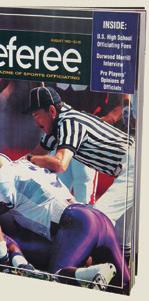
LEADERSHIP RESOURCES
Association Advantage Membership to Association Advantage provides officials, associations and their leaders the tools to conduct wellrun meetings, education resources for officiating training and access to years of association management articles. Member associations also receive 12 issues of
Referee magazine, monthly Advisor newsletters, Click e-newsletters, massive discounts on training materials and optional insurance coverage exclusive to membership. For additional membership information, contact Ken Koester at 262-632-5448 or visit the Association Advantage website at nasoadvantage.com.

EQUIPMENT/APPAREL

Purchase Officials
Supplies — Everything for Life Inside the Lines. Call 800-767-2233 or visit our website purchaseofficials. com for the best products and prices in the market.
Ump-Attire.com — The #1 website for officials’ sporting goods. Now serving free returns to go along with more brands, product
QUIZ ANSWERS
SOCCER
1 — All – c (NFHS 10-1-3c; NCAA AR 10.4.1.h; IFAB 13.1)
2 — All – a (NFHS 5-3-1d; NCAA 5.4.3; IFAB 5.3)
3 — All – b (NFHS 12-2; NCAA AR 5.6.3.c; IFAB 5.3)
4 — All – a, c (NFHS Penalty Kick Chart; NCAA 14.3.3; IFAB 14.2)
5 — All – b (NFHS 15-1-4; NCAA AR 15.2.g; IFAB 15.1)
BASEBALL
1 — NFHS – b (8-2-6j, 8.2.2J); NCAA – d (5-8e, 8-6b8); pro – c (5.09c4, 1st para.)
2 — All – c (NFHS 8-42k; NCAA 6-2e, 8-5k; pro 6.01a11)
3 — All – d (NFHS 8-28; NCAA 8-1c Note; pro 5.06a2)
4 — All – d (NFHS 8-3-3c3; NCAA 8-3o4 Note 2; pro 5.06b4G Cmt.)
FOOTBALL
1 — NFHS – a (9-4-3b); NCAA – d (9-2-1j, 9-2-6a, AR 9-2-1X)
2 — NFHS – e (No rule coverage); NCAA – c (9-2-1f)
3 — Both – b (NFHS 10-2-4; NCAA 10-1-1b)
4 — NFHS – b (3-4-2c, 3.4.2C); NCAA – a (3-3-2d8; 3-3-2f)
5 — NFHS – c (10-5-5); NCAA – a (9-1-9b)
SOFTBALL
1 — All – d (NFHS 8-6-20; NCAA 12.6.2; USA Softball 8-7v; USSSA 8-18r)
2 — All – b (NFHS 2-25; NCAA 11.5.1.8; USA Softball 1-Foul Ball; USSSA 1-Foul Tip Note)

3 — All – a (NFHS 8-813; NCAA 12.17.2.1.5.1, 12.17.2.6.9; USA Softball 8-8m; USSSA 8-18u)
4 — All – a (NFHS 2-1-12, 9-1-1; NCAA 6.2.2, 7.1.1.3, 12.8 Eff.; 12.10.14.1; USA Softball 8-7f, R/S 1-K; USSSA 4-2, 9-1b)
reviews, same-day shipping and world-class service.
Smitty Outlet Store
Visit the NEW Smitty Outlet Store featuring discontinued, factory seconds and individual slightly defective items at great prices. Go to smittyoutletstore.com to shop now!
TRAINING RESOURCES
Referee Training Center
— The largest library of officiating training materials in the world. Rules study, mechanics updates and materials on important topics can all be found in one location 24 hours a day, seven days a week, with sample chapters and video samples. Discover it all at store.referee.com.
FLASHBACK AUGUST
40 YEARS AGO … 1982
• AL umpire Lou DiMuro is killed after being struck by a car while walking near the Arlington, Texas, hotel being used by his umpiring crew for a series between the Chicago White Sox and Texas Rangers. According to local police, DiMuro was accidentally hit while trying to cross in the middle of the street outside the hotel. DiMuro, 50, joined the AL staff in 1963, and worked the 1969 and 1976 World Series.
30 YEARS AGO … 1992
VOLLEYBALL
1 — All – c (NFHS 8-21; NCAA 10.2.2; USAV 12.2.2.2)
2 — All – c (NFHS 5-41d; NCAA 19.2.3.5; USAV 23.2.5)
3 — All – b (NFHS 9-6-7a; NCAA 15.2.1; USAV 11.3.1)
4 — All – b (NFHS 9-6-3; NCAA 14.6.4.2; USAV 14.3)
5 — NFHS – a (NFHS 6-2-2, 10-4-3b); NCAA – c (6.1.2.3 Note, 8.5.2.2, 12.3.2.2); USAV – b (15.7b, 15.8)
BASKETBALL
1 — All – e (NFHS 9-7; NCAAM 9-9, AR 224; NCAAW 9-9, AR 264)
2 — All – a (NFHS 9-91, 9-9-3, 9.9.1D, 9.9.1G; NCAAM/W 9-12.4, 9-12.6, 9-12.7, 9-12.8, 9-12.10)
3 — NFHS – b (10-2-1e); NCAAM – c (10-4.1.l); NCAAW – c (10-12.3.k)
4 — All – d (NFHS 9-2-6; NCAAM/W 9-4.1.f)
MISSION
Referee is a magazine written from an officiating perspective, blending editorial credibility and business viability. It educates, challenges and inspires officials at the youth, recreational, high school, collegiate and professional levels in all sports, with an emphasis on baseball, basketball, football, soccer, softball and volleyball. Referee is the journal of record for officiating and takes informed positions on selected issues. The magazine provides a forum for its readers, facilitates the flow of information, raises public consciousness about officials’ roles and serves as a catalyst for improved officiating worldwide.


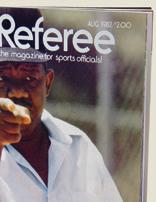
• Former NBA official Don Murphy suffers a fatal heart attack at the age of 61. Murphy officiated in the NBA from the 1962-63 season until March 17, 1979, when he had a heart attack while working a game in San Diego. He underwent triple-bypass surgery two weeks later and retired from officiating.
20 YEARS AGO … 2002

• NFL referee Bob McElwee is named the first recipient of the Art McNally Award. The award, named after the former NFL director of officiating, was created to recognize an official who has exhibited professionalism, leadership and commitment. McElwee was a 26-year veteran who had worked three Super Bowls and 18 playoff assignments at the time of his selection.

10 YEARS AGO … 2012
• MLB umpire Bob Davidson is given a one-game suspension following a blowup with Philadelphia Phillies manager Charlie Manuel, who was also suspended for one game for his role in the incident. According to MLB, Davidson’s suspension resulted from a “culmination of several incidents” and was not tied solely to the argument with Manuel.
REFEREE August 2022 | 81
Would You Hire You?
When the Texas high school football season came to an end, as usual, I sat and reflected. Not only did I reflect on the season my crew and I had, but I reflected on what I have seen and what I have heard from others. As I thought and reviewed film from previous games, I ran all my thoughts through the filter, “Would you hire you?”
Being honest with yourself is the first and most difficult step in this time of reflection and evaluation. I am sure I am like many officials;

— to officiate games. This process is not without controversy; however, I truly believe coaches select crews based on the crew’s ability to adjudicate the game fairly and consistently. This brings me back to my question, “Would you hire you?”
It is easy to sit in meetings and say you put in the time to study and review film, collaborate with other officials, and do all you can do to improve your knowledge, skills and abilities. But do you?
Time and time again I have heard fellow officials criticize others for having a better schedule, getting the big game or getting more games than anyone else. Some of these questions/criticisms may be valid, but first I ask those who criticize, “Do you honestly put in as much effort as those that get the ‘best’ assignments?”
Are there crews that get games that are above their head? Yes. Eventually, these crews will be exposed and assignments will begin to reflect the amount of work put in.
The student-athletes participating in our sport put in many hours of work to prepare for the contest we are working, and we owe it to them to be just as prepared. For this to happen we must continue to not only improve on our own knowledge, skills and abilities, but we must take an active part in improving the organizations to which we belong.
when walking off the field I have a gut feeling on whether I had a good game or if I kicked a call at some point. There are plays where I was certain I nailed it only to find out through film I was wrong.
And the flip side of that is also true — I got it right when I had an uneasy feeling at the time. Only through film review can you have these moments of reinforcement of the positives and opportunities to improve mistakes.
In the state of Texas, officials are independent contractors — selected by mutual agreement of the coaches
We must hold the leaders of our respective groups accountable. We must elect leaders who will be proactive in promoting mentorship programs for new officials, leaders who put into action the advice they give and leaders who are passionate.
We must give feedback on whatever new official development program exists. And if one doesn’t exist, start one.
It doesn’t matter whether you are a first-year official or in your 25th year, surround yourself with officials who have traits you aspire to have. Be comfortable with the
fact you will never stop learning, and keep challenging yourself in both your physical fitness as well as your knowledge of the rules and mechanics. To improve yourself and your association, you must enjoy being around the game and the people involved in the game. You must be humble and appreciate the fact there will be teachable moments throughout your career, and welcome these moments with open arms and an open mind. Be able to accept constructive criticism. Know the rules and be consistent in your judgment. You must understand the game isn’t about you — you are there to manage the game and keep it flowing.
It is my sincere hope all officials put in the effort to improve the art of officiating. I believe we are paid for more than our ability to cite or enforce a rule. We are paid for our judgment and our ability to discern when a foul rises to the level that it should be called. It is easy to be an armchair quarterback, find flaws in others and make negative comments in meetings and on social media. The tough part is putting in the effort it takes to elevate your game.
Remember, only you know truly how much time and effort you put into this worthy avocation. I ask everyone to put more effort into improving yourself, your crew and your chapter, and less into finding the fault of others. Be the mentor, be the “go-to” on rules, and be what we are supposed to be — professional. Be the official you would want to officiate your game if you were the coach and all was on the line.
Scotty Allen, Kilgore, Texas, has been a high school official for 30 years and an NCAA D-II and D-III official for 14 years. He is retired from the U.S. Army and currently manages a manufacturing facility.
Do
82 | REFEREE August 2022 LAST CALL A PERSONAL STORY BY SCOTTY ALLEN
you
have a personal officiating story to tell?
Send your story or queries to lastcall@referee.com
Being honest with yourself is the first and most difficult step in this time of reflection and evaluation.










































































 By George Demetriou
By George Demetriou































































 BY PETER JACKEL
BY PETER JACKEL




























 By Brad Tittrington
By Brad Tittrington

















































































































































































































































































 By Luke Modrovsky
By Luke Modrovsky
























































 By Tim Sloan
By Tim Sloan





















































 By Steven L. Tietz
By Steven L. Tietz










































